
[100] Ganja and Hess (1973, dir. Bill Gunn)
Manthia Diawara posits Melvin Van Peebles’s ‘Sweet Sweetback’ and Bill Gunn’s ‘Ganja and Hess’ as emblems of the two trajectories of U.S. Black Film in the 1970s: ‘Sweetback’ as Wright’s ‘Native Son’, ‘Ganja’ as Ellison’s ‘Invisible Man’. If ‘Sweetback’s genre approach channelled certain icons of rebellion—albeit along strongly masculinised and easily-commodified lines—‘Ganja’ represents a far more elliptical and experimental approach that uses the ostensible framework of genre cinema (the vampire movie) to probe anxieties, to present crises from multiple perspectives rather than resolving them through masculinised identification, and to maintain open form as a key principal of what might Black cinema might be. Butchered, re-edited and variously mangled over the years, it’s now possible to watch both Gunn’s intended version in all its avant-garde fascination and to compare the expository scenes shot but then removed from the final cut, only to be restored for the re-cut exploitation-movie version retitled ‘Blood Couple’. Watching these scenes only serves to emphasize just how strange and dream-like Gunn’s editing renders the final product: almost every deleted scene provides a piece of plot information that would contextualise and make narrative sense of the scenes we see in the final version as floating fragments, disconnected and elliptical fragments heavy with a symbolism that won’t fully reveal itself. The film indexes class tensions—Ganja marries up for financial security, has bourgeois pretensions, delights in lording it over a servant—while Hess sequesters himself away from society as such in a quasi-aristocratic mansion (the equivalent to Dracula’s castle), feeding on sex workers and intern/assistants, his class position as an academic anthropologist connecting both to occulted knowledges connected to African survivals—the remixed chants and flashbacks of ghostly African figures associated with the moments of possession and blood lust that constitute his vampirism—to a class parasitism that’s also ambiguously positioned in relation to myths of African savagery and their Afrocentric challenge (or reclamation). Drug addiction forms another layer in these swarms of symbolic parallel, along with the collective ecstasy of the church, depicted in an astonishing, documentary-style sequence that Spike Lee’s staged re-enactment for the mediocre remake, ‘Da Sweet Blood of Jesus’, comes nowhere close to matching. Ultimately, Ganja achieves an ambiguous independence, the men in her life both finding it impossible to reconcile themselves to the contradictions they live through: Hess’s climactic, guilt-ridden repentance and self-annihilation through subjecting himself to the shadow of the cross form a parallel to the earlier suicidal ideation of Ganja’s estranged husband (Gunn himself) for whom the demands of art and the torments of racial expectation form a deadly cocktail, while Ganja herself chooses to live as a vampire, eyeing the naked young man who dashes in slow motion over Hess’s corpse and then facing the camera in a series of jump-cut shots in which her facial expressions seem to freeze, then compose themselves, ending in an ambiguous smile that seems at once intensely melancholic and imbued with a conspiratorial satisfaction: power at what cost? In a society predicated on vampiric economic forms, entangled in the social processes of gendering and racialisation, along with projections and imaginations of historical origin (the African past), this conclusion comes to seem both a kind of victory and the ultimate capitulation. Gunn won’t let us read it any one way, and the film remains exceptionally rich: a reinvention of the vampire film—of the horror film per se—as a key work of Black American experimental cinema; as a meditation on desire, art, power and exploitation; as a beautiful and frightening fever dream as Ellison’s invisible man in his basement, and in many ways stranger.

99) Losing Ground (1982, dir. Kathleen Collins)
‘Losing Ground’ highlights gender and racialisation whilst refusing to be a message movie, according its subjects the same reflective possibilities the familiar white bourgeoisie of Euro-American art cinema. Shot in burnished colour, Collins’ film is visually stylish without being either tragic or comforting, to catch the ebb and flow of conversation without being tied to realism. Married to a philandering painter (Bill Gunn), Sara Rogers (Seret Scott) is a philosophy professor whose dedication to the life of the mind—both hard-won in terms of both gender and race, and a kind of protective screen against the vulnerability to which she might otherwise be subjected—comes up against the suggestion of alternative experience through her research into ecstatic experience and her attraction to the older movie star (Duane Jones), with whom she’s starring in an experimental short film. (Gunn and Jones—the latter most famous for ‘Night of the Living Dead’, the former a maverick and mistreated director—both memorably appear in Gunn’s own ‘Ganja and Hess’, and their presence is an important part of the film.) The competing—or apparently competing—tendencies Rogers perceives in herself come to be partially figured through the abstracted narratives of the short film itself, a take on the ‘tragic mulatta’ narrative (via an allusion to ‘The Scar of Shame’) which at once reinforces the connection of death, forbidden desire, and racial stereotype, and, in its production, suggests ways of integrating art, the sensual and the intellectual that Rogers has previously denied herself. Meanwhile, affected by Victor’s latest affair, Rogers feels herself unmoored—losing ground, as the film’s title has it—in a manner that at once suggests possibilities and the shaky walkway on which she’s constructed her way of being in the world. The film ends in a kind of parody of resolution—the fatal shooting that ends the short film observed by Victor as Sara breaks down, the boundaries of performance, identification and control breaking down. This is not a film that tries to tie up its loose ends or resolve its dilemmas, and all the better for it.

[98] Nothing But a Man (1964, dir. Michael Roemer)
Ivan Dixon plays the good-hearted but troubled railroad worker who falls for, and marries, the preacher’s daughter, their attempts to build a life disrupted by his failure to hold down a job—effectively blacklisted when he starts attempting to organise his fellow workers—and the tensions of class differentials and the climate of racist surveillance and gendered expectations. Dixon’s wife is played by Abbey Lincoln, then in the process of challenging the images for which she was being prepared—the chanteuse-siren or the tragic jazz singer—having been involved in political activism and recorded some of the most important political jazz albums of the decade. Here, her performance is unaffected, subtle and moving. Dixon and Lincoln reconcile by the film’s end, though whether or not they’ll make it is open to question, and his lashing out in an incident of domestic violence offers a disturbing shift in register that can’t be driven from memory by the ostensibly ‘happy ending’. Throughout, the film doesn’t romanticise, editorialise, or patronize—quite remarkable, given its white directors—and, as such, it stands as one of the finest early examples of what—with some qualifications—we might call ‘Black Cinema’. (David C. Wall and Michael T. Martin provide a useful consideration in their essay ‘Nothing But a Man and the Question of Black Film’). This is a film that displays love and intimacy in ways that go well beyond cliché, yet which refuses to reassure. No wonder Malcolm X was a fan.
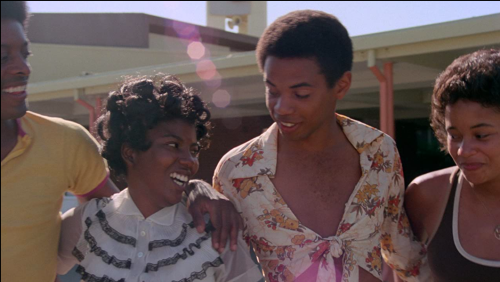
[97] Emma Mae (1976, dir. Jamaa Fanaka)
Jamaa Fanaka would soon take the L.A. rebellion down the blaxploitation road others rejected—‘Welcome Home Brother Charles’ as perhaps the most extreme depiction of the myth of black male hyper-sexuality seen in film, whether as intentional or unintentional satire—but ‘Emma Mae’ is a subtle and personable film that eludes any of the generic categories placed on it in its marketing (the re-edited version as ‘Black Sister’s Revenge’ is a particularly egregious case). Its titular heroine comes to the big city as a naïve ‘country girl’, falls in with a drug dealer who goes to prison after resisting the cops, goes on the run herself, starts schemes to get him out of jail—schemes that appear to borrow from genre pictures (the car-wash from the teen movie and the bank robbery from the heist movie)—and finally leaves him after he reveals himself to be the cheating egotist we’ve always suspected him to be upon release. The plot can be somewhat wobbly—particularly given those generic lurches, and characters who never quite seem fully integrated, like the elder Black Nationalist who serves as mentor to this group of teenagers for reasons that are never quite clear—and for what is a conventional narrative film, it can occasionally become derailed or unstuck. Yet, in the main, it successfully negotiates the traps of stereotype—imbricated as they are with the pressures of genre film-making and the exploitation of suddenly marketable modes of Black identity. Above all, it’s distinguished above all by the performance of these actors, none of whom are well-known, and its sympathetic portrayal of Emma Mae herself—at once naïve and nobody’s fool, a refreshing depiction of a protagonist who is neither idealised nor demonised, and who ultimately comes through accepted as part of a group yet refusing to compromise herself.

[96] Portrait of Jason (1967, dir. Shirley Clarke)
Shirley Clarke’s entire cinematic output engages with displacements of otherness—as a rare female filmmaker in an intensely masculine world, as Jewish, as a bohemian, she chose to depict another marginalised community—that of Black life in New York in ways that identify and displace in troubling fashion. Clarke’s films were undoubtedly pioneering in terms of both form and subject matter. While ‘The Cool World’ attempted to marry its documentary strands with more conventional bounds of the melodrama, to mixed success, the more experimental ‘The Connection’ had more explicitly engaged with the strained relation between the bohemian filmmaker and the Black working class subjects they depicted and exploited (in the case of that film, jazz musicians waiting for a fix). ‘Portrait of Jason’ goes further yet, both in its status as documentary—the camera rolls on its subject, the queer performer Jason Holliday as he’s interviewed off-camera by Clarke and her (Black) partner Carl Lee—and the uncomfortable exposeé both of its subject’s and its own motivations. Holliday is a hustler, a performer—these are modes of survival. Clarke’s and Lee’s demands that he ‘tell the truth’ and ‘reveal himself’—that he perform the role of the tragic or manipulative gay man—try to break down the very performance they encourage. Holliday, of course, understand that it’s all performance—as when he performs the role of the subservient servant to his white employees, or hustles for drinks and love, he can’t afford to let the mask slip. Drunken vulnerability, tears and apologies are thus their own performances. Clarke demands that Holliday suffer, then tells him that he’s not suffering. More tears, more stories: “what else ya got?” Holliday is celebrated as trickster, as purveyor of cool, as exotic sexual deviant, yet his sexuality is threatening to Lee, his race an object of complex curiosity to Clarke: both of them appear to find Holliday threatening and fascinating in equal measure, and the images we see on screen appear to wrestle with this sense of disgust and love (a love which Clarke says only came through in the editing, the filmmaking at the time approaching an act of revenge for things Holliday had done, or was perceived to have done to hurt her and Lee). The film comes to seem like a struggle between Holliday—on-screen—and Clarke and Lee—off-screen. It’s unclear, by the end, how the power relations have shifted, who has ‘won’, what we’ve learned. Is Holliday’s image his own, or has it been stolen by Clarke? Has he turned the tables or is he defeated and exposed? Rarely is the struggle for authorship of a film laid bare. But then again, rarely are films—‘documentary’ or otherwise—so stripped-down in their conception and execution: every frame contested, raw and troubling.
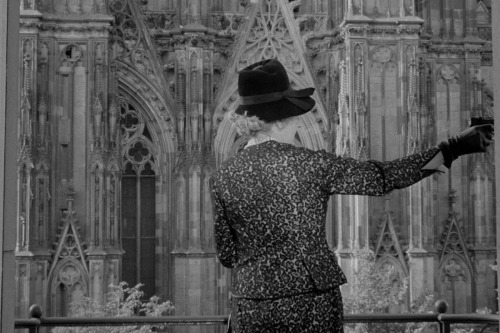
[95] Not Reconciled; or, Only Violence Helps Where Violence Rules (Straub-Huillet, 1965)
A miracle of editing, this trumps Resnais’ ‘Muriel’ for the speed and concision of its shot sequences, turning a reasonably straightforward, if sprawling story of three generations of a German family during the two world wars into a labyrinth of detail, equivalence and juxtaposition that demands total attention from its audience at every moment. As well as making its point about the recurrences of history, and, above all, the return of Fascist politics under gentler guises made in more condensed form in ‘Machorka-Muff’, this model of the engaged spectator will form the basis for the recitations and tableaux of their subsequent career. Both elements–the extreme speed of editing and the reduction of ‘cinematic’ technique (editing, camera movement, and so on)–are not so much opposites as different ways of modelling such attention and reflecting on historical equivalences and gaps, often through the prism of literary texts (here, as in ‘Machorka’, a work by a Heinrich Boll). These two early films further suggest that political rage and analytical clarity are by no means opposite forces, as they’re so often portrayed. As the film’s title suggests, reason and human dignity are on the side of the elderly woman who tries to shoot a politician, rather than on any gestures of placatory moderation and reconciliation, and this refusal of reconciliation happens on the level of cinematic form as well as narrative. Still challenging and vital.

[94] Machorka-Muff (1963, dir. Straub-Huillet)
Very early Straub-Huillet, still within the bounds of the fiction film, with an incisive, bitterly satirical portrait of a former Nazi officer inaugurating a military memorial that will rehabilitate his former superior and open a new military academy in its grand tradition. Close-ups of the newspaper he reads at a cafe lay out the context of re-militarisation in Adenauer’s West Germany–dream sequences in which the officer appears to unveil numerous copies of himself attest to his egomania, perfectly of a piece with the masculinist, nationalist cult that barely even attempts to hide its continuities with Nazism. Machorka-Muff is also a self-confident philanderer, moving on to his sixth marriage–an aristocratic match–and admiring himself in the mirror with narcissistic delight. ‘An abstract visual dream, not a story’, proclaims the preface, and the fetishistic attention to detail that characterises both Muff’s military ‘propriety’ and the way that the screen is split into precisely co-ordinated fragments of the larger whole anticipate the intensely swift editing of ‘Not Reconciled’ at a slower pace. As effective a warning against the after-effects of Fascism as any. ‘Will the public swallow it?’ wonders an interlocutor about the unveiling. The answer is instant and absolutely self-confident. ‘The public swallows everything’. The film challenges its audience to prove otherwise.

[93] Prima della Rivoluzione / Before the Revolution (1964, dir. Bernardo Bertolucci)
Bertolucci’s psycho-sexual obsessions have always seemed a strange fit with his concern with revolutionary politics: the one transplanted onto the other, but the two so imbricated within the films themselves that the substance beneath the undeniable style can be hard to discern. Here, it’s incest–apparently as reaction to a homoerotically-tinged friendship with a young Communist–that provides an outlet for the self-hating young bourgeoisie who ultimately settles for his position in society, marrying his normative girlfriend and taking the career path expected of him. If Pasolini–for all the faults in his exploitative relationship to the young men of the subproletariat–has come, by ‘Salo’ at the very least, to articulate a theory of the interactions between sexuality, consumerism and the shifting mores of Italian society, one that can take account of the defeat, through incorporation, of the sexual revolution, Bertolucci’s obsessions are both more ‘accessibly’ filmed and less articulate. Bertolucci’s preoccupation with homosexuality–which he seems to regard with both openness and fascinated horror, thus here places left-wing political comradeship and homoerotic attraction as something like equivalents, yet in the later ‘ll Conformista’, he implies that such attraction is also in some ways tied to sadistic Fascist constructions of masculinity. Might the disillusioned bourgeois of ‘Before the Revolution’ have become the complicit conformist of the later film? We might well entertain the possibility. As it stands, the film is somewhere between an incisive self-critique of the bourgeoisie and a confused projection of sex onto politics that provides analysis neither of the politics of sex nor the sex of politics.
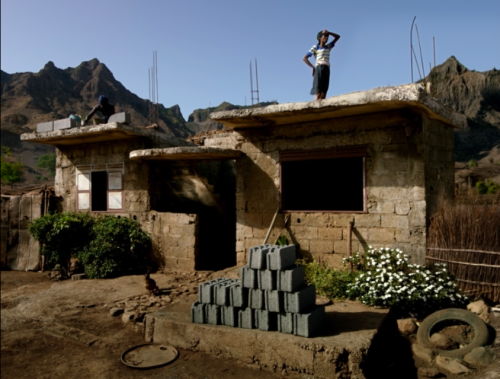
[92] Vitalina Varela (2019, dir. Pedro Costa)
Costa moves from the implications of elements of his previous films—the stories told by Vitalina Varela, first presented as a kind of cameo in ‘Horse Money’—as part of a kind of daisy chain link, a gauzy web of connections etched in shadow, the vagaries of memory, the whispered incantations of repeated tales, which makes viewing the films, as each new work supplements, perhaps even contradicts the last, impossible not to project back on the former in the light of the latter. Abandoned by her husband in Cape Verda, Vitalina comes to Lisbon for his funeral—which she missed by several days—and resolves to stay in his shack as a virtual recluse. The film once more concentrates on loss—the failure of a love relationship—and the fractured interactions that constitute the social environment in which the one left alone finds themselves, yet, once more, these are to an extent mitigated by acts of communal support. Yet Vitalina’s gendered critique—directed to a priest played, once more by Ventura—suggests that such support may benefit from patriarchal networks (as ‘papa’, after all, Ventura incarnates the patriarch). Vitalina condemns the priest played by Ventura for the pity he dispenses to the husband who abandoned her in Cape Verde, and who died alone in Lisbon: “Men favour men. When you see a woman’s face in the coffin, you can’t imagine her suffering.” Costa notes that, in real life, when Vitalina first came to Lisbon after he husband’s death, she was left alone in her deceased husband’s shack for days. ‘Vitalina’ closes with a flashback: Joaquim and Vitalina building their house together in Cape Verde, before Joaquim left for Portugal. ‘Vitalina’ is a film which has so often been about close-ups of faces and cramped spaces, yet Costa sets up this shot, a moment of intimacy which might traditionally be shot with a closer focus from a distance. Viewed from longshot, we cannot hear and can barely see the couple’s interaction. We might note here Vitalina’s gendered labour—carrying a brick on her head up to the roof where her bricklayer husband applies the cement—and her gesture of affection—putting her arm around Joaquim—which appears to be rebuffed, as she goes and stands on the far side of the roof, looking out to sea (Costa has described the Cape Verdean women left behind as ‘sentinels’). At the same time, one could read the Cape Verde flashback in combination with the moment when Joaquim’s friends visit Vitalina, coming together to fix the leaking roof of the shack. Even if all these relations tend to fall apart, they are at least attempts at working together to ease poverty and loneliness. One of Joaquin’s friends recalls their meeting in prison, the development of their connection: yes, we’re all shits and we cheat and lie, both to others and each other, but we also look out for each other. As in ‘Colossal Youth’ and ‘Horse Money’, this open ending can be either as affirmations of hope and possibility—from the darkness to the light, literally in the case of ‘Vitalina,’ which moves from the shadowy world of present-day Lisbon to a sun-lit flashback to her Cape Verdean past—or reaffirmations of existential misery. Rather, like the ‘sentinel’, these films pay witness and keep watch.
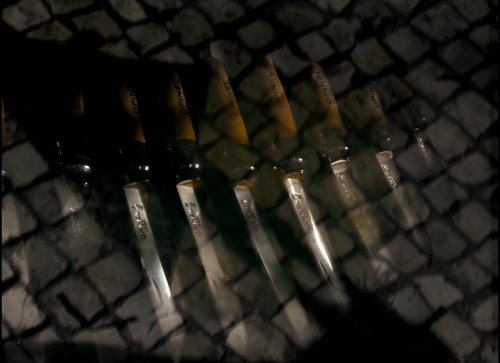
[91] Cavalo Dinheiro / Horse Money (2014, dir. Pedro Costa)
It’s impossible not to read Costa’s Fontainhas films in dialogue: to see ‘Colossal Youth’ without then seeing how its concerns morphs into ‘Horse Money’ and ‘Vitalina Varela’. Both taken together and separately, and in large part through their intensely collaborative nature, Costa’s films create a community that acknowledges, rather than attempting to suppress, fracture, loss and separation. The community of Cape Verdean migrants are subject to workplace accident, suicide, the pain and indifference of hospitals and welfare offices and other bureaucratic spaces which promise only mere survival, often accompanied with the threat of punitive discrimination, surveillance, exclusion and deportation; it’s this background that takes centre stage in ‘Horse Money’. The performers here tell both their own stories and those of others, and in which events are re-staged, either verbally or in ghostly, symbolised recreation, in ways that render them more, rather than less, ambiguous. This is a film about loss: a loss might equally be tied to the breakdown of domestic relationships, the ravages of addiction and poverty, or the political circumstances of a coup d’etat, of metropolitan racism, or the failure of decolonial revolution. ‘Horse Money’ seems to suggest this as something approaching existential condition: visiting Ventura in a hospital, a compatriot opines: “We’ll keep on falling from the third floor. We’ll keep on being severed by the machines. Our head and lungs will still hurt the same … We’ll be burned … We’ll go crazy … We always lived and died this way … This is our sickness.” Yet this class-specific experience is linked to specific, if haunted, spaces associated with the repressive or ‘benevolent’ aspects of State power—hospitals, prisons, offices (in which a worker might symbolically wait for their salary for 20 years), factories in which a worker’s guts are spilled by machines, documents which grant the bearer the rights of protection and subsistence and are constantly shuffled, displayed, inspected, held to under the surveillance and monitoring of the state. Stuck in the elevator, endlessly between floors, or the subterranean corridors of a building that’s at once hospital, prison and asylum, the film takes place in an endless nocturnal limbo. Yet, even within this nightmare world, there are also moments collective care than those of the State’s bureaucratic apparatus, the classist and racist indifference that extends or withholds housing, food, money to the bare minimum, that replaces outright racist hostility and violence with slow, rather than fast death. Costa describes his film as acts of ‘revenge’ against the Portugese state on the behalf of immigrant populations who are ‘doomed’ from the moment they set foot on a plane. But whose revenge? And what is the relation of revenge to hope? As the film ends, Ventura leaves the hospital: the camera lingers on a set of knives in a window, harking back to his story of injury in a knife fight. Tool of self-defense, index of trauma, or symbolic fight in the war of the oppressed? Perhaps all three.

[90] Juventude Em Marcha [Lit. ‘Youth on the March’] / Colossal Youth (2006, dir. Pedro Costa)
The English language title to the film does not provide a literal equivalent to the Portugese original–’Juventude Em Marcha’–a decision that apparently originates with its director, who likewise translates ‘Cavalo Dineiro’ as ‘Horse Money’ (rather than the more literal alternatives such as ‘A Horse Named Money’). While the English title emphasizes scale, a cultural reference point beyond the specific locus of the Cape Verdean immigrant community on which it focuses, and thus a point of access for European audiences mystified by this underrepresented world, the Portugese has a specific valence it’s useful to consider: a revolutionary slogan from the Cape Verdean independence movement, it renders youth as mass or class rather than the English language suggestion of youth as property or thing, designated by adjective rather than verb, suggesting something static (a statue, a colossus) rather than action, activity, movement. As such, it loses the contrast, central to this and to Costa’s other Fontainhas films, between the revolutionary hopes associated with youth and with decolonisation as they fade with time, with ageing, with loss of various kinds, with the effects of workplace discrimination, industrial accident, drug use, housing precarity, the failure of the metropole or the colony to usher in the new era promised by the end of Fascist dictatorship and its rule at home and abroad. Movements or moments that might have seemed at the centre of things—the decolonising moment’s contribution to changing the course of world history, the beginning of a new life for Cape Verdean migrants to Lisbon (Costa likens them to ‘pioneers’)—retreat once more to the condition of the marginal, the marginalised, the cast-off and discarded, to conditions of loss both metaphorical and literal: the Fontainhas neighborhood literally razed as the film was shot; or performers from previous films who had died by the time the next film was to be made. In ‘Colossal Youth’, we follow Ventura—a Cape Verdean migrant labourer whose arrival in Madrid coincided with the racist gangs whose targeting of migrants rendered the Carnation Revolution a very difference experience to that of middle-class whites such as Costa. In recreations of those moments—though they’re not immediately identified or obvious as such—Ventura and his friend Lento sit in the protective shack they’ve built, listening on a scratchy portable turntable, to Cape Verdean band Os Tubarões’ song ‘Labanta Braço’, a jubilatory celebration of independence in Cape Verdean creole which urges its listeners “Grita, viva Cabral” (‘Let’s cry out, Viva Cabral’). (Ventura will later sing this song, a capella, at a dinner with one of his ‘daughters’, having told the story of how he met his wife, finally seducing after he mocked her singing at a Cape Verdean independence celebration and she playfully hit him over the head with a flagpole.) The first time we hear the song, lines skip and repeat as Lento compulsively scratches the table on which the turntable has been placed with a pen, before Ventura gently stills his hand, holding it in a gesture of pacification and comradely friendship—later repeated when he holds hands with present-day Lento in a burned-out apartment and recalls the great fear of death they both had in the 1970s, hiding in the shack, subject to workplace accidents (Ventura, may indeed, have died in the 1970s and appear in the present as a ghost.) This gesture cuts across the time-frame. Ventura is no saviour—he’s more in search of salvation himself—but in this moment, reaching across time and towards another, he suggests the mutual embrace of solidarity and survival for those brought sometimes daily, face-to-face with death: those who might be best understood, not as the victims of capitalism, but its survivors. It’s through Tubarões’ recorded invocations of Cabral—and Ventura’s a capella repetitions of them—that Colossal Youth manages to convey the ghostly, unfulfilled past imaginings of a viable collective future that were still, in the early 1970s, a possibility: in the skipping, diegetic transmission of ‘Labanta Braço’ , that the ghosts of unfulfilled revolutionary promise are transmitted. Hiding from white supremacist police violence in the midst of a revolution that, for whites, promised a more general liberation, it’s Os Tubarões’ music that maintains (in both sense of that verb) the presence of Cabral’s drawn-out revolution in the colonies–a revolution that, as Cedric Robinson notes, precipitated the Portugese domestic revolution in dialectical fashion. The imperfect transmissions of a tinny recording; are containers for that which is not realised, the personal dreams of romantic fulfilment, the political dreams of Cabralism, of unity and liberty from imperial domination, from the far consequences of underdevelopment that extend far beyond nominal independence, or of immigrant integration into an apparently democratised metropole. It’s in these moments that the ghosts of leftist movements against political tyranny survive; in the catachrestic non-sequitur of skipping records, unanswered letters, unfinished revolutions, nascent worlds yet to be.
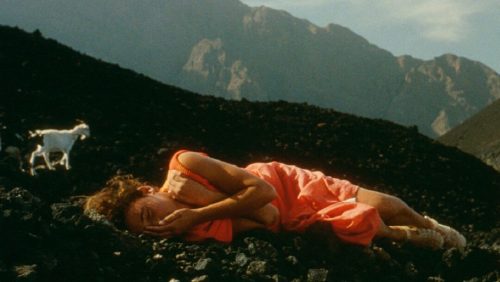
[89] Casa de Lava [Lit. ‘House of Lava’] / Down to Earth (1994, dir. Pedro Costa)
It was thanks to the filming of ‘Casa’ that Costa’s experience of encountering Cape Verdean migrants—relatives of those he met in Cape Verde, to whom he delivered letters on his return— radically changed his approach. Rather than the sympathetic colonial/leftist filmmaker travelling abroad, the director looks within: and rather than casting national narratives within the framework of fiction, embraces a collaborative approach shaped by the stories of non-professional actors themselves. Costa may be the public voice of these films; may be the one who puts them together, who frames them; yet without his performers, the films would not exist. This is more than the usual testimony to the power of the actor, shaping an already conceived storyline, script or conceptual frame, but the shaping of those elements by the performers themselves, a blending of realit(ies) that refuses the roles of subject-object, of documentary or fictional framing, but blends these roles in a more complexly collaborative fashion. That was to come, though. What of ‘Casa de Lava’ itself? Shot on Cape Verde itself, the film features a conventional—if ambiguous, stretched and dreamlike—narrative and the performances of professional actors, focusing on the figure of a white nurse (the Cape Verdean charge she accompanies literally mute), mediated through the intertextual references to Tourneur’s ‘I walked with a Zombie’ (itself the product of various racist myths concerning voodoo practice). It boasts compelling performance from Isaach De Bankolé as the patient—compelling even when reduced to a quasi-zombified state—and a hauntingly strange atmosphere, drawing in large part on the bleak power of landscape, something of an additional performer in the film. Impossible to tell how this film would seem without the knowledge of Costa’s subsequent work: one might say that Costa himself reduced it a footnote in his own career, as the question to which his later films provided the answer.
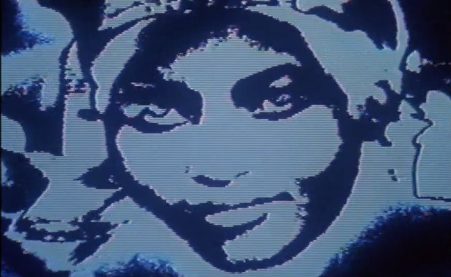
[88] Sans Soleil / Sunless (1983, dir. Chris Marker)
The key question, beyond revolutionary romanticism, is what happens after independence, Chris Marker wrote of Cape Verde when assembling for ‘Sans Soleil’ footage shot during the Angolan and Guinea-Bissaun independence struggle of the 1970s. For Marker, Cape Verde served as a potent figure for points of access, of entry or exit. Located in the central Atlantic ocean, and inhabited only upon discovery by Portugese explorers in the 15th century, it was the first European settlement in the tropics, and a key stopping point during the Atlantic slave trade, and its independence struggles during the era of decolonisation—along with its innovative linkage with the struggle in Guinea-Bissau, spearheaded by Amilcar Cabral—suggested new ways in which internationalism might be incorporated into a praxis of liberation. Likewise, the efforts of the Guinean filmmakers suggests what Cesar calls “the promise of a militant cinema of emancipation, born from the struggle as a praxis of liberation”. Yet in ‘Sans Soleil’, the Guinean archival footage, along with Marker’s images of Cape Verde, serve as indices of failed hopes, of the failure of both political struggle and the aesthetics of what he calls ‘revolutionary romanticism’ which invests in that struggle a hope for the future of the world. Over footage of Cape Verdean ports, queues at stores and labour on building sites or market places, Marker’s narrator comments: ‘Rumor has it that every third world leader coined the same phrase the morning after independence: “Now the real problems start.” Cabral never got a chance to say it: he was assassinated first. But the problems started, and went on, and are still going on. Rather unexciting problems for revolutionary romanticism: to work, to produce, to distribute, to overcome postwar exhaustion, temptations of power and privilege.’ Originally planning to make a film along the lines of the agitational, collective work developed with the SLON and ISKRA groups, Marker subsequently reshaped footage shot through the 1960s and 1970s into a video-essay meditation as much on his own role as on the broader narratives of which his footage provides a slice: a meditation on memory and on ways of narrating history, rather than that narrative itself. Including the footage shot by the Guinean filmmakers—Cabral embracing fighters, shaky black and white images that appear to be shot from within guerrilla conflict—Marker presents a doubly-lost moment of possibility, in which the documentation of African independence struggles by African filmmakers both fail. “Who remembers all that?” asks Marker’s narrator at one point, referring to the Cape Verdean-Guinean liberation struggle. “History throws its empty bottles out of the window”. Much of this filmmaking activity was lost when cannisters of film were thrown into the street during the civil war at some point in the 1990s. As Marker notes, hearing the stories of the sheer hell of such guerrilla warfare makes a mockery of those who described theirs as ‘guerrilla filmmaking’. If, at one stage Marker travelled the globe, documenting the revolution, documenting new modes of living–in footage that was, as in his early film on Cuba, often banned within Euro-American contexts–and emphasizing film-making as a collective process, later films like ‘Sans Soleil’ take the very same footage as the basis for the melancholic reflections which have as their overarching theme the failure of global transformation promised by radical movements in Europe and Third World struggles in Europe’s colonial ‘possessions’. The out-of-time nature of that footage, material to be re-inscribed, alternately written over or uncovered in a kind of politicised Proustianism, a palimpsestic reflection on defeat, needs as its corollary Marker’s science-fiction image of the future traveller, the traveller from the year AD 4000 in which earth has become a world of total recall, viewing with compassion the sadness mixed with aesthetic pleasure–the forms of art, of cinema, the failures of memory and desire. Noting the problematics of the gaze he projects onto the Cape Verdean women he films until they cast their gaze back at the camera, Marker ends his film on the image of the Cape Verdean woman who locks eyes with the camera for a fraction of a second–the exact length of a frame of film–Marker appears to hold this out as a possibility, if not of mutual contact, of the resistance to objecthood, and the possibility of a self-creation that would not need the mediation of the white, male filmmaker, world-traveller, revolutionary romanticist. Yet, as with much of the footage in the film, Marker feeds these images into the image-synthesizer of the (fictional) Japanese artist Hayao Yamanoko, producing solarised, distorted images that distort and transpose their sources into blotches of irreal colour and indistinct, amorphous forms. Feeding the footage into the machine serves as a surreal analogy for the mediations that exist between filmmaker and object, the problems of colonial framing, and the vagaries of historical memory, that are Marker’s subject. The returned gaze, the flicker of tacit acknowledgment of performance, suggests the possibility of an artistic response–to frame oneself, rather than to be the always-framed—a fragile, yet vital force against the power imbalances of a ‘world cinema’ whose legacies are still firmly rooted in colonial power relations.

[87] Glauber O Filme, Laborinto do Brasil / Glauber the Film, Labyrinth of Brazil (2003, dir. Silvio Tendler)
This documentary centres around footage of Rocha’s funeral, with the conceit of Rocha’s life and work as a ‘labyrinth’ that mirrors that of Brazilian politics and culture—the labyrinth in question rendered in cheesy computer graphics that pale in comparison to the technical means of Rocha’s films. As such, it places personal legend—easily encouraged by Rocha’s larger than life personality—over the specifics of his films, though there’s sometimes useful information from the talking heads. Probably neither the best introduction to Rocha’s work nor a particular in-depth or satisfying experience for those who know it better—but perhaps that mid-range is what it’s after. That said, any reduction of the wild cinematic ‘poetry’ of Rocha’s films to the ‘prosaic’ form of the talking-head documentary is going to entail an unavoidable reduction, and the labyrinth conceit is at least imaginative. And certainly, it’ still a vital resource those interested in Rocha’s work—particularly given the difficulty of getting hold of the other major Glauber documentaries such ‘Anabazys’, directed by his daughter Paloma focusing on ‘O Idade do Terra’.
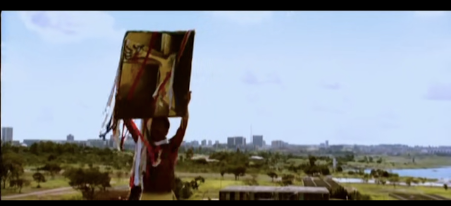
[86] A Idade do Terra / The Age of the Earth (1980, dir. Glauber Rocha)
Given the difficulties he faced in assembling money to make films, and the obscurity of those he did manage to make, Rocha’s outspoken media presence had been his major role since 1969 at least, and it now entered into the films. This is a key weakness: a kind of egoic messianism, losing more and more political sense as he praised military dictators, with scenarios for ambitious films which could, in all likelihood, never be made. Both epic summation of Rocha’s career and an incoherent end-of-the-line, ‘A Idade’ is like almost nothing else in cinema. We find one more the allegorical figures whose interactions are epic and poetic rather than realist, though we’re also presented with near-documentary scenes, interviews and chaotic, seemingly improvised moments which appear closer to performance art (or, to be less kind, amateur theatre). Rocha claimed that the reels of the film could be shown in any order—history as linear order is firmly rejected for the repetitions and non-sequiturs that are held in place by mythic overlays which at the same time provide the fulfilment and solution to history. Is this a mystical escape from reality, the result of political impasse? Absolutely. But at times it’s no less breath-taking for that. The allegorical forces this time are four ‘Christs’ who are also the four horsemen of the apocalypse, St George, and so on, and their female counterparts—Aurora (sunrise is an important figure for the film), Magdalena, the queen of the Amazons. A businessman-imperialist, the hulking and Aryan ‘John Brahms’ staggers through the city in hysterical displays of sadistic power. These figures move around in public spaces in sequences that appear improvised, shot amongst traffic or in crowd scenes with puzzled onlookers, or in cramped interiors with Rocha’s own voice shouting offscreen at the actors to scream their lines ‘ten times louder’. Rocha further destabilises time by often including multiple takes of the same lines, repeated as many as five times—the ‘military Christ’ sitting in front of a café and proclaiming that, even if he uses violence and ignores human rights, he upholds essential ‘spiritual’ rights—and what would appear to be ‘outtakes’—Brahms collapsing and apologising to Glauber for his weaknesss; Rocha’s infant daughter banging at a piano. The shifting alliances of the film’s allegorical figures, in their gendered pairings and their various speeches, provide uneasy mapping of betrayal, power and, at times, possibility. The gringo imperialist, Brahms, appears perpetually on the verge of collapse, yet that collapse never comes: political stasis is the overwhelming feel, despite the surge of action and event and the promises to provide a more democratic future Brazil, couched in the language of mystical, syncretic Christianity. This is a paradoxical teleology without end in its interchangeable reels, the film can have no conclusion. In what is probably the film’s key sequence, Rocha yells out an incoherent voiceover speech to footage of the ‘Black Christ’ as St George, holding aloft a garish Expressionist icon of the crucified Christ, in which he claims the ultimate political ambition should be to defeat death itself. Rocha’s voiceover—which, in its halting pauses and streams of language, sounds improvised rather than scripted—explains the genesis of the film as a life of Christ inspired by Pasolini’s murder. Pasolini serves as the corpse from which a new, third world Christ can emerge, as Rocha preaches an incoherent political gospel in which a transformed Christianity serves as the beacon of global hope, along with a vision of Brazilian ‘democracy’ that functions beyond ‘capitalism, socialism, communism’. This utopian, ultimately nonsensical vision—which also claims that the ultimate political ambition must be to defeat death itself—has to be expressed in manifesto-like words in order to give some coherence to what see onscreen, even as the film itself seeks for a visual ‘trance’ based on fragments of language, overwhelming and jarringly intercut blasts of sound, from Villa Lobos to carnival music and improvised free jazz, that rejects the cohesion Rocha’s speech seeks to impose. The whole film is a total blaze of overkill—too loud, too long, with the maximum of excess as fundamental methodogical starting point—that cannot and does not end. Ismail Xavier call this the limits of national allegory as methodology—while apparently mythic structure presented in Rocha’s previous films is ultimately grounded in a historical basis, it fails when it comes to the present of the 1980s, of a decade lived under military dictatorship. Rocha in essence admits as such in his voiceover description of the utopian city project of Brasilia, an analogy, it would seem, for his own film: “strong irradiation, light of the Third World, a metaphor that doesn’t come true in history, but meets a feeling of greatness, the vision of paradise”. This is a matter of faith: but faith, while it might at times seem the only possible way to survive a dictatorship with no end in sight, is hardly adequate on its own. Unable to account for the profusion of elements brought into the audience’s view, ‘A Idade’ asserts the positive force of Brazilian syncretism against the violence embedded in its history and as a way beyond the crippling underdevelopment fostered by American imperial interests in the region. But this nationalism—even if it seeks to counter the mendacious nationalisms of religious and military power—ultimately cannot see a way out of them, falling prey to a disunited model of national unity that veers near to complicity with the repressive forces that governed the nation, against which Glauber might at times have staked his life.
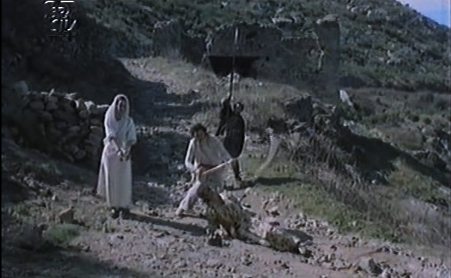

[85] Cabezas Cortadas / Cutting Heads (1970, dir. Glauber Rocha)
The more Glauber Rocha talked about cinema, polemicizing in the pages of Brazilian and European film journals throughout the 1970s, the less well-received were his actual films. His European-made films, in particular, are very rarely discussed in any detail in English language criticism, and almost never seen more widely. ‘Cabezas’ may be one of the most obscure. In some ways reminiscent of the Pasolini of ‘Porcile’ and ‘Teorema’—in its casting of Pierre Clementi, in its bleak Mediterranean landscape, and its staging of a drama engaging with syncretic mythology—it also seeks—as did Pasolini’s ‘Medea’ and ‘Oedipus’—to examine and counter the focus on tragedy with the Greco-European tradition. In ‘Der Leone’, the violence undertaken by allegorical figures was a clear parallel to Third World revolutionary struggle; here, it forms a kind of mythic overlay which at once suggests revolution and king-killing, while focusing on pagan figurations of death and rebirth, of cyclical renewal. Shakespeare’s Macbeth—a key study in political power and the transition from feudalism—is used to suggest the dynastic drama through which exiled dictator Porforio Diaz—at once Juan Peron, Batista, and Franco—understands his own role. Macbeth-Diaz comes to stand for the thanatopic force of western tragedy, an infantile irrationalism disguised as rationalism through the desiccated trappings of ceremony—crowns, telephones, horses, swords, scenes of foot-washing to an interminably repeating ceremonial dirge. The severed heads of the title are, perhaps, the heads of ‘reason’ (the Greek bust paraded in front of Diaz in the mud), echoing the seven-headed beast invoked in ‘Der Leone’—as well, of course, of the decapitation of the king whose rule is over ‘Cabezas Cortadas’ was financed by a Spanish communist filmmaker and producer Ricardo Munoz Suay and shot in Spain. Ironically, Rocha moved from one country in which the dictatorship had begun to clamp down on film production to another where Franco existed enormous censorship power (Bunuel, whom Rocha cites as a key influence on this film, ahd gone into exile in Mexico in the 1950s—details). Yet because the film was not overt in its references to Francoist Spain, it escaped censorship there, though it was censored in brazil and could not be shown until later in the decade. Though the film lacks the oral saturation of Rocha’s other films, it is punctuated throughout by fragments of popular songs such as ‘Sabor A Mi’—also borrowed for the unforgettable book of poetry and visual art by another South American exile, Cecilia Vicuña, a couple of years later. These songs are sometimes sung by Diaz, sometimes by members of the collective group representing ‘the people’: they are zones of contestation. In the film’s conclusion, Clementi’s silent scythe-wielder has executed the old king and crowns a figure aligned with the Virgin Mary, while the crowd sing a song of faith, healing, death and rebirth. The crown is held up both as a tool to be replaced (kingship as such) and as something ambiguously to be taken up. One of the people could step up and become the new dictator, or they could remove the king function altogether. Myth keeps repeating, but perhaps each successive repetition will break out of the cycle, while avoiding the disastrous suppression of the past.
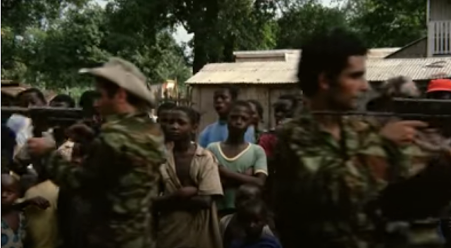
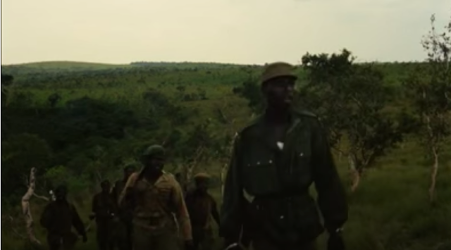
[84] Der Leone Have Sept Cabeças / The Lion has Seven Heads (1970, dir. Glauber Rocha)
Ironically, it was at the height of his fame as an exponent of a specifically cinema that Rocha was exiled from Brazil and began to operate within a European framework, seeking funding wherever he could. ‘Antonio das Mortes’ had effectively put Brazil on the international (read: European) cinematic map, providing a populist left-wing icon that combined the appeal of the ‘Zapata westerns’ with that of the left-leaning arthouse crowd, coincided with Rocha’s (self-imposed) European exile, yet Rocha was now cut off from the folk practices which gave his early films their force: the cangaceiro myths of ‘Antonio’ and ‘Black God’, the cadomblé of ‘Barravento’. His embrace of identity as a ‘tricontinental’ filmmaker, and consequent depiction of the Third World thus in turn becomes more generalised, at once suggesting solidarity along the lines of tricontinentalism, and reflecting an unmooring from the specificities of Brazilian cultural production. During the 1970s, Rocha shot films in the Democratic Republic of the Congo (‘Der Leone’), Spain (‘Cabezas Cortadas’) Italy (‘Claro’) and, as part of a collective production, the documentary ‘As Armas e o Povo’ on the 1974 carnation revolution in Portugal. In other words, he participated in the political questions both of the European ‘West’ (including its dictatorial, military aspects) and the decolonising ‘Third World’. Beginning with ‘Der Leone’, Rocha gives new meaning to the term ‘international coproduction’. If this new confluence of state and private funding arose in part from the inability of national cinemas to compete with Hollywood, it also enabled the production of a notably left wing, third wordlist cinema—the ‘Zapata westerns’, films like Bertolucci’s ‘Novecento’, Pontecorvo’s ‘Battle of Algiers’ and ‘Quiemada’. The film’s cast is international and, though the film is shot primarily in French, each the five languages that form its title are also spoken. Rocha thus insists, while operating from a perspective informed by the particular experience of brazil, that the film is international, in terms of filmic influence—he mentioned Brecht, Einstein and godard in relation to this film, along with cinema novo—and the issues of colonialism, an international phenomenon. ‘Der Leone’ differs from almost all existing models of political cinema: the Maoist—but white and European—left found in Godard’s work from ‘La Chinoise’; realist depictions of revolution (Pontecorvo); neorealism; the attempt to create empathy for the struggles of the oppressed. Instead, he turns to allegory and dream, not just as one element, but as influence on total structure, at once stressing the technological mediation of cinema in a firmly materialist manner and insisting on the importance of an apocalyptic, revolutionary mysticism to its conceptualisation of politics, resistance, revolution. Thus, Rocha at once emphasizes the defamilisarising—‘modernist’—elements of his previous work, bringing together a secular, materialist tradition—Brecht, Godard—with the ecstatic, the mystical and the musical that differed sharply from such models. If Rocha’s Antonio films had borrowed their figuration from existing folk myth and, to a lesser extent, film trope—St George, the cangaceiro, the landowner, the cowboy—the allegorical canvas here is broader and more international. Unlike Godard—who avoided Africa—or Pasolini—whose African and Arabic settings were, to say the least, romanticised—Rocha took seriously the possibility of Africa as part of the tricontinental axis. His African extras are not anthropological specimens but real people, sometimes laughing at the actions they’re asked to perform: in one key moment, the camera zooms past the European actors and lingers on the faces of the crowd who watch them with a kind of defiant bemusement that extends to the filmmaker himself. The scenarios sees the tricontinental revolutionaries—associated with Zumbi, the Black Brazilian founder of the quilombo community Palmares, with African leaders such as Cabral, and with Che Guevara—unite against Marlene, the Aryan figure identified with the seven-headed beast of the apocalypse and with the mendacious forces of money and European colonial ideology, and her henchmen—a series of European mercenaries and the neo-colonialist ruler from the African national bourgeoisie. At the films end, a procession of militants in guerrilla fatigue slowly march up the hill, singing a revolutionary song. The protagonists of ‘White God’, Paulo in ‘Terra em Transe’, or Antonio in ‘Antonio das Mortes’, who end those films stuck on the edges of things with no way out—the coast, the desert, the endless road—with no way out. Here, however, the militants, unlike those isolated figures, move as a group and march with a purpose, even if it’s not clear where they’re heading. Moreover, their song unites art and struggle: the song and the machine gun, the spear and the dance are connected. Rocha’s exilic internationalism is thus refigured as space of possibility as well as the product of political catastrophe. At this point, there was evidently a world to win.

[83] Antonio das Mortes (1969, dir. Glauber Rocha)
Back to the sertao after the world of urban politics in ‘Terra em Transe’, this, perhaps Rocha’s best known film, focuses on selection of archetypal figures: the cangaceiro and the black male saint (Saint George) and white female saint who accompany him, opposing the landowning coronel—representative of the old order, losing his grip—and the modernising underling who attempts to enact equally exploitative land reforms with US investment, with the bounty hunter Antonio das Mortes, who kills the last remaining cangaceiro, realising the errors of his ways and joining with the group of followers now deprived of their leader, while also realising his own ultimate irrelevance, as a positive force, to their struggle, as he trudges along, alone, by the side of the road the bears the trucks associated with U.S. imperialism. The film ends ending in a kind of parody of the western shootout, opposing the heroizing idea of violence as redemption, yet drawing on violence and archetypal forces of good and evil such as St George and the dragon drawn from folk myths as collective and syncretic modality. Rocha noted that, in an underdeveloped, rather than modernised country, Brazilian uprisings came from slaves and peasants, not from the proletariat. In Rocha’s films, people speak in poetry. Rocha draws, not on the ‘naturalistic’ dialogic modes of neo-realism but on the heightened discourse of oral tradition, of folk poetry, of song. As far back as ‘Barrevento’, dialogue is less narrative, functional or naturalistic, than a mode of ‘theatricality’ closer to the traditions of ritual, religion and folk practice, of folk drama—as well as to Brechtian and avant-garde techniques, insofar as these might also be informed by such practices. These films are symphonies of sound and image, intermedial works aiming to create an aesthetics of film that is not based on an aesthetics of the natural, the psychological, the narrative or the linear, but a canvas writ larger than life. Rocha, as a middle-class Protestant filmmaker from the city who comes to endorse a form of syncretic rural folk Catholicism associated with the sub-proletariat, to an extent overlaps with Paulo Martins from ‘Terra em Transe’—the relation of the filmmaker to often desperately poor subjects, such as the extras who give ‘Antonio das Mortes’ much of its life, is one at once of class contradiction, solidarity and potential exploitation. While Rocha at one point claimed to be ‘psycho-analysing’ the traditions of the people—an ambiguity that echoes that of Fanon’s writings on folk practice within decolonising movements—his films suggest something less clear-cut, an attempted fusion with those traditions that doesn’t pathologise them, but uses them to reorientate the language of reason itself. The focus on the north-east, on peripheral regions, also had ramifications in terms of the film’s material circumstance. During the shooting of ‘Antonio’, Rocha and his left-wing crew, on location in Brazil’s Northeast, faced a choice: either return to the urban centre and likely be jailed, tortured, or killed; or stay where they were and finish the film. The decision was made: both in terms of personal survival and political effectiveness, the film was paramount. Its legacy, a kind of folk opera of shifting imagery and sound, is a vital contribution to Cinema Novo, to Third Cinema, to cinema in general.’
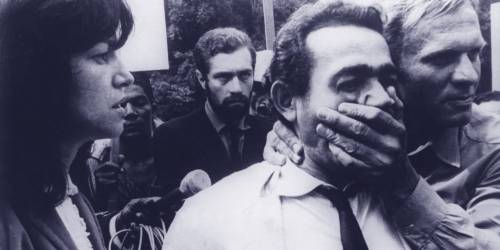
[82] Terra Em Transe / Entranced Earth [Land in Anguish] (1967, dir. Glauber Rocha)
Rocha here focuses, not on the underdeveloped peripheries of the country, but the centres of urban political power. As a film, its editing, shot composition and soundtrack bring it closer to the vocabulary of the European New Wave—whose experimentation is taken a step further in a barrage of visual and aural information—and its focus on an alienated poet-intellectual, torn between class loyalty and a sense of justice, certainly fits with the paradigm of the European art film. The intellectual in question, Paulo Martins (on the right of the photo above) respectively aids, then turns against, first a right-wing Catholic nationalist and then a left-leaning populist politician (in the centre), both disgusted by and exceeding them both in cynicism and contradictory political moves. The forces of American capital hover all the while. Alternating between the allegorical—conducted in something of the vein of street theatre, as the relations between different class interests take vividly archetypal form—and moments closer to realist dialogue, the film also stages numerous confrontations between art and action, the pen and the gun, our ‘hero’ beginning and ending the film by writing his cryptic, surreal words in the sky with a wildly-brandished machine gun after the military coup which has seen him fatally shot in an escape attempt. So Martins is another Rocha protagonist fleeing, caught between contradictory forces—but the populist energies of the underdeveloped are not present here. This is, instead, a record of a catastrophic series of moves which ensured the decades-long military dictatorship: the overthrow of the Goulart government in 1964, and the cementation of military power in the constitutional changes of 1967. Myths are shown, not as revitalising forces, but as those wielded by corrupt figures—the Catholic politician evoking the missionary zeal and religious fanaticism of the original colonising forces and of the Inquisition—against which a secular intellectual class has little to no reply. Only the activist Sara (left of the photo above), who’s been tortured in prison and who, in comparison to her sometime lover Paulo, refuses to waver in her commitment to the struggle, provides a voice against such catastrophe, juxtaposing Paulo’s ‘hunger for ideas’ with the presence of actual hunger, his ‘tortured’ mental struggles with the actual torture she faced in prison. If it’s often unclear what viable forces are left to which one can commit after the advent of a dictatorship, it’s the fact of this commitment that lingers.
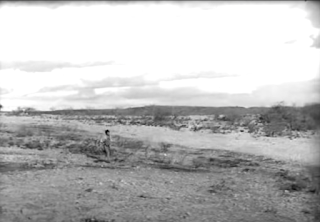
[81] Deus e o diabo na terra do sol [Lit. ‘God and the Devil in the Land of the Sun’] / Black God, White Devil (1964, dir. Glauber Rocha)
Where do the protagonists of ‘Black God’ run to? They—a husband and wife on the run—have spent the whole film fleeing–from the murder of the boss who refuses to pay for dead cows which first renders them fugitive, to the murders committed for and eventual murder of the religious leader (the ‘Black Saint’ of the film’s English title) they next take up with, to the murders committed for and the death of the cangaceiro, the folk bandit (‘White Devil’) who provides a further . Each unit in which they find themselves in some way offers an articulation, however imperfect, for their struggle against the social forces that exploit them and keep them in poverty: the religious cult given over to millenarian prophecy, to brutal tests of strength, and to acts of violence which seem at once forces of social justice and indiscriminate, fanatical killing, the cangaceiro’s gleeful proclamation of ‘evil’ and war against the owner classes equally prey to displays of egomaniac male power and sadistic brutality. Once these are destroyed by the state, in its own acts of brutal violence which slaughter the cult members on the mountain where they’ve prayed; once the cangaceiro is dead, tracked down by the ambiguous bounty hunter Antonio das Mortes—a kind of class traitor maintaining ‘law and order’ through extra- (or semi-)legal violence whose ‘conversion’ to the cause of the people will form the basis of this film’s internationally-successful sequel—their only resort seems to be the sea itself, the farthest limit of the country, the point of no return. The sea is a vital location in Rocha’s work: as the scene of the birth of modern Brazil, of violence and colonialism: the suppression of native populations, amplified in Rocha’s next film, ‘Terra em Transe’, as the right-wing politician strides onto the beach, the flag of the Inquisition in one hand and a cross in the other, and the imported labour of the slave trade—present through the cadomblé register of ‘Barravento’. For its part, ‘Black God’ strains throughout at the limits of the coast, of arid interior and marine exterior. The film’s ‘black saint’ repeatedly claims that the sea will merge with the sertao (the arid farmlands of the country’s underdeveloped northern regions in which the film is set). This impossible union suggests a tension key in Rocha’s work: between the succeeding waves of invaders, at once exploiters and exploited, from the indigenous population, to African slaves, to the ‘white’ poor, to the ‘white’ modern urban bourgeoisie. For the sea—the space of those who are racialised (the Black fishing community of ‘Barrevento’ or the white coastal cities that give Brazil its international image)—and the centre—a region of intense underdevelopment. Coasts are places of arrival and departure, a reminder of Brazil’s European colonial past and the underdevelopment which renders that tension still present. Rocha went on to a career staked on his internationalism, as a self-proclaimed tricontinentalist who went on to make films in the Democratic Republic of the Congo, in Italy, and in Spain. But his friend Regis Debray nonetheless suggested that Rocha always approached both politics and aesthetics through the lens of revolutionary nationalism: the coast as a figure for the landings and departures that could never quite be fully made, or never made without violence, rupture, fracture, an aesthetics of dreaming that might equally become an aesthetics of nightmare. Where do the protagonists of ‘Black God’ run to? Everywhere and nowhere. Their lack of options attests to an ever-present dilemma, all the more so, a good half-century on, in the age of Bolsonaro, of the continued super-exploitation of native land, of ever-more brutalising racism and alliances with American capital: the question of a political future, and the available means of a national cinema with which such a future is intimately connected. The protagonists’ descendants might be said to symbolically run down that coast still.

[80] Barravento (1962, dir. Glauber Rocha)
In a sense apprentice work—a production taken over when one director abandoned the project, and in turn abandoned to be completed by a third—this film is both an anomaly within Rocha’s output and an important anticipation of his later concerns. His first engagement with folk practice and syncretic religion—here cadomblé, in other films, its Christian inflections as they manifest in the mythic figure of the ‘black saint’, St George—is markedly ambivalent, even downright hostile. Yet it’s vital to make a distinction between the didactic dialogue which calls for the rejection of superstition from a materialist, socialist basis, and the energies to be found within those ‘superstitious’ forms as they’re documented by the camera—the chants, drumming and singing that will provide such an important part of both texture and argument in ‘Antonio das Mortes’. This distinction suggests a contradictory—though possible generative—ideological conflict beyond that staged in the film’s narrative. Members of the fishing community can proletarianise themselves by moving to the city and learning methods to join their struggles to those of the workers’ movement—in particular, circulating around the ownership of the nets with which they fish, ‘loaned’ to them at extortionate prices by urban capitalists. Thus, the film’s ambiguous hero, who’s begun the narrative by returning to the village from an initial period in the city, full of contempt for its ‘backwardness’, leaves once more with a resolve to help transform that community. Yet along the way, he’s shown himself morally dubious in his actions—at once castigating and hypocritically using the forces of cadomblé ritual he castigates in ways that map onto sexual desire and conflict. Rocha’s subsequent films will learn to move from an aesthetics of hunger to an aesthetics of dreaming, to use his terms—from the representation of poverty to an attempt to derange style itself in a way that gains from the insights of the oppressed (including, and perhaps especially, the ‘superstitious’ repository of imagery to be found in folk religion) rather than simply presenting their oppression as disaster to be solved by the science of dialectical materialism. The film itself lacks the visual excesses of Rocha’s later work, its narrative at least ostensibly cleaner and more coherent, its visual language less extreme, its palette one of black and white contrast that lacks either the bleached bleakness of ‘Black God, White Devil’ or the explosion into colour signalled by ‘Antonio das Mortes’. Yet moments are as haunting as anything in his filmography—a drumming circle upon the ‘hero’s’ return—the space of the sea as location of trauma and possibility, from whence the titular figure of the ‘barravento’ or ‘turning wind’ provides a metaphysical transmutation of the originary forces of the Middle Passage. As such, it suggests a relation between the (largely Western) vocabulary of vulgar Marxism and the racialised presence on the peripheries of the nation, granted a degree of semi-independence that both arises from and challenges conditions of underdevelopment. And it’s to a synthesis of these forms that Rocha will increasingly reach towards: a rejection of coherence that stresses improvisation, energy, and the potentiality contained within aesthetic/religious forms that cannot be subsumed to ‘scientific’ laws.
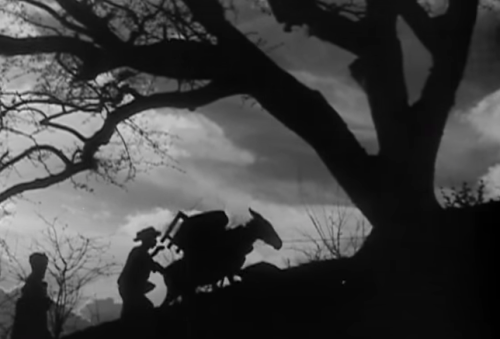
[79] Aruanda (1960, dir. Linduarte Noronha)
For Cinema Novo figurehead Glauber Rocha, Noronha’s short, semi-documentary film was the foundation, presenting an ‘aesthetic of hunger’ against the ‘aesthetic of digestion’ (and consumption) that governed the myth-making of official Portugese cinema, which it countered with “characters who eat dirt, characters who eat roots, characters who steal in order to eat, characters who kill in order to eat, characters who flee in order to eat, characters who are dirty, ugly, skinny, living in filthy, ugly, dingy homes”, and for which it was criticised of ‘miserablism’. But the family shown here are not simply victims: the film shows their impulse to continue, to survive, to build; humour, intimacy, humanity. They’re the survivors of a quilombo, the descendants of those who ran away from the slave regime, and though they have to survive within a semi-arid landscape, their separation from an affluent urban landscape within underdeveloped regions an index, not only of their defiant legacy, but of the continuing racialised, classed and regionalised imbalances of Brazilian society. The film presents those who have refused and have been refused ‘integration’ into the broader body politic: its title suggests the Afro-Brazilian religious conception of a spirit world, of embodied spirits who take the form of the ‘wretched of the earth’, a syncretic form with political ramifications. As such, it gestures towards the revitalising myths which Rocha will find in such communities, which serve to present hunger and misery, not in fatalistic fashion, but as a dialectical source for new myths, new ways of political and cinematic thinking.

[78] Monangambé (1968, dir. Sarah Maldoror)
Maldoror’s ‘Monangambé’ plays out a similar scenario to the feature-length ‘Sambizanga’: the visit of a wife to her imprisoned militant husband—with a more darkly comic frame and a more avant-garde soundtrack and visual style serving to illustrate both the extreme brutality of the situation, the ironies of paranoid misunderstanding, and the psychological effects of torture (in the shadowy scenes of the imprisoned man traumatised by torture). Its title—a warning, literally meaning ‘white death’, of the approach of slavers, and subsequent colonial powers, and then as signal to gather during the liberation struggle of the 1960s—performs a linguistic reversal suggesting the importance of contextual knowledge, and it’s this sense that the oppressed can utilise language as a weapon that remains opaque to the colonialists that leads to paranoia such as that seen by the prison authorities here. The prisoner’s wife promises him a ‘complet’—that is, a three-course dish, food for someone deprived of proper nutrition—misunderstood by the prison director as a three-piece suit, and thus as the reward for escape from prison, leading to renewed sessions of interrogation and torture. At once stroke, prison authorities exercise near-unlimited power within the confines of their domain, sadistically wielding torture whenever they feel like it, and are revealed to have little true understanding of what they’re dealing with—a misunderstanding that can perhaps be exploited. The soundtrack by the Art Ensemble of Chicago emphasizes discontinuity over mimetic guidance, the independent parts that constitute the individuals within a freely improvising ensemble, and of the tracks of visuals, soundtrack and speech that constitute a film. This is a film about the risky ambiguities of language and of the emotional truths that go beyond language, not as existential concerns, but as the arena of real political struggle, of real consequence, for which cinema finds an experimental vocabulary. Maldoror’s films of this period are films in process—films subject to an extreme precarity of material circumstance, such that an entire film might be lost mid-way through film-making, which are forced to improvise and adapt in their methods, and which suggest a kind of improvisatory viewing as well. Virtually unseen within the canonical habits of Western film consumption, they’ve lost none of their power.
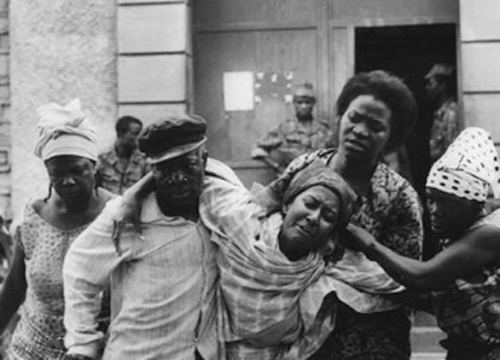
[77] Sambizanga (1972, dir. Sarah Maldoror)
Maldoror’s vital film was made for practical purposes—to document the struggles of the Angolan War of Independence, and the widespread imprisonment and torture of members of the MPLA, at a time when the war against Portugese colonialists was by no means over. With its cast of non-professionals and its absence of visual flourish, Maldoror’s film emerges from and speaks to its circumstances: functional film-making, which doesn’t mean a suspension of ‘quality’ for the contextual, but which makes a strong claim for a mode of cinema that cannot be disentangled from ‘context’, in which form and function match. The film is neither the exposée of neo-realism nor the humanist of ‘poetic realism’, but something entirely its own. The scenario is simple, but has its heart the willed obscurity of a colonial regime who lock away and murder those who challenge them in secret: Domingos, an MPLA militant, is abruptly kidnapped by colonial authorities in a horrific dawn raid of the village; his wife Maria walks from prison to prison, and the film follows her journey, and that of a network of clandestine militants who seek to obtain information on Domingos’ location while themselves remaining ever-careful to avoid exposure. It’s a woman—Maria—and an old man and a young boy—the pair who watch the prison for those who have been secretly deposited there—who form the central points of identification, and while a superficial viewing might suggest that the film reinforces normative gender roles—Maria’s entire focus is on her husband, rendering her in that sense secondary to a political struggle figured as male—that would miss the point. Maria’s grief and uncertainty is genuine, her task is practical: screaming Domingo’s name outside the prison is a practical, political act, as well as a raw welling-up of grief. And the collective network which seeks to aid her, and which can only emerge through mediated forms of communication, the slow process of connection, the discovery of information piece by piece, involves men, women and children, suggests a model of the society that might emerge once the struggle is one, eventually coming into focus in the closing performance of song, a public statement of solidarity and resolve, a joyful memorial for the dead. Made ten years after the events it describes the film is able to close with end titles that note the progress such struggle ensured, even if that struggle has by no means by entirely won. Though Domingos dies, Maria’s persistence, along with that of the network of other militants who receive the news of his death, and who will soon go on to storm the prison, suggest qualities of survival and defiance that assume both a personal and a collective level. A luta continua.

[76] Hyènes / Hyenas (1993, dir. dir. Djibril Diop Mambéty)
After the twenty-year period of silence following the success of ‘Touki Bouki’, Mambéty’s second film gives its satire a more analytical frame. The quasi-allegorical narrative structure explores the relation of past to present within a specifically—though exaggerated—political frame; its events are specifically set in a collective context, where the continuing legacy of imperialism as it effects relations gendered, sexual and economic relations in the (post)colony. Returning to her village as a fabulously wealthy citizen, for whom wealth is also index of damage, literal prosthesis—the arm made of gold!— Linguère Ramatou is something like ‘Touki Bouki’s’ Anta some decades on, returned to take revenge on Dramaan Drameh, the man who abandoned her and has since taken up a role as a comfortable, well-liked bar owner—and a kind of de facto, unofficial mayor—within the still impoverished town. The devil’s bargain—that her wealth will be that of the village if they execute him—is not only index of personal revenge, a kind of just deserts for the past sins of patriarch—Drameh paid false witnesses to testify that he was not the father of her child, leading her to be driven out of town and to a career as a sex worker—but of the inhuman and dehumanising bargains of global capital, the mendacious ways in which continuing underdevelopment and the power relations of the centre-periphery relation structure the life it’s possible to live. Ramatou simply serves as the agent of the ways in which collectives are divided—whether by the structures of gendered power relations or by the ‘hyena-like’ rapaciousness the promise of money brings. Such economic structures rely on the mythic realities that any dream can be bought, and that its fulfilment will invariably come at the expense of others. Through a satirical broad-brush, Mambéty seeks to make such bargains specific, rather than the abstract underlay of virtually every human interaction; it makes a vivid and convincing case whose laughs have the sting of accuracy.

75] Touki Bouki / The Journey of the Hyena) (1973, dir. Djibril Diop Mambéty)
Young couple Anta and Mory roam around on a motorcycle and try to think of the best way to steal a large quantity of cash in order to escape to France, their dreaming of Paris is rendered on the soundtrack through the increasingly grating fragment of Josephine Baker’s ‘Paris, Paris’ as leitmotif, an incessant loop, the siren call of the metropole to which only one will ultimately respond when it’s time to board the ship. The film constantly jump-cuts between subjective impression and objective frame, occupies the gap between dream and present circumstance, the rebelliously joyful and derisive rejections of anarchy of the equally unmoored drifting of the disillusioned. Structured around a loose narrative—more wish than fulfilment—its satirical exaggeration occurs somewhere between reality and fantasy, surreal flickers at the edge of the observed that borrowing their visuals both from the iconography of cinema—the motorbike, with its unforgettable cow-horn mounting rendering it something from an adapted western, the various illegal schemes to get money with their suggestions of the Hollywood outlaw—and from public life and its presentations of wealth and power—the sequence where our heroes imagine themselves as politicians in a gaudy parade—but also, in less self-contained a manner, in the truncated evocation of the way that personal emotion blurs, cuts and slices clear and logical narrative, as in the early sequence when Anta believes Mory to be dead, fallen off the cliffs, loss and death soon turning to erotic encounter. Caught between unattractive options, with few prospects in site, the rejection of the alienated despair of expected social roles and routes leads to a different sort of alienation: aimlessness, drifting, being, escaping through the freedom of the road, Easy-Rider style—a freedom that ultimately seems to lead nowhere, the bike totalled by a thief who lies dead in the road. These dreams are haunted by death—from Anta’s mistaken grief to the film’s most notable icon, the cow-horn mounting, itself contextualised by the opening sequences of a slaughterhouse rendered in unsparing detail. That’s not to say it’s fatalist or existential, but neither does it seem to place a huge amount of belief in cinema as educational tool found only a few years earlier in Sembène’s ‘Le Noir De…’, widely cited as it is as the first full-length independent production on the African continent. Open-ended and ambiguous, ‘Touki Bouki’ doesn’t construct an argument or make a plan, and its near-nihilism perhaps what rendered it attractive to precisely those Hollywood filmmakers (Scorsese) whose exploration of crime and defiance it recontextualises and plays back. But unlike those films, its tone—at once brash and elliptical, satirical and melancholic—has rarely been matched.
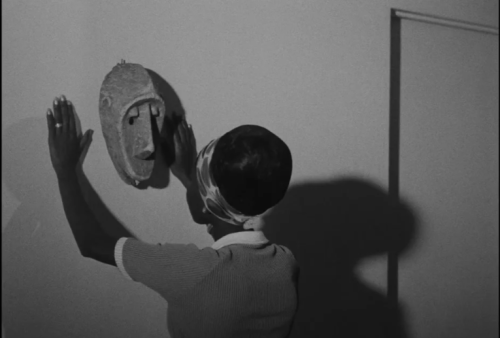
[74] Le Noir De…/ Black Girl (1966, dir. Ousmane Sembène)
The simple scenario, based on a newspaper report, finds the titular character, Diouana, moving from Senegal to the South of France to take up a position as domestic for a bourgeois French couple whose business interests in Dakar are, it’s implied, waning in the post-independence moment. But the power relations within the French apartment are still very much titled in their favour—horrifyingly so—as their neglect and abuse of Diouana, withholding her earnings and preventing her leaving the apartment, see her ultimately commit suicide rather than continue in the status of property. Little under an hour in length, the spatial and temporal constriction of the film gives it at once the clarity of a fable and the brute reality of the observed. Few other films that so well to suggest space, to excavate the contours, the power relations of a series of rooms (‘Petra Von Kant’, a very different film—though, at least in its ending, it also has something to say about labour and silence—has a similar constriction, whilst seeming more ‘theatrical’). Sembène relentlessly exploits the way imprisoning social walls take place within a domestic space—the rooms of the apartment paced, evaded, sites of divided and perpetual labour in which white employees take out their frustrations on themselves and on their servant, demanding that their ash trays, their dishes, the traces of their afternoon boozing be cleared almost as soon as they’ve appeared by a worker whose human presence must be reduced at every cost. Trapped within the apartment with no way to escape, Diouana faces few options for active resistance. How can one organise a workplace when within that workplace—which is also one’s new home—one is kept entirely solitary, essentially cut off from the outside world? Diouana’s eventual acts of resistance are to reclaim the mask she’d gifted her employers in Dakar when they wooed her with promises of a cosmopolitan lifestyle and apparent personable tolerance; refusing to work even when told ‘no work, no food’; and ultimately, her suicide, the newspaper report which inspired the film. As the ambiguity of the film’s title—erased (and gendered) in its English translation—suggests, Diouana has been rendered the property ‘of’ her employers—‘Le Noir De’…’ as at once ‘The [Property] of [her employers]’ and ‘The [Property] from [Dakar, transplanted to Antibes’. Given this, her hunger strike, work stoppage and ultimate removal of herself prevents her from becoming something to be used, even as it also removes her from the world as such. In the film’s coda, ‘Monsieur’ returns to Dakar to bring her parents news of her death, his offer of money—a kind of bad conscience pay-off—brusquely refused by her mother. The tables have not exactly turned, but as he’s followed by the child wearing the mask that Diouana had gifted her employers, which they’ve taken as a trophy of display just as they bring Diouana herself back from Dakar, his discomfort suggests the white subject no longer quite as at home in the world he surveys—even as this post-independence film strongly suggested that the official ending of colonialism had by no means solved the majority of its problems, the systems of racialised and gendered exploitation that take place in centre as well as periphery, the sharp distances that keep the two separate and invisible to each other. In the absence of literacy for Diouana and many others, cinema makes visible such invisible forces, gives voice to what cannot be voiced. But, importantly, cinematic language also serves as access to an affective truth without which the film would be useless. The film depicts not only the objective grimness of Diouana’s situation but the intwined the subjective effects within her, a subjective mode that can never be articulated within the frames in which she finds herself trapped: it externalises that which cannot be externalised, tries to give voice to the experience of a person whose death otherwise occupies a few sentences of sensational newsprint, no more. To externalise requires language—oral if it can’t be written, visual, if it can’t be spoken—hence cinema.
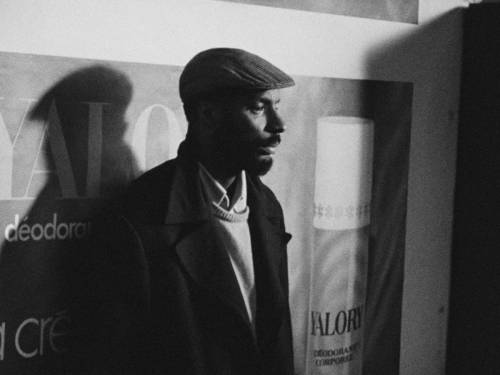
[73] Soleil Ô / Oh Sun (1967, dir. Med Hondo)
Shot on a tight budget, between other projects, Hondo’s debut feature fits into the cracks of permissible cinema as its immigrant characters try to fit into a hostile and racist Parisian environment. But unlike them—or like them only as they can be at their most unguarded moments—it doesn’t hold back, from the animal noises played over the all-too-real life footage of racist white citizens on the street to the didactic vignettes that frame it: serio-comic playlets, recalling, perhaps, silent cinema, or détourned educational films (and a racist education, as well as religion, are particular targets here), depicting the workings of colonialism and the attempted ideological brainwashing of Western ‘civilisation’. Episodically, the immigrant’s experience, at once painfully specific and grimly archetypal, plays out in humiliating rejections or moments of levity, satire and shifting power relations, eventually moving away from the city and to the countryside, where the protagonist walks, then runs—first as an unwillingly-invited guest at the plein-air meal of a bourgeois white family, whose children delightedly trample all over the food while their parents appear nonplussed, in a neat reversal of the tropes of racist anthropology, with its depictions of the ‘savage’ family; and subsequently in a forest filled with revolutionary icons at which he screams to a blaring soundtrack in an emotional confrontation that’s as abstract as it’s affectively powerful, and as politically pointed as it is avant-garde. Hondo seems to find his way to a new kind of cinema in process in almost every frame, and the result is telling, thrilling, essential.

[72] West Indies (1979, dir. Med Hondo)
Surprising as it might seem to those who’ve only seen Hondo’s earlier films, this is very much a musical. The film is slicker, larger more choreographed than ‘Soleil O’, and feels at once theatrical and totally filmic. A run-through of the history of the Francophone Caribbean, and a political argument against dependence on and migration to France, in a sense, it sets Soleil O’s Pan-African migrant experience in a more specific context and extends the more pageant-like chronological fables that pepper the former film to greater length, using Daniel Boukman’s play as its basis. Shot inside an enormous, life-size ship constructed inside a factory, seen in the opening shots, the film—both for practical purposes (there would be no other way to film it), and for structural ones—reveals its own set. Hondo has actors double multiple roles; further doubling occurs in presenting multiple spaces and time frames in this single, capacious structure. As such, ‘West Indies’ borrows two important conventions of stage plays that are generally left out of film, with its greater flexibility of available actors and available space. In doing so, it turns these conventions into a potent comment on a history in which the same basic colonial power relations are perpetually retained under a different guise; in presenting the ship as both the metropolitan centre and the (post)colonial periphery, Paris and the Caribbean, it amplifies their connections; in staging all of this is in a giant factory, it suggests the ways in which the raw materials worked at through slave and post-slave labour were always at the heart of, and entrapped within, the industrial potency they enabled. The music and choreography are elaborate, slick, witty and moving all at once; I can think of little like this.
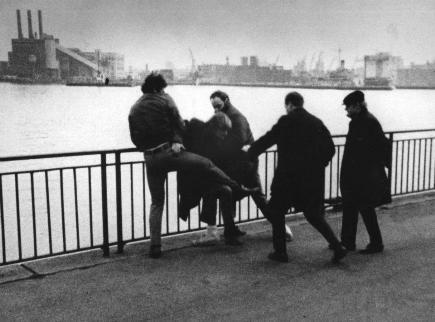
[71] Ice (1970, dir. Robert Kramer)
A more fictionalised, more extreme, more clandestine, more single-minded version of the sprawling cast of ‘Milestones’, Kramer’s more condensed and fictionalised ‘Ice’ depicts the planning of a Tet-style ‘Spring Offensive’ by a group of would-be urban guerrillas engaged in strategy meetings, armed raids, and—in a self-conscious move no doubt relating to Kramer’s own work in collective political film-making (from which some felt this individually-directed film was a step back), the making of propaganda films, whose intertitled slogans flash up throughout the film. The members of the group are all young, all white (though in one brief scene they negotiate with a group who, it seems to be implied, are the Panthers), more Weather Underground than Symbionese Liberation Army, but beset by the suspicion and isolation of the close group—the paradox where the path to accomplish total societal transformation is now felt to lie in necessarily secret and small-scale activity. The scene where the group kidnap and then explain to the residents of an apartment block their vision is the awkward test case for the beginnings of bridging this gap: having taken oneself out of circulation for the sake of one’s ideas, one’s methods, how to put oneself back in, how to spread such action? Filmed before the collapses and revelations of such groups documented in excruciating detail in Wakamatsu’s ‘United Red Army’ some decades later, the film reserves judgement. The group is of mixed gender, and women appear to play equal roles in the organisation, but it’s unclear to what extent Kramer shares the apparent obsession with impotence and depleted masculinity literalised here in the figure of the castrated revolutionary now in a purely defensive position, typing up reports and waiting with his shotgun behind a desk in an office. These are not glamorous rebels (as per ‘The Baader-Meinhof Complex’), nor sociopathic terrorists, but, given the demands they’ve placed on themselves, ironically enough, professionals who must act with a total focus on the task and little time for an un-fraught human intimacy. For me, the most striking moment is one of the least flashy. Temporarily alone in the snow while on a training retreat, the figure who adapts the role of protagonist—or at least of leader (though the structure of both film and group itself refuses such roles)—imagines that thought is like a river which exceeds the subject in whom the thought supposedly originated. ‘What we have here is a situation where we find ourselves in the midst of a river with very strong currents and with no way of getting out of the river, but that’s not bad. And you just go ahead and do what you can’t avoid doing. And your mind follows along. So, you’ve got to change your mind around, […] no need to even ask some of those questions you used to be asking… Interesting to think of the ideas being not your ideas but being part of a movement… What do you make of that? A little crazy?’ Conceptualising the individual as part of the currents of history isn’t new to revolutionary thought—or to other kinds of thought—but there’s something terrifying about this—the movement of the river not that of a collective of people, but of some impersonal, natural, abstracted force. Is this the force which the melting of the titular ‘ice’ through revolutionary action might release? Or is that ‘ice’ the coldness, the suspension of affect and emotional responsiveness to accomplish revolution? Or to ‘ice’ someone—as when the same individual is abruptly thrown into a river on his return to the city, presumably by a group of government agents? If this is a movement, it’s not the movement of public protest, marches, and declarations of togetherness, but of an atomised, fractured and precarious collective that at times seems like the mirror image of the alienated society it seeks to destroy.

[70] Milestones (1975, dir. Robert Kramer and John Douglas)
Kramer has described this film in interview as, in essence, following around his friends—activists, actors, theatre and film people performing themselves, versions of themselves or characters. Though this is a film whose title proclaims its desire to tackle big subjects, big events*, its narrative method refuses such historical logic, or embeds it in the vicissitudes and differing scales of daily lives where it occurs as a network of relationships rather than a newspaper headline, a date, a statistic. (*And is in fact taken from a statement by Ho Chi Minh which implies the opposite–the revolutionary as the one who, like a modest marker of each mile on the road, indicates how far one has come on the journey and how far there is to go.) Over the lengthy running time, we encounter large group/s of (largely) of declassé white people involved in particular with the anti-war movement, living on communes, embedding themselves in factories, involved to a greater or lesser extent with the more militant wings of movement activism (one character has just been released from jail), all of them in various ways, and for different reasons—personal, political, both—reckoning with whether or not to keep up activism as the possibility of revolutionary change fades, as the war itself ends—and with it, the movement that built up against it. It’s hard to provide any total or totalising summary—though the scenes with Grace Paley reflecting on politics, gender roles and motherhood are highlights, and those featuring a blind, queer potter (played by co-director John Douglas) have an open and surprising tenderness to them. There are moments and movements of disenchantment and renewal, occasional sketches of a broader perspective, largely through historical montages: the glue of broader historical forces keeps coming unstuck, but, as the film nears its close things are brought together into a kind of statement of resolve, the film ending with footage from a live home birth, throughout which the mother is witnessed and helped-through collectively. It’s at once heavily allegorical and one of the most intensely ‘documentary’ moments of the film. In important 1975 ‘Cahiers du Cinema’ symposium on the film—a collective format for a collective film—featuring Serge Daney and others, several of the participants note that racialised groups are seen as focal points of exploitation and struggle, but are depicted only in pictures or identificatory rituals such as the activist released from prison who visits a hogan in a kind of restorative ‘vision quest’ (in another scene, his father, a doctor, invites him back into the class he’d tried to mark himself out from). Such groups thus rarely feature in the lives of these characters—suggesting that, of the dividing lines that appear in the film, and that fracture the communities they attempt to build, race is still the principal structure. Given this, Daney remarked in an essay for ‘Cahiers’ the following year, the films risks being apologia for ‘American conviviality’, based on the ‘ethnological masquerade’ of the ‘tribe’. (On this note, Lou Cornum has an important essay in the first issue of Pinko magazine about the use of the ‘tribe’ metaphor in a host white radical writings, from David Wojnarowicz to Leslie Feinberg, and a complex identificatory history, the way the American white (New) Left positions itself vis-à-vis the non-white might equally apply to Kramer’s film). For Daney, though, while there may be elements of such thought, reflected in the positions of the filmmakers as well as the figures in the film, ‘Milestones’ also suggests the fragility of this re-imagined community, specifically through two moments—an attempted break-in and sexual assault and the sudden death of a demobbed GI, about to join a collective house, who accepts an invitation to a break-in and is killed by a cop. In terms that suggest both what unites the individual figures to their various collectives (family, lover(s), activist group, commune, etc) and what unites the narrative strands of the film to each other, he describes the film’s structure not a ‘chronicle’, nor a ‘document’, but a ‘fabric’, one which ‘spreads, getting progressively larger, with invisible knock-on effects’. As such, the unknown is both space of political possibility, of dialectical process (and hopefully, progress) and risky territory in which the most vulnerable—or simply the unlucky—can succumb to the daily dangers against which the provisional collective(s) here envisioned can’t always protect them. Daney: ‘Human relationships don’t knit together with complete dependability; they are tied together over an empty space, on a wire without a net. To fall through the meshes of the net, to pass through a void, is to die’. And literally so. Milestone’s shelters are provisional, flimsy, and in constant negotiation, and if their dreams might seem alternately smaller or larger, more idealistic or more problematic than those we might be able to cultivate now, they resonate all the more for that: rather than a milestone to be mourned in left melancholy, nor a glowing icon of exemplary action, like Daney’s thread, they’re still unspooling, spreading, in all their complexity.
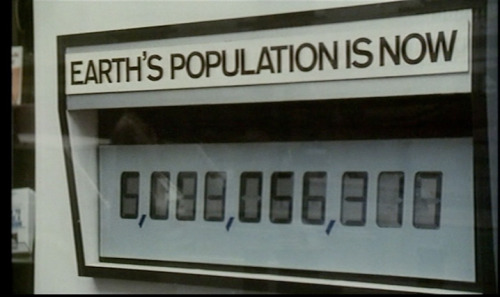
[69] Route One/USA (1989, dir. Robert Kramer)
This four-hour sprawl and slice-of-America docu-fiction bears obvious comparison to Kramer’s earlier ‘Milestones’, though it doesn’t function as a sequel as such. ‘Milestones’ gave us a constantly-rotating cast, through whose various storylines played out the collective dreams of revolution, activism, communal living, as things both held onto and slowly abandoned by a white middle-class emerging back into the class mantle which they’d temporarily left behind. In ‘Route One’, which traverses the entirety of the titular road from top to tail, we instead have a central figure—‘Doc’ (Paul McIsaac), who McIsaac described as a kind of fusion of his and Kramer’s characters, and who here serves as a travelling companion for the behind-camera Kramer himself. Doc first appears as character in ‘Doc’s Kingdom’ two years previously, where it’s suggested that he had a revolutionary past as a member of the Weather Underground and, upon leaving the states, in situations alluded to briefly here, became involved as a doctor in various revolutionary situations in Africa. Like Doc, Kramer returned to the States after a period of some years in Europe to make the film (though unlike Doc, he didn’t settle). And Doc/Kramer are now jaded, morose, bemused, sometimes amused—a relation to America not that of forging a new sense of collective being within it (one connected to often romanticised notions of ‘tribes’, dropping out and the like) but as an individual standing on the outside: the individual now rendered a ‘foreigner’ in the midst of his homeland. In conversation with Frederick Wismenan, Kramer used the ‘foreigner’ metaphor to describe the situations that unfold in the film, where an actor is placed in a ‘real life’ event (say, a Pat Robertson fundraiser); for Kramer, the ease with which the two could be integrated suggested that the American popular relation to representation had changed, conscious or unconscious notions of acting and performance (particularly as they relate to being filmed) altered through the ubiquity, not only of commercial cinema, but of television. To challenge the traditional division between fiction film and documentary—which Kramer sees as arbitrary—is thus not only a formal claim, but an assertion about the nature of social relations as the Cold War ground to its close, in which ‘image’ has become a ‘way of life’. Here, fixed in place by codes of race, class and gender, one is always ‘playing one’s self’. To set up these situations, the conceit of Doc and Kramer’s journey down the road at a time of political campaigning –a journey whose contours are arbitrary yet precise. While ‘Milestones’ has elements of the road movie—notably, the couple who try to make the transition from life on a commune to an urban job and house—‘Route One’ takes both the cross-sectional methodology and the rootlessness of the genre as its raison d’etre. Certainly, it must be one of the longest road movies in film history; the road, not as escape, celebration of speed, doomed romanticism, and so on, but as a standing to the side, observing. For a film with such a wealth of incident, the overall mood is subdued, melancholic: the clear gains made by the political right and the absence of viable sources of living together that don’t simply blame the marginalised or play out through the capitalist nexus are registered with what one critics calls a ‘long sigh’—and inequality and moral hypocrisy is didactically illustrated through one of the film’s best sequences, juxtaposing a teenage newly-wed who falls foul of the judicial system with the wealthy lawyer wandering his estate and talking about the need to maintain a work-life balance (because, if he kept the class immiseration he sees in his day job “in my mind, I would literally go out of my mind”). Yet Doc eventually gains some sense of possibility through community work with AIDS patients, and thence to Florida, where he settles down with a new partner and a job working with Haitian refugees (the conceit being that he’s here parted company with Kramer and his film crew). Like the characters in ‘Milestones’, he’s trying to find a way to settle down, to resolve the sense of wandering, exile and the inability to overhaul society as such through revolutionary means with the possibilities for more local, patient, yet perhaps no less valuable modes of change—or perhaps, in the case of his patients, simply survival.
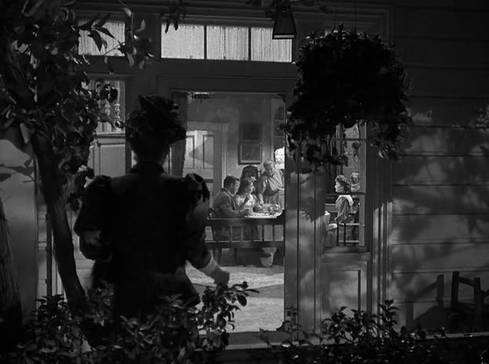
[68] All I Desire (1953, dir. Douglas Sirk)
The title’s ambiguity nicely captures that of the film itself. On the receipt of a letter (of course!), Barbara Stanwyck temporarily leaves her disappointing life in ‘showbiz’—a poor substitute, it turns out, for the planned career as a great thespian—heading back to see her daughter from a former marriage in her own stage debut. And so the jaded sophisticated returns to family life in the provinces which she abandoned years before, stifled by its gendered conformity and the corresponding repressive community of the town around : classic Sirk territory, as too are the children of the family, who (if less so than in ‘All that Heaven Allows’) seem to exemplify the very worst ‘virtues’ of family life—authoritarianism, convention, an insistence on the maintenance of an often illogical and harmful standards of duty and propriety—out of their own abandonment, neglect or straitjacketed education in the Order of Things. Does Stanwyck really ‘desire’ the family life she left behind, its stability, and the solid but dependable love of a boring man? Will she fly back to the gilded cage? Does she still desire her extra-marital lover, whose callousness is at least exciting (and with potentially fewer attached strings) compared to that of her husband? By whom and how are such desires manufactured? Perhaps they can’t be named, though melodrama will of course, as Fassbinder said, bring all those unnamed masses of anxieties to the surface—a realism of emotions, if not of actions. Some convoluted twists and turns towards the end relating to Stanwyck’s affair with the jealous store owner all lead to realisations and touches of pathos that enable Stanwyck to flex acting muscles, though both the pathos and the critique of conformity—partly due to the studio-imposed ‘happy ending’ (Stanywck stays!)—are less sharply drawn than ‘There’s Always Tomorrow’.
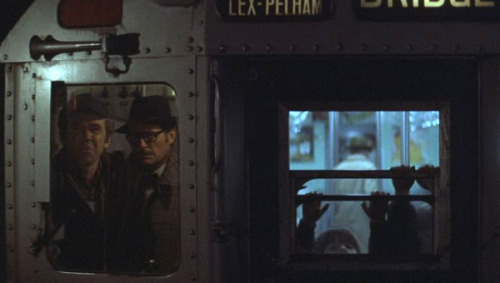
[67] The Taking of Pelham 123 (1974, dir. Joseph Sargent)
‘Pelham 123 ‘is of that genre of crime film that produced some of the most popular Hollywood films of the 1970s, a kind of grim disaffection in which the system is rigged—mayors, politicians, police chiefs alike are corrupt, in league with the criminals they purport to pursue—in which crime waves run rampant, and in which ordinary citizens are helpless bystanders and victims, and the occasional good cop as figure of identification might end up, like Al Pacino’s ‘Serpico’, shot in the face; or might be, in effect, a psychopath only marginally less deranged than the mass murderer he pursues (Dirty Harry). If such films tended towards a right-wing analysis, often drawing on the iconography—and the stars—of the western (Eastwood, Charles Bronson, John Wayne himself), their ‘toughness’, use of obscenity and the like a kind of ‘tell it like it is’ masculinity that often relied on racist and classed notions of criminality (see the middle-class vigilante absurdity of ‘Death Wish’), and that, despite the critique of political corruption, often nothing like a systematic analysis of how the financial crisis of the 1970s had come about and how they might have had some role to play in this apparent stew of moral malaise and cynicism. ‘Pelham 123’ is, thankfully, not too much like that—the cop, played by Walter Matthau, is personable, but neither especially heroic nor especially mendacious—simply functional—and the gangsters are not really characterised enough to be types, conservative bogeymen. The fact that the criminal group’s leader is a mercenary and ex-British army officer who’s fought in Africa suggests the mendacious trails of imperialism even if the film’s not really that interested in this backstory except insofar as the gangsters’ backgrounds create personal tensions that amp up the overall tension. Essentially, the film is a study in narrative tension and the confined setting of the subway tunnel where the gang hold a lone train carriage to ransom. As such, its setting harks across to another film of which its makers were likely unaware—the mordant B-movie ‘Death Line’, in which abandoned workers on the London Underground turn into cannibals—the city excavated for what lies beneath, the smooth flow of transport and commerce halted: derailed, one might say. The soundtrack—in another less noticed by-product of the grim 1970s thriller (viz. Morricone, Jerry Fielding, Don Ellis)—offers exemplary atonal, funk-tinged propulsion.
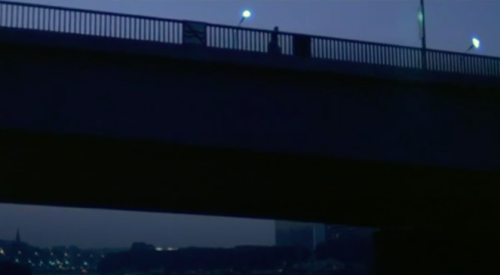
[66] Aurélia Steiner (Melbourne) (1979, dir. Marguerite Duras)
The shorter of the two Aurélia Steiner films moves from black and white to colour, the tracking shots of the French countryside that stood in for ‘Vancouver’ replaced by shots from a boat moving along the Seine—Paris this time as ‘Melbourne’. While the Vancouver film removes all sound save that of Duras’ voiceover, this shorter companion piece mixes in the sound of the water, or occasionally, of the boat’s engine, albeit low down in the mix. In the Vancouver film, the use of the tracking shot inserts itself into history—the debate over the Shoah and representation, Rivette and ‘Kapo’: in its Melbourne equivalent, as in ‘Les Mains Négatives’, ‘Le navire night’ and ‘Le Camion’, the perspective of the fixed camera transported in a vehicle—by car, lorry, or boat—renders the entire image with a different kind of constant, but passive movement. As in those films, the movement is also temporal: the rough span from dawn to dusk—but unlike those films, the focus is not so much on spatial peripheries, for we see the Seine’s monuments, the iconic bank, its bridges; yet we think of that which passes beneath them, to their side, that which is hidden in the heart of the capital; we think of what else passed under these bridges, on these streets that witnessed war, occupation, suicide, murder. Bear in mind here Duras’ comment that seeing the river made her think of the Algerians murdered there in 1961—Steiner names the Shoah, but not the Algerian war or other murderous projects of extermination and conquest—recall the overlay of occupied France with Hiroshima in Duras’ most famous cinematic contribution. Equivalence, displacement, replacement: these traumas of history, linked in the project of capitalism and fascism, their confrontations and complicities, the resistance to them and the victims they wrought, in films which refuse the grand narratives constructed around them in the attempts to render them legible—genre films, the war picture, the films that emerged even out of the same rubble through to the studio recreations as endless borrowed glories that, if anything, celebrated the wars existence for the narratives it gave them. In showing nothing, hardly a person, Duras’ films are far truer to the ethical demands facing film and text. As the film closes with just the sound of engines in the early dawn (or is it the dusk?), and a single, miniaturised figure passing over a bridge passes over our heads, what kind of crossing, what kind of passage does history provide?
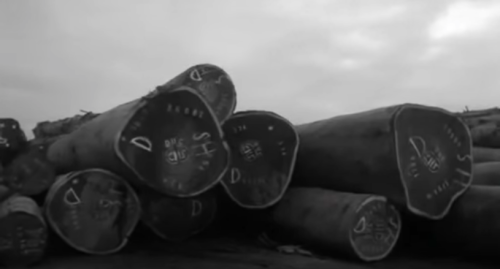
[65] Aurélia Steiner (Vancouver) (1978, dir. Marguerite Duras)
A film of the name— Aurélia Steiner a name invented by Duras to stand in for and (this a matter that’s more complicated, and perhaps more dubious) to identify with the losses of the Holocaust—the girl of 18 (as Duras was when she left Vietnam for France; as is ‘she’ in ‘Hiroshima Mon Amor’ when her lover is killed), on the cusp of adulthood, who decides, as Duras did, to write. The name is that which is given, over which on has little control—here, not the name of the father but of the mother, passed on (the Jewish maternal line)—a name signalling ethnicity (‘Juden Aurélia Steiner’, repeats a lover)—a name which echoes the name of the dead mother and stages a revenant return even as it also associates the living with the dead, on that wider scale of historical horror. We hear the name spoken, we see it written on screen, but we never see so much as a single face, body, person to whom we could put that name. What we see here serves as symbolic representation or displacement of a trauma which, as Rivette had argued of the infamous tracking shot in Pontecorvo’s ‘Kapo’, lies beyond the ethical boundaries of representation: tracking shots of trees, chopped down and laid out, numbers inscribed on their lopped off trunks, of the overgrown tracks and platforms of an abandoned railway station, which suggest without representing the mechanisation of death in transport and execution of the camps, as the speaker describes substituting erotic encounters for the impossible encounter with the dead father. The speaker recollects a storm, real or imagined, that has previously exploded over (and under) the city, then receded: landscape in calm bears the trace of a foundational, invisible disruption, and, even in calm, the white rectangle (the sun through clouds) and a ‘black spot’ on the horizon form something like visual floaters on the most absent or distant of landscapes. Aurélia, this figure who Duras later said ‘is everywhere, writes from everywhere at the same time’, as a figure of total identification, disavowal and loss, of writing as survival—writing to the impossible recipient, here, the dead father and the lovers who replace him, in the companion film, another lost lover. The address seeks to bring back to life the lost object against the impossibility of resurrection, whilst the activities of the living—writing, sex, the present inhabitation of a landscape far removed from the horrors of Europe—is itself under/over-written by death. For Duras, such paradoxes are the only way to represent that which is hijacked, overdetermined, defamed. Duras said that it was this project that brought her back to writing after years of writing only for the cinema—yet a writing whose conditions of possibility seem here to be that of cinema, a cinema whose conditions of possibility are those of writing, all for that which cannot be written, that which is written in numbers on skin (a number equivalent to that of the camp tattoo appears after the words of Steiner’s name in the close ups of handwritten text), the film ending with the statement of identity—name, place where you live, age, parents, occupation—its final words the statement of continuance that, for Duras, is that which enables one to keep on living, that becomes like breathing itself: “I write”.
(Longer write-up here: http://streamsofexpression.blogspot.com/2020/11/the-name-aurelia-steiner-vancouver-1979.html)
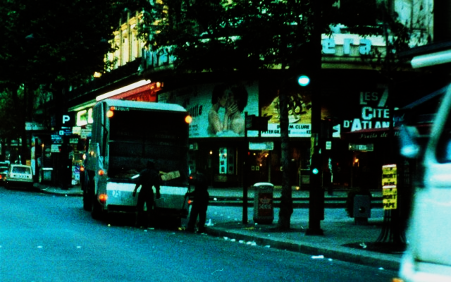
[64] Les Mains Négatives (1978, dir. Marguerite Duras)
The visual component of this short film consists of outtakes from ‘Le Navire Night’: shots from a moving car of Paris streets at dawn, their emptiness in some way linked to Duras’ sparse voiceover. The text puts forth a simple supposition about the prehistoric hand prints—‘blue for the sea, black for the night sky’—left in caves in Southern France, 30,000 years ago: a single human whose ‘negative’ mark is accompanied by a plea for human connection, a screamed ‘I love you’, announced to ‘those who have names, those who have identities’—‘to anyone who will hear me screaming’. Duras has him alone—the search for human connection that characterises all her work, but is presented in particularly stripped-back form in these short-to-medium lengths films of the late ’70s and early ‘80s (‘Cesaree’, ‘Aurelia Steiner’, ‘L’Homme Atlantique’). These films are concerned with the direct—though not necessarily answered, or even heard—address from an ‘I’ to a ‘you’: lover and beloved, speaker and hearer, director and audience. In ‘Les Mains’, ambient sounds from the footage are removed; instead, Duras’ voice and the solo violin that plays through it all, in one of the loops of short musical material she favours, as if tuning up, finding its way to a melody. The roving camera finds the Parisian streets themselves as a kind of equivalent to this mark—the traces of human existence with the humans removed. The humans we see are, in the main, the street sweepers and garbage collectors whose peripheral existence recalls the figures at the edges of roads in ‘Le Camion’ the previous year. The footage—at least in the online print I saw—was too blurred to make out much more than silhouettes, the rhythmic action of brushes, vague figures tipping rubbish sacks into lorries, but Renate Gunther suggests that they’re migrant workers: the film’s progression from night to the first traces of day, as white people start to appear, rendering the ‘negative hands’ those of the labour rendered invisible, carried out before the dawn, while at the same time resisting the binary thinking that would reinforce precisely that racialised division, that classed division that maps onto the spaces of night and day as labouring spaces. Duras’ voiceover here also serves to displace the mendacious lies by which ‘European’ identity—continental being—is tied to an increasingly exclusionary ideology, one which encourages migration for cheap and disposable labour while closing its borders and blaming those from its peripheries for its ill. So it is that Duras presents the lone prehistoric man in context of what she calls ‘the endless forests of Europe’. Europe itself is here estranged from its mendacious myths of dwelling, belonging (for some, not others). The prehistoric man is not the primordial Aryan ancestor but an outcast: civilisation, the permanence and question for socialisation implied by mark-making, is not the first step towards exclusion, conquest, division, exploitation, but the search for connection that continue in spite of those practices. As such, the film comes down to an expression of Duras’ theory of art—and of civilisation itself: the search for human connection and a sublimated scream for love that inheres in any mark-making, any mode of address. “I am someone who calls, I am someone who called, who screamed, thirty thousand years ago: “I love you”. I scream that I want to love you. I love you. I will love anyone who will hear me scream.”
(Longer write-up here: http://streamsofexpression.blogspot.com/2020/11/les-mains-negatives-1979-dir-marguerite.html)

[63] Vargtimmen / Hour of the Wolf (1968, dir. Ingmar Bergman)
The gaze direct at camera that, in Summer with Monika, breaks free of narrative framing, both creates and refuses implication and judgment, finds a very different sort of echo in Liv Ullmann’s direct to camera visual address in Hour of the Wolf. Bergman often shoots her face in extreme close up, going so far as to fill the screen with just the eye itself: an attempt to see into the heart of things which attains, if anything, more confusion than before. In the opening sequence, Ullmann’s Alma tells the unseen filmmaker of her artist husband, Johan (Max von Sydow), his descent into madness and his last days before his attempt to murder her and his apparent suicide. Ullmann’s opening direct to camera address, with its suggestions of the documentary interview following on a credits sequence that plays over the sounds of a film set, sets up a soon to be destroyed illusion of realism. Opening on-screen text suggests the entire scenario as a kind of found, collaborative document between Alma, who tells her story to the filmmaker, and the filmmaker, who ‘brings that story to life’. This framing both exacerbates this sense of potential realism and gives scope for the ‘subjective’ rendering of extreme mental states through surrealistic techniques that increasingly dominate the film’s second half. Bleached-out scenes of violence and anguish cut between diegetic and non-diegetic sound and disorientating edits which render the experience ‘dream-like’; horror is exacerbated through shock effects such the old woman whose removal of her hat necessitates removal of her entire face (an eye—the gaze again!—placed in a fancy tumbler), the man who walks on the ceiling out of ‘jealousy’, the predatory human who turns into a predatory bird (or vice versa), the naked, and sexualised corpse that comes to life. In the film’s climax, Von Sydow’s breakdown is rendered as a literal tearing about by manifestations of the inner demons he knows by the names of ‘ghosts’, ‘cannibals’. To what extent is this an inevitable by-product of the process of artistic creation (one popular myth), to what extent is art the product of enhanced / vulnerable mental states (another popular myth), and what, in any case, should the artist and their loved ones do outside the realm of the artwork? The film throws these questions up but doesn’t answer them, concerning itself not only with the boundary between inner torment and outer action–climaxing in the tormented artist shooting his pregnant wife–but the limits of loving empathy in the couple’s marriage, Ullmann concluding the film by wondering whether she loved her husband too much–an over-identification which led to her also seeing some of these ghost personages as real people–or too little, unable to save him from those forces he felt assailed him. And so we’re left with Ullmann’s gaze, once more refusing interpellation and judgment, yet abdicating her own strength of character—that which his enabled her to physically and mentally survive as what is in effect carework is rewarded with attempted murder—in favour of an endless rumination on the partner of whom she is finally free. Monika packs up and leaves the flat; Ullmann has stayed on, though she’s soon to move back to the mainland. It’s there the film leaves us, uneasily transitioning between departure and return, confrontation and escape, the soul (alma!) and the body, bleeding and torn apart. The film’s stare may be unblinking, but it doesn’t always seem to know what it’s seen.
(Longer write-up here: http://streamsofexpression.blogspot.com/2020/11/vargtimnen-hour-of-wolf-1968-dir-ingmar.html)
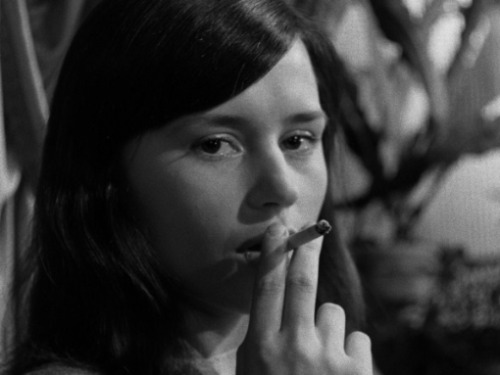
[62] Summer with Monika (1953, dir. Ingmar Bergman)
In Summer Interlude, the season’s symbolic end–and the end of the love affair that suffused it–has to do with loss and mourning, as the framing first and final thirds examine the afterlife of love in the ultimate impossibility of its continuance (the death of one of the lovers). In Summer with Monika, that impossibility emerges from within the relationship itself: the circumstances of social expectation, material lack, the waning of the first throes of emotional and erotic excitement, rather than the more existential-metaphysical fact of death. As such, though Summer Interlude is framed as the darker picture, Summer with Monika, its reputation in some ways resting on its bucolic sexual openness, is in some ways the bleaker film. Both of its teenager lovers, Monika and Harry, see each other as a means of escape from difficult family environments which are classed inversions of each other: Monika’s small working-class apartment, where she’s beset by noisy siblings and a father who alternates between drunken abusiveness and drunken joyfulness (too little space); Harry’s middle class suite of rooms, occupied by an ill and silent father unable to express his sense of despair at the death of his wife (too much space, becoming a gaping void). Monika’s and Harry’s rebellion, then, is a social as well as a romantic one: while the lovers in Summer Interlude stay in a pristine summerhouse and a gigantic mansion, here, they sleep on a boat and resort of stealing a roast dinner from a house, crawling around in the dark and mud, self-consciously modelling themselves on the romantic couples and outlaw heroes of Hollywood cinema and dimestore cowboy novels. (“You’re just like someone from a film”, Monika tells Harry on their first date.) But this escape can’t last–unable to support the family on Harry’s single, meagre salary and burdened by the baby who’s a product of that summer escape, class and gender roles reassert themselves. The final third is devastating, as we turn from the influentially energetic and bucolic summer to a mode more akin to social realism, Monika ultimately leaving after Harry first clumsily paws at her, then strikes her after discovering her cheating on him unfolds with a grim inevitability that ultimately goes beyond words. Most famously, of course, the film breaks from realism for a brief moment with Monika’s ambiguous, steady gaze directly the camera as she initiates her extra-marital affair, as if daring conservative audiences to judge and progressive audiences to ponder the social arrangements which lead to restriction and misery. Non-judgmental, unexpected and pitch-perfect.
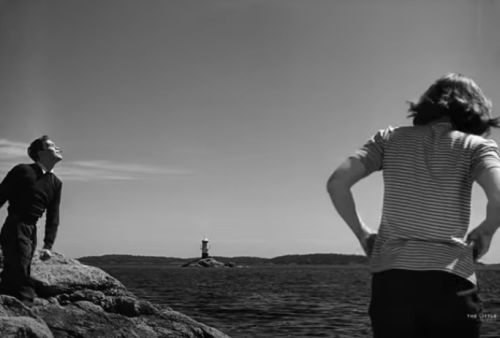
[61] Summer Interlude (1951, dir. Ingmar Bergman)
For much of its running time, Summer Interlude depicts in flashback a teenage romance in at atmosphere of lightness, sweetness, sun and light. The film at once revels in and critiques the dead-end of nostalgia: while filmic flashback tends to suggest that we can simply replay the past in the present, Bergman’s framing of these flashbacks also suggests the vicissitudes of memory, the palimpsestic alterations that are both re-readings and re-writings, not so much to decry them as fictions or to lament memory’s instability, but to explore ways in which past and present might be integrated in a way that neither melancholically disavows the past in a false ‘moving on’, nor remains immured in it, unable to face the present except with a diffident and distanced mask. Ballet serves as a useful index for the film’s consideration of the relation of art to desire, passion to sublimation, aesthetic temporality to that of personal memory. In Swan Lake, the figure of the lover turned into a swan serves as ready metaphor for the ballet dancer training their body in the service of aesthetic beauty: a metamorphosis—whether as sublimation or transmutation, or both—into the not-quite human that is ballet’s own uncanny fascination, from Swan Lake itself to Coppelia to Petrushka. Bergman’s film is more concerned with the back-stage movement that surrounds ballet as with ballet as self-contained artistic world: the world of theatre wings as much as the choreographed wings of Tchaikovsky’s swan-maidens. In Swan Lake, Siegfried stays faithful to his original, true love by throwing himself in the lake, thence ascending to heaven with Odette. The lover must sacrifice themselves for the memory of a past love in order to enter into the metaphysical eternity that at once symbolises futurity and abolishes time. The parallel moment in ‘Summer Interlude’ finds Marie apparently succeeding in getting the burden of the past off her chest by giving her current lover Henrik’s notebook and resolving to move on with a new emotional openness, as a flash of the free-spirited teenager returns and she pulls faces at herself in the mirror. This shift from tragedy to comedic resolution feels as jarring as that from lyrically-invoked bliss to tragedy upon Henrik’s death. Yet if these shifts feel jarring—however much they’re elegantly smoothed over with the technical accomplishments of cross-fades, carefully composed rooms, attentiveness to the dynamics of people’s relations to interior space—so too, beyond the world of film, our perceptual experience of time, and the sudden eruptions and disappearances of memory itself, at once willed and unwilled, can be jerky as much as smooth, close-ups as much as long shots, non-sequiturs as much as rehearsed and integrated narration. Based in Bergman’s own experience of summer love and autumnal loss, the film is a self-interrogation, a cathartic working-through of individual loss, an artistic translation of personal experience. What in daily life’s the border of experience, feeling, performance, self/representation? For all its apparent resolution, the film raises and leaves key questions such as these unanswered—for these are indeed the questions we might well ask in our daily inhabitation of the world.
(Longer write-up here: http://streamsofexpression.blogspot.com/2020/11/toothache-in-soul-summer-interlude-1951.html)
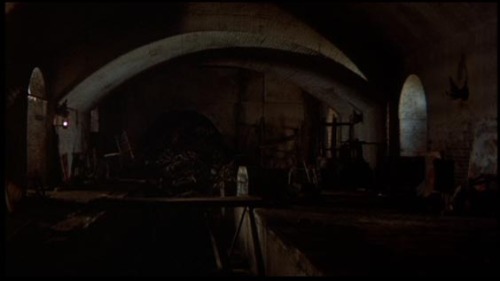
[60] Death Line (1972, dir. Gary Sherman)
Halloween viewing, and certainly the most melancholic gore film I can think of. The scenario is simple: somewhere under the now-upmarket territory of Bloomsbury, in an abandoned underground station lives the lone descendent of a group of workers left for dead after a cave-in in 1892. During the era of private competition to build new lines on the London Underground, the fate of these workers was neither cost-efficient nor of sufficient moral interest or outrage to bear much mentioning: simply another trace of the suffering, immiseration and abandonment of the city’s poor. Plague-ridden and deprived of speech, ‘the Man’ survives through cannibalism, making forays up the tunnel to the platform of a functional modern station, where he picks off late-night travellers. When a high-ranking government worker disappears, a police investigation is opened, soon involving a pair of young students and the inevitable encounter in the ‘monster’s layer’ which brings the film to its climax. Cannibalism here serves as limit-case of socially-produced abjection, a simple scenario, from which extracting horror, without resorting to the supernatural or overtly fantastic, is a simple matter, and suited to purposes of social commentary the more bluntly effective for its exaggeration of already-existent social fact. In the much-remarked 8-minute tracking shot of the cannibal lair that occurs early on in the film, the camera slowly moving over rats, corpses, antiquated equipment in a mood that evokes not so much outright horror and disgust as sadness and pity. Rather than a blaring soundtrack accentuating the jumps, instead the music plays at near sub-aural level, Sherman layering the tracking shot with sound effects—an amplified heartbeat, the drip of water, the ghostly sound effect of the original cave in, vague intimations of melancholic strings. At such points, removed from dialogue, the film is close, indeed, to the visual rhythms of silent cinema. In such sequences the film is dominated by gore, but, aside from a few brief jump scares, the film takes horror not as fright or dread but as melancholy, the limits to which humans will go to survive and the material fate of the body once life has passed from it and it exists solely as decayed flesh. While the corpses we initially see in gory close-up detail are those of the victims of cannibalism, another room contains those of the previous generations of abandoned miners themselves, expired from plague, starvation or the other hazards of living in an underground cave, laid out in their worker’s bunks in what passes for a cemetery, as Armstrong drapes trinkets from those he’s dragged to the layer over his departed comrades as memorial keepsakes: a necklace, a pocket watch, time in a world without time. Director Gary Sherman notes that the tunnels in which the company filmed were inhabited with numerous homeless people; the film transposes and alters these facts for its phantasmic scenario. Thus, though it was criticised for its plot incongruities—if there’s now a space at the top of the cave in through which the descendants of the cave-in can come up to Russell Square in search of ‘raw meat’, how come they still live down there?—yet this economic reality is not far from existing conditions. Who cares about the subsistence of those whose labour allows the city to flow? Who notices what falls through the cracks? The titular pun seems crass and obvious—though not as much as the trashy repackaged re-edit released in the States as ‘Raw Meat’—but, in its echo of the phrase ‘life line’, also suggests an instinct for survival and preservation, not as a Darwinian struggle, but as an attempt to preserve values of nurture and care even in a situation where individual survival is predicated on eating others in the group. In the climax, ‘the Man’ seizes on the only language he can phonetically repeat: ‘Mind the doors’—the mantra of practicality, politeness, keeping things efficient, hierarchical and moving—turned into a polyvalent line alternately of pleading, lament, questioning and pain, in a manner at first darkly comic, then, the more it’s repeated, the more questing and painful. When it sounds out again, as a yell after the police have left, in a nod to the classic horror movie trick—he lives!—it’s not so much a jump-twist as a howl of rage at the indifference to suffering manifested by M15 agents who hush things up, police chiefs who wisecrack at death, citizens who bypass the drunk or homeless, the callousness that passes for social cohesion, efficiency, respectability, and life.

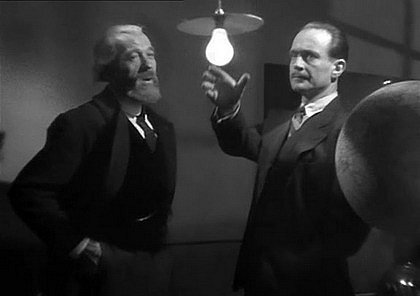
[59] Le Corbeau / The Raven (1943, dir. Henri-Georges Clouzot)
Clouzot’s second film takes up thematics later explored in ‘La Verite’: more communities on trial, more moral hypocrisy. But, if that film was overshadowed by the real-life media circus surrounding Bardot, whose hypocritical hounding it uncannily mirrored, so too this film has been overshadowed by historical circumstance–albeit with higher stakes. Produced in Vichy France by ‘Continental Films’–a German-backed French film company which formed part of the effort to Germanize cinema along Nazi lines, yet within this frame also enabled its filmmakers’ relative autonomy and freedom from censorship, rather than requiring Fascist propaganda–the film has a contested legacy as either furthering–intentionally or not–a Vichy or an anti-Vichy line. According to these views, the film–falsely reported to have been shown in Germany under the title ‘A Small Town in France’–pushes a Vichy and Nazi besmirching of French national character as venal corruption, thus implicitly requiring the iron discipline of Aryan occupation; on the other hand, it serve as anti-Vichy satire depicting the rot within petty-bourgeois provincial towns by which townsfolk turn on each other, anonymous denunciations placing the airing of simmering suppressed resentments, jealousy, vindictiveness, competition and opportunities for personal gain at the expense of a collective resistance to occupation. Add to that the less than respectful treatment of the Church, the non-judgmental presentation of abortion, the casual attitude to sexual fidelity and non-marital sexual activity, not to mention suicide, murder and the rest, and the film also fell foul of the Catholic moral conservatism and patriotism that might flow into either pro- or anti-Vichy sentiment. Both the pro- and anti-Vichy interpretations suggest an allegorical structure to which the narrative structure easily lends itself: that’s to say, the effects of a structure-challenging catastrophe from outside or within (think Camus’ ‘La Peste’) as diagnostic for what already lay beneath the surface of just another town, ‘ici ou ailleurs’, as the title credits put it. Two images. 1) The community, turned near-feral by the spate of poison pen letters, have got it into their head that the nurse Marie Corbin—already disliked for her status as single woman and for her lack of ‘feminine’ compassion—is the letters’ author and thus responsible for the suicide of the hospital patient for whose funeral the whole town has turned out. Fleeing to her room, she finds her belongings trashed, her mirror smashed, the words ‘in prison’ daubed on her wall; fleeing again, she’s taken away and locked up. Just as the letters themselves, the angry mob break the thin dividing line between privacy, individual secrecy—the unspoken assumption that one can be left alone with one’s desires, for whatever or whomever they may be (perhaps simply ‘peace and quiet’, as one character says)—and public knowledge, a transgression that hear leads to violence and condemnation in the name of a collective good that’s nowhere in real evidence. 2) Drs. Vorzet and Germain dialogue beneath a naked lightbulb which, set a-swinging within a schoolhouse (location of moral training, of the passing on of methods of knowledge and power) refuses to cast its light on any one area, to fix a target in object lesson, in a point of origin for ‘evil’, for actions which expose and destroy the false tranquillity of social relations, hierarchies, institutions. Vorzet—psychologist, claiming the essential moral ambiguity of the drives, condemning the tendency to moralistic judgment, apparently compassionate; Germain, the M.D., with the morality of the uptight bourgeois, emotionally closed-off yet motivated by trauma. The final Revelation: Vorzet himself is author of the letters. Murdered by one of his victims, his blood flows onto the desk where he’s writing yet another poison-pen, in a kind of destructive cycle which reveals both everything and nothing. Germain, his moral clarity shattered, opines that perhaps ‘evil is necessary’, exposing and bringing together the community—purgative? cathartic? a humanist faith a la ‘La Peste’? That would be to read too much between the lines: the film refuses moral/istic outrage through a mask of cynicism that nonetheless doesn’t preclude moral judgment. If this suggests both having one’s cake and eating it, it’s easy to see how such inscrutability might lend itself to the position of the filmmaker within the complexities of wartime occupation. In that sense, the historical circumstances that produced the film are precisely those which render it strangely illegible nearly a century on.

[58] La Vérité / The Truth (1960, dir. Henri-Georges Clouzot)
Dominique (Brigitte Bardot) is on trial for the murder of her lover, conductor Gilbert (Sami Frey). Was it a crime of passion or the logical endpoint in a life of selfishness and the inability to love? If Clouzot’s better-known vision of cynical machismo in ‘The Wages of Fear’ resulted from source material in another masculinist cynic-critic, here the collaboration with a team of female writers flips those odds. When Dominique is accused of having passed round a copy of De Beauvoir’s novel ‘The Mandarins’ in school, provoking the excellent line: “Who’s on trial here, Simone de Beauvoir?” If that real-life parallel has a kind of pleasurable fourth wall quality to it, the film’s very success in drawing parallels between its fictional narrative structure and the real world—specifically, Bardot’s own position within French culture—that lead it to be overshadowed by the real-life incidents in Bardot’s life that took place in the weeks leading up to its premiere: the real-life love triangle, suicide attempt and media circus, as Bardot was hounded by a combination of hypocritical paparazzi mentality, the brutality with which Clouzot treated his actors, and the impending threat of national service faced by new lover and co-star Sami Fry. In just one of these situational ironies, Bardot was accused by a prominent film critic, of in essence faking the suicide attempt as a pleas for attention, just as Dominique is accused—multiple times—in the film. La Vérité’s point was proved. But what of the film’s mode of narration itself? While some have described La Vérité as Clouzot’s Rashomon, the film’s moral scheme is more binary: an alternation between the guilty-until-proven-guilty cross-examinations of the courtroom, in which Dominique (Bardot), on trial for murdering her lover, is presented as a selfish traitor to familial and societal expectations, the epitome of Left Bank decadence, amorality and liberated sexual predation, and the real ‘truth’ of the incidents which led to this moment. Clouzot has faith that cinematic narration is able to tell the story of ‘human feelings’ (the plea of her defense lawyer) in a way that’s ruthlessly eliminated through the accepted—but no more ‘true’—distortions of statistics, supposedly objective facts, of bourgeois legal judgement and the climate of ‘public opinion’ (the combination of judges, lawyers, jury and press). Framed as a series of flashbacks from Dominique’s highly-publicized trial, these flashbacks occur, not so much from the perspective of any one character—though if they were said to be from ‘within’ that world, they would be those of Dominique—as from a kind of cinematic authority which both shows events (fact) and colours them with another kind of truth (emotion). For all of Clouzot’s judicious refusal to use a film score as emotional or dramatic crutch, it’s a piece conducted by Gilbert—the climax of Stravinsky’s ‘The Firebird’—that gives heft to the love story, framed in ways that burst in and out of the narrative frame: overheard in rehearsal, where Gilbert’s perfectionist breakdown of the piece breaks us from the spell of emotional immersion; replaying that music in grainy footage of Gilbert conducting on multiple television sets seen in a shop window; and then soundtracking Dominique’s return to Gilbert’s apartment as if playing out the emotional swells of film music conventions, not from the perspective of the film itself, but from inside Dominique’s head. Yet the film rarely sticks with Dominique as a ‘first person’—she’s seen (the Bardot image) and depicted, relentlessly narrated by others, and by the film itself, but not often given her own voice. Likewise, if the judge and jury are a rigged game, enforcing a pre-ordained notion of what constitutes ‘truth’—the hypocritical, moralistic (not ethical) conventions salaciously revelling in the details of passion—Clouzot’s own ambiguous depiction of the emergent world of youth culture is hardly heroizing, even if it, to borrow the legal pun, reserves judgement. Gilbert can certainly be read as exemplifying the hypocrisy of bourgeois masculinity—exercising erotic passion through a woman for whom he has intellectual contempt, before dumping her for the ‘spiritual’ passion of marriage to her sister (as Dominique puts it, ‘he wants you to darn his socks’): his jealous rages, his possessiveness, his refusal to acknowledge Dominique’s social needs while prioritising his own artistic vocation at her expense. Dominique’s Left Bank associates seem little better, though their friendships appear to have a depth heightened, rather than stymied, by their casual rejection of binding ties and commands of loyalty. In a sense, the courtroom framework enables such depictions to be left suspended, whatever the judgement of particular details—judgements that viewers are encouraged to make with and against those of the court we see on screen.

[57] Novecento [i.e. ‘Twentieth Century’] / 1900 (1976, dir. Bernardo Bertolucci)
I’ve seen it said ironically that Bertolucci’s analyst should really be credited as a co-director for most of his films: their working-through—or simply display—of contradictory and often problematic ‘theses’ (or perhaps simply feelings) on queer sexuality, masculinity, femininity, love and violence is at once a subject that entwines with narrative unfolding and a kind of immanent texture whose import it seems no one can quite fully grasp. But what does this mean when the film is ostensibly an attempt to depict the history of class struggle in Italy during the first years of the 20th century on a broad canvas? The film’s sexual politics seem at once central to its ‘argument’ about fascism and class struggle—if not in as programmatic a fashion as ‘Il Conformista’—and insufficiently connected. In the film’s final third, we shift from domestic drama to collective history and to the debates on liberation day as to whether or not Communist partisans should hand over their weapons, bringing the film into the centre of current political debate on the junction faced in the Italian political landscape at the time of the film’s making. And then a strange coda, returning to the central relation between the padrone (Robert De Niro) and the peasant (Gérard Depardieu) and, at the same time, a seeming shift into broader allegorical territory, as the aged De Niro/Depardieu pair stagger along by the train tracks, replaying their love/hate relationship from childhood. In the allegorical schema, the scene can be read in a fairly obvious way: because the Communist Party insisted that partisans disarm instead of expropriating landowners, the apparently ‘eternal’ love/hate conflict and parasitic relationship between padrone and peasant continues (“the padrone is alive”). That’s to say, that conflict—which has structured much of the film—has been socially produced, and its continuance, even in the apparently modernised post-war world, is a kind of regression (literally, the world of boys fighting). But so much libidinal investment is placed in that relationship—the life-long romance of the son of a peasant and the son of a padrone—that it seems to exceed such analytical territory. (“Hole in the pocket socialism” indeed…) Likewise, the structural mirroring and doubling—the padrone and the peasant patriarchs (Alfredo/Burt Lancaster and Leo/Sterling Hayden), their sons (Alfredo/Robert De Niro and Olmo/Gérard Depardieu), the socialist lover and the upper-crust bohemian lover (Anita/Stefania Sandrelli and Ada/Dominique Sanda)—establishes a structure of equivalence that emphasizes a kind of inter-class reciprocity and dependence as much as class war, made all the more murky by the libidinal investments. Perhaps this is a ‘way in’ for the audience—and the critical stratum of the international bourgeoisie; perhaps Bertolucci was more comfortable filming the decadence of the upper classes and bourgeoisie/petit bourgeoisie than the peasants, who come across as noble yet wooden stereotypes. The central questions, half-a-century on, remain hard to answer: what is this film trying to say, and who’s it for? It remains visually sumptuous, technically superb in its execution, ambitious and sometimes moving, sprawling and episodic, intensely memorable, perplexing, confusing, excessive in every way.

[56] Le Salaire de la Peur / The Wage of Fear (1953, dir. Henry-Georges Clouzot)
Holed up in the colonial margins (a stand in for Venezuela, shot in Southern France), a cross-European cast of cynics act as the paid flunkees for the union-busting, private police-enforcing, virulently extractivist US American ‘Southern Oil Company’, transporting two trucks loaded with nitroglycerine along 300 miles of virtually impassable mountain roads in order to contain an out-of-control fire resulting from an explosion on a distant oilfield. ‘The Wages of Fear’ was, of course, an undoubted influence in terms of shot construction, situational tension-building, and grim atmosphere on a large majority of (particularly American) thrillers to follow: to pick one technical detail, this may be the first appearance in film history of a particular breed of zoom, establishing a kind of nervy relation of part to whole, environment to scene, that became de rigeur in the 1970s. It’s a film with the memorable fascination of a nightmare, as its drivers manoeuvre the nitrogylcerine-bearing trucks at breakneck speed over bumps in the road, over rotten wood, through a vast pool of oil, and so on, in a series of increasingly dangerous and desperate set-pieces. While this situational tension is what’s led to the film’s reputation, the narrative and emotional relations of its characters are perhaps just, if not more telling of its vision: a Céline-like cynicsm, total and overbearing, in which American imperialism is by no means the film’s only target; a structurally misogynist vision, exemplified in the relation of Mario (Yves Montand) to the film’s only female character Linda (Véra Clouzot). This brutalised, masculinist sexual politics is based on the disavowal of affection and physical eroticism between men, manifesting in the romance between the younger, brash, tough and cynical Mario and the older, circumspect, apparently charismatic Jo (Charles Varnel), enacted in misogynist dismissals of any ‘feminine’ weakness, whose physical expression can ultimately only be violence, taunting and the code of the toughest—as when Montand strikes Varnel down, proclaiming ‘it may be not be right, but I’m the strongest’; or when the death of their other two companions on the road is dismissed as par for the course, part of the hazard of the job, another indifferent moment in the battle to survive. Cluzot’s unremitting cynicism, like that of Céline, extends to those in authority—particularly the corruption, brutality and quest for profit of colonial authorities—but unthinkingly (or, what’s worse, deliberately and thinkingly) reinforces racist and misogynist assumptions and envisions no other future: a brief scene of workers agitating against yet another death in the oil fields is greeted with the lazy ‘what’s this, a revolution?’ as our ‘heroes’ wander onto the balcony in their underwear, and the brief shots of Brazilian native occupants in shacks or wandering the streets that open the film and that appear at various points in the narrative are presented with a kind of unseeing landscaper’s touch. Beyond a cynical expose of the workings of North American imperialism in the South of the continent, the film’s position is that of the cynic—the ‘exposée’ of all forms of power and ideology as both venal corruption to be judged and the Social Darwinist order of things—whose apparently clear-eyed vision in fact blinds them to the actual operations of racialised, gendered and imperial power. These characters, exiles from the sub-proletarian fringes of the imperial centre, whether in France or elsewhere (and note the profusion of languages in the film’s opening section), are motivated by a desire to escape the place they’ve ended up, stuck without money for airfare, but their place of origin—remembered with a tint of nostalgia, the casual patriarchal swagger of a whistled Maurice Chevalier tune or an outdated metro ticket—is no more than a pipe dream, the cynical pathos of that outdated metro ticket in the bloodstained fingers of an anti-hero arbitrarily driven to their death in the film’s final shot. The dying, oil-smeared Jo, trying to remember what lies behind a fence on the Parisian street on which he used to live, proclaims ‘there’s nothing’. But of course, in reality there’s something: not the sub-existentialist struggle, not the nihilist absence of value, but the quest for oil, money, the exploitation of periphery by centre, the planned underdevelopment, the rapacious extractivism of a centuries-long imperial project and its attendant, structuring myths. The stripped-down tension of the film’s major part is what’s remembered—particularly as the more explicit depictions of U.S. imperialism, allusions to gay sexuality, and the like, almost all occur in the film’s opening sections—but this apparent cutting away to the ‘truth’ of the matter is its own sadistic fantasy. Clouzot may reject pathos and sentimentality as the lies by which imperialism cloaks its own brutality, but the film’s alternative is close to a sadistic revelling in that very same brutality, a situational irony which leads, not to outrage or anger, but a kind of pleasurable frisson which ultimately throws up its hands to proclaim, with Jo, ‘there’s nothing’. Thus, the films ends with a kind of coda: a totentanz juxtaposing a barroom dance in anticipation of Montand’s survival and return, and Montand’s own dangerous ‘dance’ with truck on road leading to its careening over the side, soundtracked—in a film that’s otherwise virtually without music—to the tune of a mythologised European imperial elegance destroyed by successive world wars, Strauss’ ‘The Blue Danube’. If Clouzot’s cynicism served him well in explorations of the hypocrisy and yes, misogyny, of provincial and metropolitan France—the school of ‘Les Diaboliques’, the courtroom judgements and media circus of ‘La Vérité’—here, it becomes a modus operandi that has more in common with the structures it purports to critique than it (or its devotees) might care to admit.
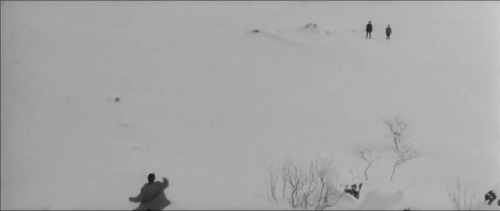
[55] Juhyô no yoromeki / Affair in the Snow (1968, dir. Yoshishige Yoshida)
Yoshida presents us with a world of snow, of blocked, directionless, staggering movement; faces, shadows, body parts cut up into near-abstract compositions; miniaturised figures stumbling through snow on a seemingly pointless quest, as if the landscape can’t wait to erase any trace of their presence, these figures who don’t even cast a shadow. The framing resolutely avoids indices of intimacy, both in terms of in-camera movement and the juxtapositions of montage, of editing and post-production. Thus, while the camera is generally static, several scenes notably deploy extensive hand-held camera motions, swirling around characters with a kind of roving curiosity that often moves away from the character delivering dialogue to focus on apparently inconsequential detail—an unmade bed, the corner of a room—with a kind of anxious inaccuracy that doesn’t heighten voyeuristic intimacy (the feeling that ‘we’, the camera cipher, are in the room with the characters) so much as reinforce difference and distance. When the camera’s not moving, Yoshida shoots faces to the side, from above, behind windows, in mirrors, cut off by the cropped angles of furniture, and the like; or otherwise isolates the figures in deserted streets, landscapes, indeterminate spaces. The film sets up a series of parallels—spirit and flesh, ‘platonic’ and physical love, potence and impotence—constructed around male anxiety, jealousy and possessiveness. I was never yours, “you only passed through my flesh”, the film’s female protagonist informs one of her lovers in a final gesture of rejection. Yet the choice between the platonic/impotent and erotic/potent operates on terms are set by a heteropatriarchal view, by a binary and dualistic thinking which reifies biological capacity as a kind of base overlaid and intermingled with the superstructure of erotic or romantic love. The film tries to find a way through these questions of platonic idealisation (love as spiritual) and physical degradation (love as physical). In Yoshida’s next film, ‘Farewell to the Summer Light’, these questions of futurity and the recapturing of the past are posed in more explicitly historical terms, as a formative generational trauma—that of Hiroshima and Nagaski—begins to name itself. In ‘Affair in the Snow’, we’re left with a perpetually stalling car, the perpetually changing trains, the frozen coal hammered out of the carriage by the relentless rhythm of multiple hammers: a carpet of frozen brightness, an end title, a death, scream that resolves nothing.
(Longer write-up here: http://streamsofexpression.blogspot.com/2020/10/you-only-passed-through-my-flesh-affair.html)

[54] Akitsu Onsen/ Akitsu Springs (1962, dir. Yoshishige Yoshida)
At the very end of the Second World War, Shusaku Kawamoto (Hiroyuki Nagato), a traumatised, tubercular soldier is nursed back to health by innkeeper’s daughter Shinko (Mariko Okada), in rural Akitsu Springs. One failed suicidal pact later and he’s left, thus beginning a futile process of recreation, as he periodically revisits the Inn, now managed by Shinko after her mother’s death and living in hope of his never-to-be-permanent return. This is melodrama taken to its zenith, as an endless series of (anti)climaxes, each time accompanied by the three main themes of Hikaru Hayashi’s score associated respectively with the stirrings of mutual passion, the dread of the suicide pact, and the strains of yearning and waiting. It’s a kind of paradoxically minimalist maximalism: melodrama as a ritual of repetition, of the same overblown gestures, from the lovers fleeing and chasing each other, literally striking poses as if in theatre, opera, ballet, to the more banal rituals of renting a room, drinking sake, smoking a cigarette, going away without saying goodbye. The film turns the melodramatic ritual of parting into a kind of repeated tic, ‘you hate to see me leave’, ‘let me see you leave this time’, as Shisaku’s repeated avowals that this will be the last time ring more and more hollow and the relationship itself becomes more and more a cipher for a lost moment of possibility that was, in actuality, the encounter of a traumatised, suicidal soldier caught in the thick of war and a teenage girl saddled with a kind of empty mythology less about the specific love object—whose qualities can hardly have been revealed in much detail over the space of a few days (or 20 minutes of film)—as the about the idea of feminine waiting and masculine arrival. ‘I’ve done something! I’ve saved a life’ becomes ‘I’ve done nothing’. In the merest fragments of carefully off-kilter composition, Yoshida at times anticipates the deliriously off-centre framings of the later radicalism trilogy (perhaps most notably, ‘Heroic Purgatory’): we see Okada between window panes as a in a prison, shot in profile from the side at odd angle, faces crammed just too high or too low onto the screen, the close-ups suddenly too close, the familiar settings of the film suddenly too claustrophobic. But that’s not where the real subversion lies: rather, even in this exercise in high budget repertory film making, the contradictions within the form itself are stretched to their limit precisely by being inhabited so fully, while also remaining palatable as a mere exercise in following the demands of the genre to the letter. And thus, by flattening out and removing narrative motivation, by not developing the romance, by rendering the narrative a series of performances, gestures and affects rather than any sort of theory of love—all while sticking to the conventions of rich costume, colour, music, grand event and grand feeling—the melodrama starts to collapse from within.
(Longer write-up here: http://streamsofexpression.blogspot.com/2020/10/ive-saved-life-ive-done-nothing-akitsu.html)
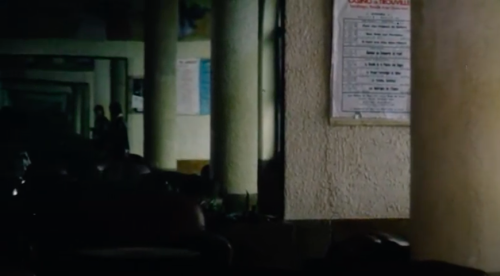
[53] L’Homme Atlantique / The Atlantic Man (1981, dir. Marguerite Duras)
Cinema as a kind of impossibility, a final impasse which the film seems to consciously enact; in which image has been replaced almost entirely by sounded text; in which the desire for image and its withholding are paralleled to an ended or unrequited passion: a love letter, a letter of farewell, a philosophical meditation on the medium which read as a kind of relinquishment enacted in a mood of calm despair. The text, predominant here in a way that surpasses even Duras’ previous films—the independent, non-diegetic soundtrack of ‘India Song’, the scripted rehearsals of ‘Le Camion’—is a kind of address with no answer, addressed to ‘vous’, the ‘Atlantic Man’, constantly spoken to, never heard from, barely seen. For most of the running time all we see is black screen, with glimpses (outtakes from another Duras project) of the transitory space of the hotel, the man gazing out to sea or passing in front of a mirror which also captures the camera and its operator; shots of an open window and the rolling-in of the waves. All through, Duras’ voice continues at the same speed, reflecting on the calling to presence or relegating to absence of her addressee, always addressing these thoughts to ‘vous’. ‘Vous’ here might at first seem to refer to a generic performer—‘actor’ seems not quite the right word—one of those bodies Duras places in a space, to be glimpsed to the side, not quite illustration, not quite embodiment of a not-quite realised scenario presented as if in perpetual rehearsal (‘Le Navire Night’, ‘Le Camion’). But with the appearance of the face—that of her companion Yann Andrea—and with the emotional tenor the text increasingly takes on, the film becomes more starkly personal, at once the potential for a kind of private revelation and a kind of private inscrutability, the self-enactment of a failure to communicate, a gap, a void. At the same time, the film forces us to ask whether the ‘Atlantic Man’ is Andrea ‘as’ himself, and as per his relation and meaning to Duras, or whether he’s there as ‘actor’, as a generic or fictional personage, and what those distinctions might mean. (One litany describes ‘vous’ in terms of his attempt to distinguish himself from every other living thing, from the ‘heap of men’ ‘hurling’ themselves into annihilation through war and struggle or simple existence). Whether ‘as’ Andrea or, more capaciously, as ‘vous’, he becomes incarnation or ideal, representation of desire, of a loved or impossible object; the occasion for or of the painful emotions of any ending love story, yet in a more diffuse sense than that occasional scenario would imply. Duras pares visual content back to almost nothing, the ‘poverty of means’ mentioned in ‘Le Camion’ taken to an extreme more akin to structuralist film. Look until you go blind, try to forget, she instructs as the film opens—which, in the absence of image, sound like instructions to the audience as much as to anyone else; look into the camera, you’ll forget it’s there; forget yourself. Cinema as impossibility, impasse, relinquishment: not a calling to presence, but a willed self-forgetting; not a means of preserving the moment and movement of the performer, a benediction against death, but a register only of that moment’s pastness, its annihilation.

[52] Le Camion / The Lorry (1977, dir. Marguerite Duras)
The relationship between film and narrative severed-or alternatively reinforced. Duras reads a script to Gerard Depardieu in her house. The script describes the scenario for an imaginary film in which a woman hitches a ride on a truck by the sea and launches into a monologue-with occasional interdictions, responses, questions from the (male) driver-sometimes closing her eyes and launching into song, observing the landscape (apparently inaccurately), hinting at stories, providing vague hints of a family connection (the birth of her daughter’s child), a love affair, her disillusionment with the present state of Marxist politics, the complicity of the proletariat’s official representatives with those of the power structure they ostensibly seek to overthrow, ‘ruin’ the only politics. Duras describes this in the conditional tense-this is what she would have said if we had made this film-yet this description is itself scripted, everything under a tight control belying the vagueness, the dissolution, the aimlessness imparted by dialogue and scenario. Depardieu’s questions seem, too, to be scripted, his and Duras’ eyes fleeting downwards to the pages of script they held even when the dialogue appears spontaneous. They are not the female passenger and the male driver, but of course they cannot not be read as analogues. The film cuts between Duras and Depardieu, filmed in one setting at night, in another at dusk; between shots, filmed from a moving vehicle, of the landscape-factories, lorry parks, the edges of towns constituting neither the urban built environment nor the rural; spaces of transport and passage-and shots of the titular blue lorry travelling through it, Beethoven’s Diabelli Variations intermittently coming and going as if on the truck’s radio. Duras notes in her script that the film could be shot in various different locales-all of them outside the metropolitan centre, through-spaces, neglected spaces, a 'land of migrants’. As such, they destabilise notions of national belonging, of the power relations read into landscape, while suggesting the fate of the economic periphery, that to the side of dominant narratives, in a manner far removed from the conventional representational framings of social realism, cinema verité, and the like. Like the room in which Duras and Depardieu read, the script describes the lorry’s cabin as both darkroom and prison, safe house and space of incarceration. Is this all an extended metaphor for the 'fellow traveller’? Or a kind of ‘politics of ruin’ that remains utopian: the film that would have been-yet which, in its rehearsal, retelling, conjectural description, is a film-is that stand in for the idea of revolution, of a non-derailed, non-betrayed communism that refuses compromises with the established order, in what Duras describes as a bargain between capitalism and socialism, “the infinite delay of any free revolution”. “Several explanations would have been possible”.
(Longer write-up here: http://streamsofexpression.blogspot.com/2020/10/what-would-have-been-film-le-camion.html)

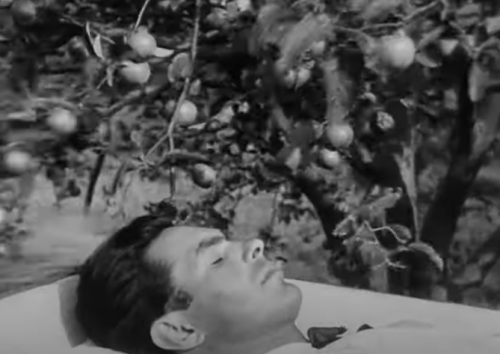
[51] Earth (1930, Alexander Dovzhenko)
Death, birth, funerals; the hero dancing down the road alone in the mist, only to be struck down by a mysterious force; faces in close-up gazing off screen (at each other? at the future? the past? at us?); the film tethered in some sort of nether-region, outside of time, the taste of fruit in the mouth of a dying man, taking his last bite of an apple, dying with a calm forbearance, as his grandchildren play with apples on the ground; the persistence of his friend with his ear to the grave to hear news as to which realm the spirit has departed; the camera’s attempt to capture the intangible, not as the outmoded forms of religion the film denounces—climaxing as it does in a funeral with no priests—but in the filming of landscape, soft focus blurring the edges of objects or capturing them in sharp-soft close-up; wind in the corn, apples in the rain. In a film where the metaphors of death and new life are shoehorned into the propaganda narrative advocating the willed/forced collectivisation of farms, Dovzhenko’s real focus seems to be more broadly on the nature of life and death, with the harvest as a kind of bridging metaphor: from the opening scene of the grandfather’s peaceful death to the apples, sunflowers, rippling wind of the close, in which humans have disappeared altogether, it’s about incorporation with and into landscape, about negotiation with the natural environment, about what it means to live and what it means to die. Dovzhenko, most of whose siblings died in childhood, wrote that he could hardly bear to think about funerals as a consequence, but that all his films in some way centre on them. Here, it’s that of the murdered proletarian and collective farming advocate Vasili, whose funeral, attended by the entire village, is to be held without a priest, with workers singing ‘the new songs’; an occasion made strange by its hyper-extended montage—Vasili’s mother giving birth; his fiancee’s dance of grief, ripping off her clothes and pounding the bed, the walls, herself; the mocking danse macabre of the kulak who murdered Vasili, and who mocks Vasili’s own dance in the moment he was struck dead; the funeral oration, presenting Vasili as a martyr to the cause of collectivisation, and heralding the Communist aeroplane flying overhead and offscreen…And after this panoply of human movement, moment and interaction, in which montage makes new and making strange in a way that’s only partly dialectical, the film moves way from the human altogether, back to the titular earth, to the apples, the fields, the recurrent image of the wind on the cornfields, sun through clouds, light, shadow: an attempt to film the intangible by filming the tangible, the concrete, the present; a materialist film about life and death that yet hints at something beyond the realm of matter, suspended in ruminative reflection, taken beyond the limits of narrative, a movement from prose to poetry, poetic prose, prosaic poetry, calm motion and motion in calm.
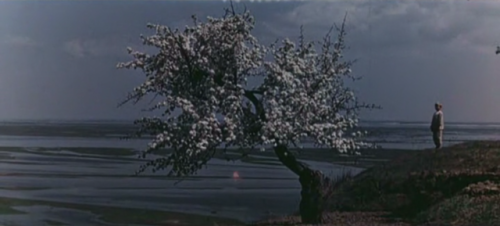
[50] Enchanted Desna (1964, dir. Yuliya Solntseva)
Solntseva’s adaptation of her late husband Aleksandr Dovzhenko’s autobiographical sketch for a personal film is less a conventional auto/biography than a kind of eruptive ode to place which, like the titular river itself, flows, eddies, occasionally bursts its banks; in which the rhapsodic exceeding of linearity, memories as they come to mind, sensations, sketches, truncates and transcends narrow biographical cliches. The film takes place in three time frames, three worlds, all centred around the river. There’s the murky, smoke-and-fire-filled landscapes of wartime Ukraine, in which even daytime seems to be nocturnally shadowed, and in which night’s own shadows are relentlessly punctured and punctuated, not by stars or night birds, but by explosions, and a haranguing monologue by the ferryman who accuse the fleeing Ukranian soldiers of abandoning their land, of capitulation to the Nazis. Then, brought to life from Aleksandr’s memories, deep in the heart of wartime, those sequences from which the film is most remembered—the ecstatic memories of a childhood marked by poverty, by a relentless engagement—half battle, half love affair—with the natural forces of the river, of the tending of the harvest, the crop—sunflowers, apples, blossoms—rendered in a symphony of scythes, flowers, floods. Finally, an epilogue set in a giant dam-building project, poised, like the film as a whole, between a rapturous paean to natural forces—particular that of the titular review, filmed in glowing sunsets and hazy long shots—and a techno-futurist proclamation of taming those forces (with a somewhat clunky definition of dialectics—as ‘the transition from past to future’—shoehorned into a conversation between engineers). Across these three periods, Aleksandr at times seems to be, as he claims at one point, an artist, at others a soldier, at others an inventor or engineer. All three, it’s suggested, are roles in which the imagination is central, in which the sometimes ruthless demands of practicality must never overwhelm the demands and desires of memory, of relationship to place, of an imbricated geological understanding based, not on domination, but on a kind of give and take. The film is explicitly both constructed on a (literal) journey from infancy to maturity, mapped onto Ukraine’s progress towards an enlightened Soviet future named as Communism; yet implicitly, deep within its form, it insists that temporality, within this poetic sensibility, is more porous. Breaking off from his wartime memoir-writing in self-critical awareness, Aleksandr notes the presence of the three editors inside his head, one behind his left ear, one behind his right, one in front, and wonders if his recollection of seeing a lion on the riverbank during a night-time boat ride was mere fantasy, and that writing on lions diverts from the realism he seeks to convey; yet the mangy horses his family owned cause too much shame to be suitable subjects, and in any case, a lion did escape from the circus one year, heading for the river, Aleksandr supposes, because it was fed up of the eternal round of exploitation in the circus. While Aleksandr’s chosen mode of expression lies in words, and despite the ever-present voiceover—and the insistent over-production of meaning in the bombastic musical score—the film’s most memorable moments are visual, in excess of a single or singular message (and thus more properly dialectical than any clunky Stalinist reduction of philosophical method to ideological trope). The infant Aleksandr rushing through fields of giant sunflowers, blossoms, shaking apples from tree, having visions of lions, visions of talking horses bemoaning their exploitation by the humans who take out their own frustrations on them, the camera moving and diving on a child’s or a god’s eye-level, sweeps of landscape, details rushing forward to meet the camera as an active agent of perception motivated by the excitements of the moment and the longer sweep of history. The film is set up as one about teaching and learning—as Godard said in 1965, “[this is a film] about which I don’t know what to say critically, which give me the feeling of having a lot to learn”—yet what it teaches, and what we might learn from it, emerges as much from the relentless horizontal spread, the bursts of brighter-than-life colour or murkier-than-life night, the exaggerations, distortions and reflections that, presented visually, can’t be captured in verbal argument. As well as a hymn to the river, one might say that Solntseva’s film is a hymn to film itself.

[49] Natvris Khe / The Wishing Tree (1977, dir. Tengiz Abuladze)
The father who spends the film searching, first for the ‘sacred stone’, then the ‘golden fish’, then the ‘magic tree’, and who ultimately freezes to death in his quest; the white horse dying amidst a field of poppies, a tear running down its face; the shoe flung into the air that ‘turns’ into a bird—shot in sumptuous brightness: this is a film which above all establishes an atmosphere, a mood, a wealth of incident in which telling detail gently emerges then fades. The film gradually finds its focus in the portrayal of Marita, the orphaned teenager who serves as the idealised symbol of female innocence and joy, of communion with nature and living things: every thing is alive, she proclaims on a mountainside; the dew is the sweat of the earth; stars and flowers are gifts, expressions of joy. Torn from her affair with Gedia, taking place in fields and on mountaintops, and betrothed to business-minded Shete, the film ends with Marita punished for reuniting with Gedia by being dragged through the village backwards on a donkey while the inhabitants pelt with her mud and stones. Shot in swirling fog and rain, with each member of the village appearing alone or in groups to the accompaniment of electronically-amplified and treated drips, groans and roars, the apparatus of civilisation—houses (however crumbling), roads, fields, livestock—of the relatively pain-free social life we’ve witnessed beforehand, are stripped away to reveal the dark heart of patriarchy that binds this community together, with Marita collapsing dead in the mud. The village, previously a humorously-rendered hotbed of gossip and humour, constructed around the loneliness and gender imbalance that humour patches over, turns, even, into pleasure, can only maintain this balance, it seems, through an act of collectively-binding violence. Of the few dissenting voices, the film’s club-footed anarchist, ‘Rebel Ioram’, has envisaged in bursts throughout a world beyond transactional patriarchal arrangements, the invocation of a mythical national past, and superstitious localism. Likewise, Gedia’s and Marita’s love for animals, their love for each other bring out the potential instead for a holistic relation between people, and between people and environment; even Ertaozi’s doomed and in many ways foolish, yet harmless quests search for something better, transformative, utopian. If all of these isolated figures end up literally trampled by the community’s assertion of normative order—Ioram beaten into the mud, Gedia shot, his body falling ignobly into a puddle, Marita expring in the mud, Ertaozi frozen dead at the base of a tree—the film nonetheless suggests that it’s their hopes that will outlive the repressive aspects of community; will, perhaps, form the basis of a newer and more just society. The film’s epilogue informs us that, on the site of Marita’s body, a pomegranate tree has grown up—the sacrificial rite exposing the fact that the wishing tree the characters had sought was in their midst all along, destroyed by their cruelty and adherence to repressive convention: a kind of mystic transformation of an idealised feminine beauty which seeks to reverse the community’s own punishment of challenges to patriarchy. If the epilogue feels stitched on—manifesting a more general problem with film’s uneasy balance of a general realism and a more archetypal folk register, between a kind of rambunctious humour and a more delicately poetic reflectiveness—the film’s preponderance of image, anecdote, incident nonetheless sticks in the mind: traceries of a spider’s web caught in light, flowers emerging from the rock, figures from the fog.
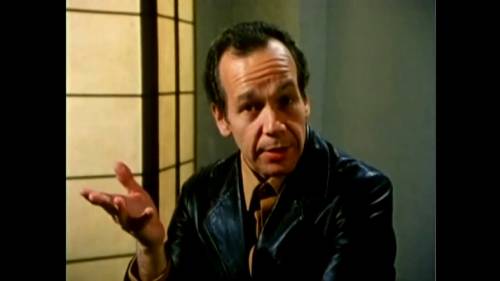
[48] Lift the Bandstand (1985, dir. Peter Bull)
This brief documentary on Steve Lacy has a bare-bones structure entirely appropriate to its subject: compact, precise, and searingly effective. Rather than a succession of talking heads, Bull relies on a single interview shot in a studio where Lacy also performs two brief solo pieces: I’ll try to keep it short, Lacy drily observes at the start, before preceding to detail his entire career thus far. Telling his story in characteristically precise, logical fashion, he doesn’t dwell much on jazz wars, politics or social circumstance except in brief allusion, touching on inspiration (he abandoned the piano after finding his hands too small to be Art Tatum; hearing Sidney Bechet prompted him to take up soprano saxophone); apprenticeship in bands playing the older forms of the music; finding his compositional voice through his work in modern music with Cecil Taylor and the Gil Evans Orchestra, and in the deep and patient study of Monk’s compositions, the latter in particular a life-long resource; constructing a style built on both ‘taming’ and channelling the soprano’s capacity to wildness, shrillness and ‘hysteria’, and the like. The gem of the film, though, is the footage, from a 1983 concert, of Lacy’s long-standing quintet with Bobby Few, Jean-Jacques Avenel, Oliver Johnson, Irene Abei and Steve Potts, which, rare in a film of this sort, is given space to breathe in lengthy sections that present near-complete pieces (settings of Blaise Cendrars and Bryon Gysin). And those performances veritably lift the bandstand, as the title—derived from a gnomic performance injunction once given Lacy by Thelonious Monk—puts it: most notably, early on in the film, as Lacy’s piece ‘Prospectus’ moves from the clipped, weird, interval-leaping composed melody to the simultaneous soloing of Lacy, Abei (first on voice, then violin) and Potts, as one pays attention first to one line, then the other, the camera cutting between them as if unable to decide, and the whole thing then just washing over, an intricately, ecstatically knotted whole. “When it’s right, when the music really takes place, well, you’re gone, the musician is gone, and it’s just like…Well, it’s just like paradise. Paradise must be like that”.
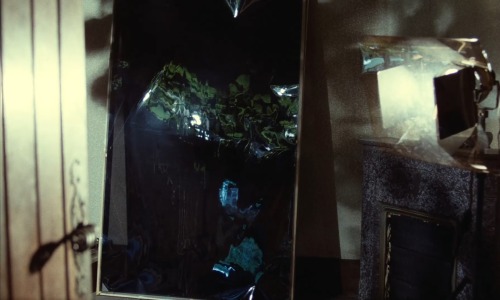
[47] Le Navire Night (1979, dir. Marguerite Duras)
‘Le Navire Night’: Night as ship, the talk at the end of sea but the shots of land, Duras’ characteristic slow-panning camera the only waves there are those of wind amidst woods, grass, the baroque explosion of statues on the face of a chateau, streets deserted at night, empty at dawn, the space of human inhabitation free of their inhabitants. Instead, the mechanism of films, of theatre, of narration (the story told here was almost simultaneously released as a prose text, a play, and a film) is constantly drawn attention to: shots of a blackboard on which are written the lines we have just heard spoken; an early and mysterious shot of what is revealed to be the lighting apparatus for the shots we go on to see (above); a slow track across a red dress we then see Dominique Sanda wear; talk of the film that could not be made, as the actors seem in perpetual rehearsal, having make-up applied (by Duras’ herself, her hands coming in from the edge of the shot as the actors appear to be about to speak, their mouths opening but remaining silent), asking her questions about the narrative they ‘re-create’, closing their eyes as the story describes. In that story itself, we find characters rendered only by acronyms, Duras’ perpetual man and woman, encountering each other through an unlisted telephone line and conducting an affair that, for years, is all talk–an endless phone conversation at night, a ‘cry’ that would be made worse, rather than solved, by meeting, even by the material trace of a photograph one sends the other; the woman dying of leukemia, an heiress, bed-ridden, forbidden to leave the house; once more, desire sublimated into endless stories, any or all of which may be true or untrue, landscape or urban-scape, the space of abandonment or habitation, characterised by Duras’ slow-roving camera by perpetual absence. In the story–recited by Duras herself, along with assistant director Benoit Jacquot–the phone conversations are, in a sense, rehearsals for the meeting that never comes and would betray them; likewise, the presence of the actors in the house/’set’ here do not so much enact roles or characters as hover on the edge of enactment, the shift from spoken word into visuality on which Duras’ films and which she seems to distrust. All the elements of film–words, actors, faces, settings, lighting, costume–are presented as separate entities–a musician is occasionally glimpsed or heard like a whisper playing a simple piano figure, echoing the endless melody of ‘Baxter, Vera Baxter’–the film carrying on after the end of the story to describe the impossibility of making, or ending a film (the same thing); ships that pass in the night or the ship that passes in the night, talking against absence, death, across the distance those very words maintain.
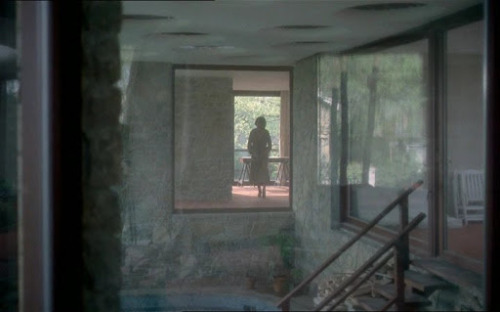
[46] Baxter, Vera Baxter (1977, dir. Marguerite Duras)
Over a slow hour and a half, Duras’ film unfolds in three scenes: narrative openings at a hotel bar introduce us to the absent figure of Vera Baxter, who waits in a large and empty villa she’s set to rent; in the villa, Vera is visited by the former mistress of her husband, the enormously wealthy Jean Baxter; subsequently–in the film’s real centre–the stranger (Delphine Seyrig) who’d heard Baxter’s backstory at the hotel turns up at the house un-announced, listening in on a phone conversation between Baxter and her husband in which, with apparent, but unconvincingly finality, Vera announces that it’s over, and then, in the subsequent, lengthy dialogue, insists that Baxter–who admits to frequently lying–will reveal her ‘secret’. All this to slow pans around the enormous, clean, empty and arid villa, paid for with Jean’s money; shots of the beach where Vera grew up; and of Thionville, the town where she now finds herself: sea, ruins and woods, emptied of people, but with an incessant, endlessly looped piece of South American music for pipe, guitar and handclaps, described by the characters as the sounds of a party from the villa nearest the sea, and in the film somewhere between diegetic and non-diegetic, real and hallucinated, ambient suggestion and maddening itch, a fly that won’t go back out through the window. The revelation, if revelation it is, that Vera’s one extra-marital affair was in fact set up by Jean as payment for a gambling debt reveals to a greater and more shocking extent the prison which is this bourgeois marriage–a marriage to a man, friends of her brothers, met as a teenager, enormously wealthy, but, according to Vera, a man who ‘has money’ rather than a ‘rich man’, who compulsively spends on gambling and on women in order to cover for his own lack. Vera in turn serves as accoutrement to the house (already paid for by Jean before Vera has even decided whether or not to say) as accoutrement to wife as accoutrement to husband, a financialised transaction in which sexual encounter serves as a payment for a debt between men, in which any act of freedom or defiance seems already circumscribed in a vicious circle of icy control. Vera has been sitting in the house, refusing to the answer the phone to her husband, her lover, the estate agent, contemplating suicide. But towards the film’s end, the stranger tells her of the women who waited for their husbands, on holy wars or crusades, who learned to communicate with animals and forests, who were burned at the stake: one of these women was Vera Baxter, she informs her, in a flash of analysis that brings together the film’s glacially, even languorously excoriating demolition of patriarchal marriage. At the film’s end, the two depart for the hotel in town, not so much in sisterhood or escape, but with some slowly deepening knowledge beyond the incessant lies, tellings and re-tellings that both entrap and, perhaps, contain the seeds to understanding, itself the seed for liberation.
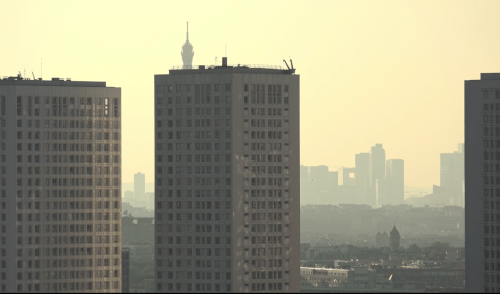
[45] In My Room (2020, dir. Mati Diop) [short]
A COVID-19 lockdown film, it’s hard to tell what this will look like at a different time. Diop turns the format—a commissioned film for a fashion brand—into a meditation on confinement, community and family. Recordings of conversations with her late grandmother about loneliness, dying and opera play over lockdown diary-style footage of Diop’s own tower-block flat and its environs: the claustrophobic spaces of fridge, bed, sink, desk and window alternating with shots of sunsets, flying birds and neighbours in their apartments that are at once gestures to film history and trope (say, ’Rear Window’, or the use of natural landscape as corollary or contrast to human habitation and drama) and a kind of reflex gesture, a search for beauty in confinement, that’s at once resonant and desperately empty. The relentless force of loneliness in the recordings are echoed in and commented on by the footage, even as they also comment on it: all the while, a kind of distance is established so that the connection feels at once necessary and abstract, natural and forced–a mood, above all, of ambivalence and temporal uncertainty.
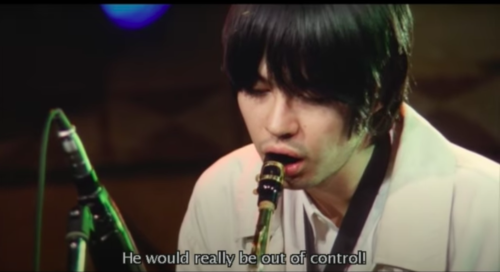
[44] Endless Waltz (1995, dir. Koji Wakamatsu)
In this film, essentially a double biopic of writer Izumi Suzuki and free jazz saxophonist/multi-instrumentalist Kaoru Abe, Wakamatsu turns from the black-and-white micro-budget experimentation of the pinku era and towards what is, to all intents and purposes, a fairly conventional biographical film. Wakamatsu has to wrestle here with the pitfalls of the jazz biopic—reverence, romanticisation or normative condemnation—any of which would be easy to fall into given Abe’s life of addiction, abusive behaviour and early death, or the extremity of his music. But, if anything, Abe’s drug and alcohol ab/use is presented as incidental, and the film maintains a kind of critical distance, presenting without comment Abe’s self-destruction and abuse of others around him, most particularly Izumi. Through the film, we see Abe approached through layers of framing: the intellectuals who make up the core of Abe’s audience but who also seem to maintain a kind of intellectuals’ contempt for the ‘idiots’ they see perform; the judgments of neighbors, cops or doctors; the journalists eager to mythologise a ‘martyr’ to sell copies. Such often problematic framing acts might obviously extend to Wakamatsu himself, and the film is self-consciously set up to undercut the voyeurism of the biopic. Certain unexpected sentimental touches (accompanied by ‘Amazing Grace’ on a harmonica) at once challenge and reinforce the sensational recollections of Abe’s life Izumi is asked to provide. The film suggests that–at least in Izumi’s case–the art produced from this era—expressive of, parallel to, or even a contradiction of—its radical politics, is neither a political tool in itself, nor simply nihilism, nor something to romanticise, and is often about craft and work, against the vitalist myths often built up around it (and into which Abe seemed to buy wholeheartedly). Ultimately, without trying to justify or explain (away) either the art or the life, the film shows Abe as *both* self-mythologising / obnoxious *and* someone who produced work of grave and terrifying beauty. By not trying to psychologise or justify Abe’s strange and difficult music, the film does more justice to it than a more sensational or romantic approach might; at the same time, it centres Izumi and suggests the ways in which artistic transgression too often serves as cover for the same patterns of masculine violence, selfishness, abuse and control. Abe’s music remains devastatingly open, raw and unnerving; these very recordings would be made after he’d just beaten up his wife; Izumi was an independent artist and not simply a victim or a side-note in Abe’s story. These elements of two painful and entwined lives can’t be easily foreclosed or resolved, and ‘Endless Waltz’ doesn’t try. As such, it’s a powerful and troubling film.

[43] Heroic Purgatory (1970, dir. Yoshishige Yoshida)
In ‘Eros Plus Massacre’, Yoshida adopted the framework of the ‘historical film’ in order to cast doubt on that very form: to question the use of the past as fixed in aspic, the contingent nature of reconstruction and the multi-perspectival nature of narration, and the use of a radical past, both as inspiration for, and as something not fully understood by, a present day generation of radicals. ‘Heroic Purgatory’ offers a more in-depth exploration of contemporaneous political movements, with a greater emphasis on performance, fantasy and the closed dynamics of small, radical groups: the paradox by which those most minded towards the radical transformation of an entire society become inward-turning cells losing contact with the broader climate of that society. During the time of the 1952 San Francisco treaty–a de facto ceding of colonial power to the occupying American forces, beyond the period of ostensible occupation–a planned attempt to either kidnap or assassinate an ambassador by a far left group collapses due to the possible intervention of a spy within the group. This moment is played out again and again, shifting in time and location from 1952 to 1960 (the signing of another treaty of compromise), 1970 (when the film was made) and 1980, ten years in the future: actors play multiple roles, as the original members of the 1952 cell appear to take up roles in ‘official society’ and their successors among the new waves of radical movements turn against them. Social roles repeat themselves, over and above the arc of individual motivation, desire or intention, not only within the broader society which, as in ‘Eros’, is encountered more through the discourse of those who resist it than through the appearance of crowds, public places, or the state apparatus, but through the smaller units that try to oppose the Engelsian trinity of the family, private property and the State. Paranoia, suspicion, and the ritual-casting out of outsiders, or spies, are both responses to real conditions, real infiltration, and real defeat, and manifestations of the failure to fully conceive of alternative social arrangements free of hierarchy, cruelty, sexual exploitation and violence. The oblique and compressed mise-en-scene in virtually every frame of the film stresses the limited, partial nature of any one perspective, the slicing up of reality into segments that never tell more than part of the truth, and the inability to break a cycle of various kinds of repetition, even in the most radical, vanguard, progressive or advanced of movements–whether official technocracies or revolutionary organisations–is the film’s purgatorial territory. Yet, if struggles for power may repeat themselves, first as tragedy, then as farce, this also means that resistance never ends. Viewed half a century on, Yoshida’s projections of the present into both past and future suggest that, for all the moments of suppression, the defeat of a particular movement or moment, whether in 1952, 1960, 1970, 1980, 2020, resistance has been and will be unceasing.
(More here: http://streamsofexpression.blogspot.com/2020/08/heroic-purgatory-1970-dir-yoshishige.html)

[42] Eros Plus Massacre (1969, dir. Yoshihige Yoshida)
In contrast to the pared-down narrative and cast of Yoshida’s immediately preceding film, ‘Farewell to the Summer Light’, the three-and-a-half hours of unrelenting experimentation found in Yoshida’s next film preclude any attempt at summative analysis. Ostensibly, Eros Plus Massacre is a historical epic depicting early twentieth century anarchists Itō Noe (Mariko Okada) and Sakae Ōsugi (Toshiyuki Hosokawa), concentrating on the triangulation between Noe and between Ōsugi’s other lovers—his wife, Hori Yasuko (renamed Akiko Hiraga, and played by Kazuko Inenon), and his mistress, journalist Kamichika Ichiko (renamed Masaoka Itsuko afer the real-life Ichiko threatened to sue, and played by Yuko Kusunoki) —and culminating in Ichiko/Itsuko’s attempted murder of Ōsugi, ten years before he and Noe were murdered by the police. This timeline is intercut with scenes of the aimless present-day students/actors/dropouts Eiko (Toshiki Ii) and Wada (Dajiro Harada), reading about the earlier events which they half-recreate, half imitate, half-dismiss. Signalled by the constant psychedelic rock soundtrack, the contemporary segments seems to signal their own contemporaneity, but the slower, more patient historical segments are also characterised by stringent formal experimentation which provides both an equivalent to and critique of the passions that unfold within them, as well as the lens of the historical film itself. As the two timelines begin to blur in the more surreal focus of the film’s second half, such experimentation becomes an increasing part of the film’s method. The point, as Yoshida noted in interviews, is to view the past for the way it views the future, not to reduplicate it in the present. Yoshida opens the film with a startling scene in which Eiko interviews Noe’s daughter, framed as a spotlit interrogation with uncomfortable echoes of State torture. As such, the refusal to divulge, to narrate, to present a coherent chronicle of the past comes to seem an act of resistance in itself: the subject refuses to answer questions, insisting on the exploitation of mothers as such, rather than a focus on the spectacular life of her own mother as either revolutionary exemplar or cautionary tale. The present, Yoshida suggests, treats historical figures like the urn containing Ōsugi’s ashes which opposing rugby teams kick about a field in one of the film’s most startling sequences. This section culminates in the multiple re-tellings of the attempted murder of Ōsugi which serve as the film’s climax, and which the modern-day students take to attest, not to the breakdown of sexual experimentation—the return of the repressed in the guise of murderous jealousy—but as the point to which it led all along, embraced as the height of ecstasy. Significantly, their attempts to combine eros and thanatos, eros plus massacre, are seen to be conducted through the modality of film itself. Scenes of the pyromaniac Wada setting fire to rolls film or wielding a cine-camera with shades of Powell’s ‘Peeping Tom’, and of film rolls turned into a noose as the director first encountered having sex with Eiko—kicks away canisters of celluloid in a final, suicidal act—problematise the act of representation at every stage, as does the extreme, light-bleached low contrast black and white, the anti-symmetrical framing (honing in one detail rather than attempting an overall picture). Would a revolutionary cinema be destructive—a thanatopic self-immolation akin to the anarchist philosophy espoused by Ōsugi, at once egoist and self-destructive—or constructive, of alternative visions of social life represented by the dreams of free love and revolution?
(More here: http://streamsofexpression.blogspot.com/2020/08/eros-plus-massacre-1969-dir-yoshishige.html)
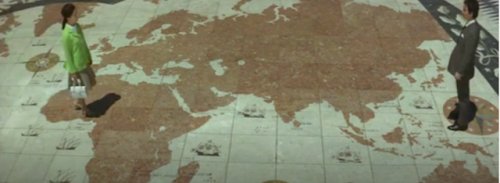
[41] Farewell to the Summer Light (1968, dir. Yoshishige Yoshida)
“No! Until death, I will walk throughout Europe. No. At the time of the tide, this abandoned church at sea, it’s me.” ‘Hiroshima Mon Amor’ in reverse: Japan’s critical eye on Europe, via the New Wave (Resnais in particular), a beautifully-shot tourist travelogue with things to say about history, memory and global impasse in the guise of a slow-burning drama of forbidden infatuation. ‘Summer 1968’ read the final intertitles, and while Yoshida would address political radicalism in far more depth in his following films, the dilemmas of moving from old to new, of moving out from the shadow of monuments to and of despotism and aesthetic utopianism (cathedrals, coliseums, chateaux) are evident in every frame of this film as well.
(More here: http://streamsofexpression.blogspot.com/2020/08/until-death-i-will-walk-throughout.html)
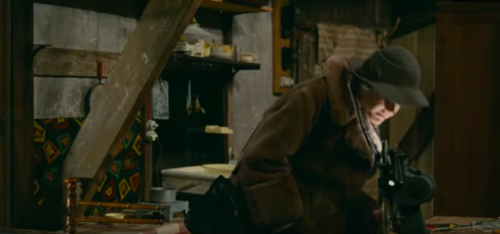

[40] Muriel, ou le temps d’un Retour / Muriel, or the time of a Return (1963, dir. Alain Resnais)
Some decades before Haneke’s ‘Cache’ once more centralised the trope of Algeria-guilt amongst the bourgeoisie, ‘Muriel’ is less a polemical allegory—and less marked by immigrant experience—and more a kind of spider’s web of implication, its critique of French conduct in Algeria constructed as a kind of puzzle which is only really a puzzle if we ignore those political truths hiding in plain sight—which is precisely the point. Haneke is concerned to reveal his cards half-way through the film—it’s important that one *get* and *absorb* a message. Likewise, in Muriel, the account of torture committed by the ex-soldier now returned to Boulogne-sur-Mer plays out at the half-way point. But for Resnais and scriptwriter Jean Cayrol, to whom the film equally owes its striking detail and shape, form and message are imbricated in closer ways. Likewise, compared to other experiments with narrative within avant-garde cinema of the period—including Resnais’ own—here, complexities of perception rendered through avant-garde technique may reflect existential questions of memory, desire and so on, but more precisely, they serve a political purpose. As in Demy’s ‘Parapluies de Cherbourg’ the following year, the film’s critique of French conduct in Algeria is presented as both motor to and peripheral figure / irritant within what is in some ways a love story. But there are no Michel Legrand songs here, no bright-burning neon glow, no dwelling in sentiment: the film is analytical, critical, clipped, dense. The constructs of desire, loss, the attempt to regain past intimacy, told in half-finished stories, never-received letters, interrupted monologues, the constant unspoken—the evasions and illusions of romantic love—are open secrets around which the lovers tip-toe, traipse and on which they trample, while the Algerian conflict is imbricated within the social fabric of a particular town, and, metonymically, the broader society in which it has its place. Of particular interest for the film is the way that the community of that town is constructed through a mixture of the repressed memory of trauma (the second world war and national service in Algeria—attack by or complicity with fascist occupation domestically and participation in colonial violence abroad), the militarist underlay of the business world, of Gaullism, of particular modes of masculine identity. The clipped precision of the film’s extreme fast-cutting turns editing at once almost hallucinatory in its flashes of distorted logic and extraordinarily precise in its planned juxtapositions: the trope of mystery—who is Muriel? What happened in Algeria? What happened to break apart the now elderly lovers reunited in a web of half-truths, half-desires, and deceit?—a diagnostic frame at once personal and social. Resnais may suggest that film itself—at least, as conceived of as a repository of direct truth, the authenticity of visual experience—is inadequate: as when the young ex-soldiers’ Algerian footage literally burns up in the projector when exposed to the light (pictured above). But film, understood differently—for its challenge to, its going against the grain of perception—provides the shock to the habituated dailiness of looking so that an antique table, the door to a café, a walk around town, the assassination of a far-right terrorist, flicker and bunch up together like a terrible revelation of what lies beneath.
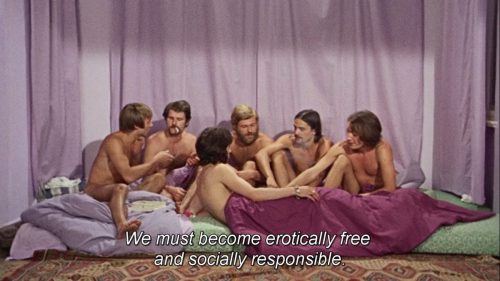
[39] Nicht der Homosexuelle ist pervers, sondern die Situation, in der er lebt/ It is not the homosexual who is perverse, but the society in which he lives (1971, dir. Rosa von Praunheim)
Controversial for its excoriating polemic of middle-class gay male life in virtually every aspect–from the bars to cruising, from the world of fashion to that of the bourgeoise art lover (the latter episode surely an influence on Fassbinder’s Fox and his Friends a few years later)–von Praunheim’s film was undoubtedly polemically effective in the context into which it spoke, a force it still retains: the arguments hardly feel ‘historical’. First sustained and then trapped by a sentimental attachment to recreating the nuclear couple-form as a stultifying world of impossible pressure seeking to compensating for discrimination outside its four walls, our initially naive hero moves through the increasingly love-free interactions of a queer world in which—according to the account the film gives–desire is at once perpetually displayed and perpetually stymied through commodification, ghettoised and set aside from society as a whole: apolitical, superficial, and cruel in its survival-of-the-fittest ageism, sexual competition, and lack of depth. Not a documentary, the film’s recreations too often loaded with a kind of symbolic-allegorical weight–glances, balances of power, acts of petty cruelty–we end with the daring scene of a kind of orgy-cum-political meeting (pictured above), in which gay men (lesbians are absent here) are called to join with the Women’s Movement and racialised struggles in what seems a kind of united front; to link sexual identity to more than just sex, out of the bedrooms and into the streets. In the absence of diegetic speech, a perpetual non-diegetic voiceover, speaks for, to and against those it depicts in a near-constant monotone: the film works, not through identification or sympathy, but through its opposites, as a force of relentless criticism that’s–deliberately–exhausting and ruthlessly analytical.
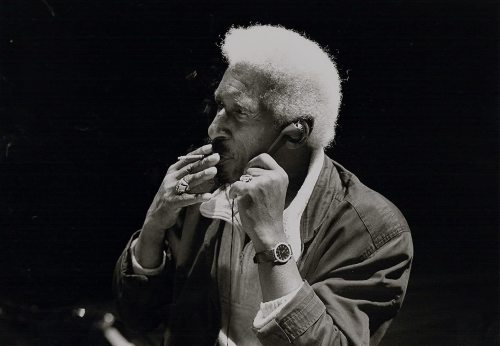
[38] Mal: A Portrait of Mal Waldron (1997, dir. Tom Van Overbeghe)
As its title indicates, this is not so much a biographical documentary as a portrait, shot at Waldron’s 70th birthday celebrations in Antwerp in 1995, and juxtaposing performance excerpts in duos with Max Roach and Jeanne Lee, and a quartet with Steve Lacy, Reggie Workman and Andrew Cyrille, along with brief interviews with the musicians. Brief comments reveal world of social injustice – Waldron recalls the enforced competition in which hundreds of Black musicians played for slots in ten clubs, turning against each other, being passed over for white musicians and harassed by cops whenever they stepped out of the club for air; believes that Billie Holiday would have survived in Europe, where her drug habit was treated as an addiction to be helped and cured, rather than America, where it was treated as a criminal problem. Jeanne Lee puts it more starkly: during the Cold War era and its afterlife, if you were or are an artist in America you have to make excuses for being alive. Those searching for new information about Waldron won’t learn all that much; this feels more like an official, warm-spirited tribute than an in-depth exploration. One gets the sense of a film made on or for a particular occasion, using the serendipity of the attending musicians to provide a snapshot rather than a full picture. But, in Waldron’s case, a snapshot is hardly to be sniffed at.
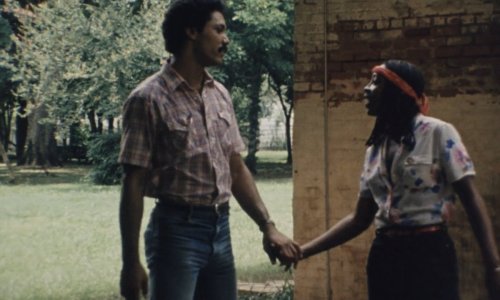
[37] Cane River (1982, dir. Horace B. Jenkins)
Filmed in the early 1980s, but receiving only a limited release following its director’s early death, ‘Cane River’ is a snapshot of careers that never blossomed, of a moment that never came to fruition; a tantalising snapshot into a largely non-existent alternative history of African-American cinema. The film has few parallels; at once modest and ambitious, it’s a love story about a relationship’s development over divides of class and colorism that reckons with the historical origins and personal dramas of such divides in a way that’s neither didactic nor sentimentalised, that treats its audience as seriously as it treats its subjects, that knows that history is not simply a series of grand events but part of the texture of everyday life. Heavy on the songs, the film at times feels like a musical—or perhaps a music video. Understandably, the film has the production values and technical variability of an independently produced, first time effort: shots tend to be held longer than they might, and it’s clear that judicious editing here and there would have tightened the film’s structure without sacrificing its deliberately meandering pace. But the film also accomplishes something very rare, rendering it impossible to understand the gentle love story without the politics—debates surrounding colorism, land ownership and African roots amongst Cane River communities, centred around Gary B.Mills’ then recent ‘The Forgotten People: Cane River’s Creoles of Color’—or the politics without the love story. And the film’s rejection of narrative drama—the lurch from ‘crisis to crisis’—suggests a gentle subversion of narrative norms with few parallels in either mainstream or ‘art’ cinema.
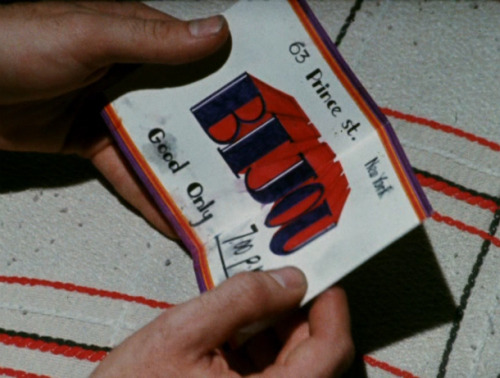
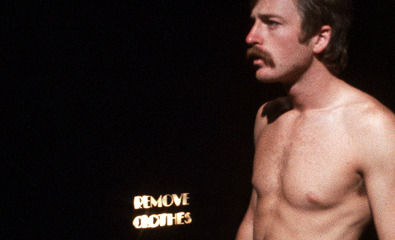
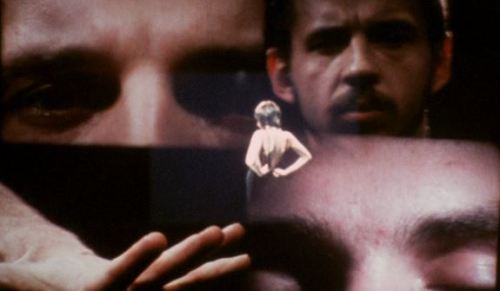

[36] Bijou (1972, dir. Wakefield Poole)
Wakefield Poole’s breakthrough gay porn masterpiece no doubt made it into the mainstream (and across lines of sexuality) because its ‘high art’ ring made it amenable to straight sexual tourists seeking out the other side, while wishing the work to be clothed in a veil of 'legitimacy’. To call the film an 'erotic art film’ instead of 'gay porn’ is to draw a distinction between the commercial, vulgar and exploitative and the transmutatory erotic incantation that Poole refuses; at the same time, the film has a kind of educative function, in the way that its protagonist moves from solitary heterosexual fantasy to the mutual communion of queer fluidity, learning to give as well as take, to experience pleasure as a kind of ecstatic, plateaud network rather than a surge of possession and release. And its wall-to-wall classical music and its self-consciously 'artiness’ are its strength. Who’d have thought a Hovhaness symphony would form such a deliriously appropriate soundtrack for a gay orgy? Ecstatically rising each time, stopping, starting again, as if the record were being flipped over, to the orangey-yellow glow of skin against a bare backdrop, bodies reclining, fondling, inclining, as if floating in space, the occasional Dan Flavin sculpture or lens-flare light-show the film’s bijouterie along with bodies unadorned in unselfconscious communion and display. The film is in essence a lengthy orgy, 'presided over’ by a centurion-type who stalks around with a whip (though the S&M factor is more an allusion than an actual presence). Poole’s lack of interest in the money shot, in a kind of sex-as-labour performance, gives the sequence a peculiar and endless rhythm, amplified by his decision to remove diegetic sound and instead overlay things with the non-diegetic, harking back to the days of silent film and the peculiar visual rhythms and intensities thus implied. Performing as much for themselves as for each other, voyeurism becomes part of erotic exchange rather than a logic of extraction: a space of fluid fantasy, bijouterie, un-self-conscious, with nothing to justify or explain away–the other side of the magic mirror, the rabbit-hole, the door to all wonders.
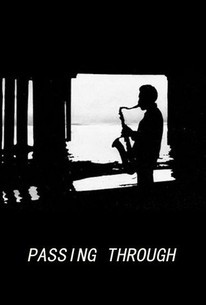
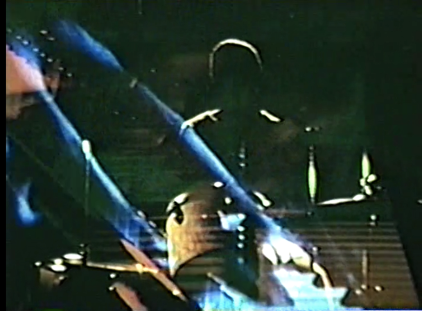
[35] Passing Through (1977, dir. Larry Clark)
A film about jazz that is also utterly saturated with jazz–barely a second goes by without the foregrounded or backgrounded sounds of Dolphy, Tapscott, the Art Ensemble of Chicago: sound on records, sounds in clubs, sounds in protagonist Warmack’s solitary saxophone practice in isolated spaces under piers, next to the sea, that calls to mind and ear other spaces in a trans-temporal, trans-historical communion at once deeply personal, private, and a collective source (think Sonny Rollins practicing on the bridge)–a crossing that (as in the image above) occurs through the figure of echo, of temporal lag, not as mirror of individualist musician’s narcissism, but as a spur to the collective work of building an ensemble, a record label, another society, another world, a future. With Gerima’s films, Clark shares an interest in flashback structure–or a structure for which the conventional term ‘flashback’ seems barely to apply, a temporal saturation to accompany the aural saturation, that threatens to unmoor the film from its sometimes convincing, sometimes awkwardly imposed narrative structures as free jazz itself departs from the knowns of chord changes, steady rhythm or melodic guide. At times mystical, at times political, materialist, the film asks: In what frames–economic, artistic–can the music survive: as important a question, and inextricable from, the question of what the music itself can be? Perhaps all the questions in the film are subsidiary to this, but it also asks: can an ‘African horn’ really bring a junkie to life? What does it mean for music to evoke at once the Attica uprising, African liberation struggles, urban riots and police violence? How might film find an analogy to the simultaneity, the emotional extremes, the ecstatic precision of free jazz? And answers them in its own ongoing questioning song.

[34] As Above, So Below (1973, dir. Larry Clark)
Clark’s UCLA thesis film: the tool of violence as solution to political, aesthetic or narrative problems has, as some commentators have noted, parallels with blaxploitation, but whereas that frame seems imported and problematic in the more famous (though extremely hard to source) ‘Passing Through’, here, it’s a question of revolutionary strategy–the film as a meditation on the possibilities of guerrilla warfare–rather than a get-out clause. Like ‘Passing Through’, ‘As Above’ is saturated with the music of Horace Tapscott–an over-burdening or over-abundance of music that will reach its delirious climax in the latter film; here, non-musical sound is equally key, sometimes indexing a space of possibility or trauma, as in the lengthy shot, early in the film, of a blank grey sky accompanied by the sounds of machine gun fire and police sirens–at once anti-black police violence and the imperialist wars in which the protagonist has had to fight, and which have radicalised him, a knowledge at once specific and abstract, collective and personal–or the ubiquitous radio transmissions that relay something of the political stakes buried in plain sight–the protagonist as a child hearing of the release of Japanese Americans from internment camps at the end of the war; texts drawn from HUAC reports; imagined reports of imprisonment, medicalised torture, curfews, and the like, only a hair’s breadth from the carceral system as it is still constituted. Yet, as the film’s title suggests, if the trappings of liberal democracy are just the other side of white supremacist totalitarianism, so too the postures of defeat, compliance and complicity fostered under such a system can be reversed: the junkie who turns out to be a revolutionary, the soldier who turns into a guerrilla fighters, even the ecstatic church service which free-floats in the film as a slab of ambiguous power.
(More here: http://streamsofexpression.blogspot.com/2020/07/urban-guerrilla-planning-in-united.html)
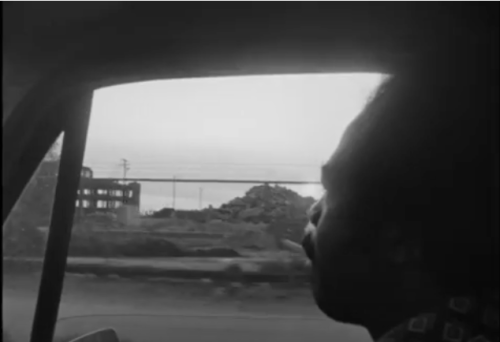
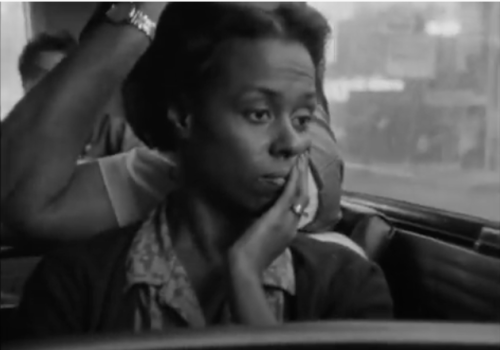
[33] Bless their Little Hearts (1983, dir. Billy Woodberry)
One of the truly great films to emerge from the L.A. Rebellion, the similarities to ‘Killer of Sheep’ are clear: Burnett’s presence as scriptwriter and cameraman, Kaycee Moore’s lead role; the use of music as both expression of, escape from and transformation of social condition. But Woodberry’s film is sparser, its ways out fewer, as characters wake up, give up, walk out, perpetually leaving or entering but never going anywhere. This world of perpetual labour or its perpetual absence, of routines of care and despair, is evoked with a minute precision that also leaves space for broader analysis, without ever preaching or framing in terms of allegory, ideology and the rest; as such, its political valence is far greater than lesser imitators: neo-realism, if neo-realism it be, without a hint of exploitation or uneasy allegorising. The use of Archie Shepp’s spirituals and blues recordings with Horace Parlan is as exact and moving a pairing of image and sound as you’ll find in all of cinema.

[32] The Horse (1973, dir. Charles Burnett)
Made in California on a break from shooting ‘Killer of Sheep’, this short sees a group of white men waiting outside a derelict shack amidst vast farmland. An African American pre-teen stands apart from the group in the field, gently attending to a horse; his father turns up at the end of the film, hired, it turns out, to shoot the horse, the film ending on the boy’s anguished covering of his ears. Sparse in terms of dialogue, narrative and sound, with the audible traces of the natural environment constructing a kind of found symphony akin to the opening of Leones 'Once upon a Time in the West’, the film is a kind of western, with none of the genre’s tropes of heroism or nation-building, but much of the genre’s dynamics of masculine violence and the racialised invasion or defense of land. Weighted with the force of allegory, of violence, labour and racial projection, its 'pastoral’ setting–as in the day-trip of 'Killer of Sheep’–finds no escape from the claustrophobic urban settings which are Burnett’s more familiar terrain. In this context, the closing strains of Samuel Barber’s 'Knoxville, Summer of 1915’ are repurposed from simply being nostalgic elegy, to an expression–at once denial and melancholic hint– of the violence its idealised image of community invokes.
(More here: http://streamsofexpression.blogspot.com/2020/06/the-horse-1973-dir-charles-burnett.html)
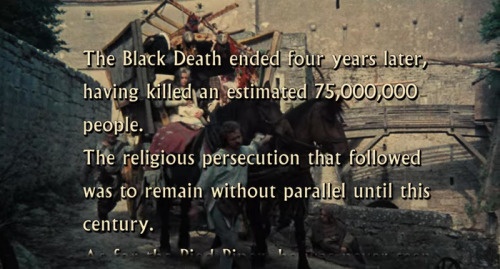
[31] The Pied Piper (1972, dir. Jacques Demy)
Forgot this in the Demy-monde a few posts back. An odd film indeed, retelling the Pied Piper story with a gormless Donovan lacking the malevolence (or at least ambivalence) that lurks behind the piper as figure of destruction. Donovan’s Piper is a kind of hippie fighting a venal bureaucracy of allied and competing burghers, soldiers and priests, the cynical and hypocritical use of religious institution and ritual (cathedral construction and marriage) as tool of power leading to a disastrous refusal to reckon with an encroaching pandemic (contemporary relevance hardly needs to be mentioned). Hardly the usual Demy musical, Donovan’s songs feels like commercial interludes/intrusions on what is otherwise a kind of grim medieval history film—more ‘Marketa Lazarová’ than either the Michel Legrand symphony of songs Demy fans might have expected or the countercultural tie-in the producers might have expected.

[30] Several Friends (1969, dir. Charles Burnett)
Like ‘Killer of Sheep’, 'Several Friends’ focuses on Black sociality, with white people a minimal presence. And the soundtrack to this film is alive with the sounds of that sociality—the overlapping, sometimes raucous dialogue, as its characters kill time and shoot the breeze. Simply letting that run–seemingly improvised conversations and interactions, gently steered by the bare-bones of plot–is in itself a huge contribution to cinematic representation of what otherwise gets framed as excess, lack, stereotype, or absence. But there’s also a key moment where a horse suddenly appears at the edge of the frame as its characters watch a fight in a parking lot. The shot is never repeated and never explained: blink and you’d miss it. The incongruity of that shot—as in the now-iconic scenes of masked children playing in Killer of Sheep—serves to emphasize a surrealism that bites back at a patronising realism which would trade in pity or abjection, fresh instead with all the possibilities of the marvellous.
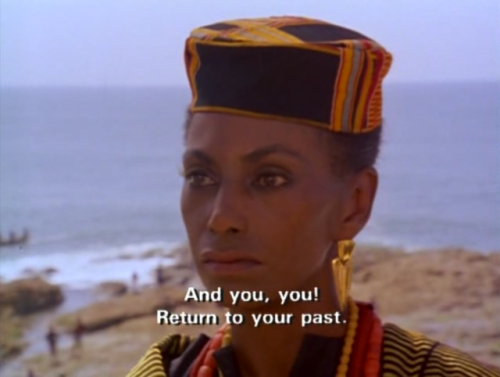
[29] Sankofa (1993, dir. Haile Gerima)
While the gendered framing is again problematic—the flashback structure implying feminised suffering as educative reconnection to blackness/history—Sankofa is again an ambitious piece of filmmaking taking on nothing less than the slave trade, from the coasts of Ghana to the plantation set in a kind of Caribbean/American indeterminate zone which aims for a generalised experience—a politically-motivated pitch which risks blurring and didactically simplifying the neglected details of historical specificity yet gains immensely in visual/aural power, Gerima’s true strength. Return, recurrence and reckoning are at the core of Gerima’s flashback, cross/fade, dissolving structure: when history is the nightmare in which racial representation / cinematic representation / representation as such is caught, how else could one view time? Yet return is also renewal—despite the tourist framing of the sites of maafa—accessed through Guy Warren’s chants and (once again) through a kind of internal transformation that is the precondition for working toward material change.
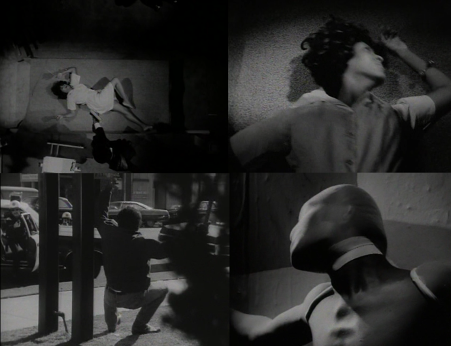
[28] Bush Mama (1976, dir. Haile Gerima)
One of the most distinctive thing about Gerima’s films is their use of voices, often overlapping, crossing over, in monologue, dialogue–voiceover that blurs the lines between inner and outer voice, temporality, synchronicity, the motion of thought not as description but as enactment. From the opening scene, the soundtrack is a barrage of voices—welfare officers, despairing friends, revolutionary meetings, sermons—both internal and external, that swirl through Barbarao’s head, again in a combination of the grimly (neo)realistic and surreal transformation (notably in the scenes of church ritual, of writhing on a crucifix). In some sense, voice and music take on the roll that image did in Eisensteinian dialectical montage, but the principal is more cross-fade/overlap/multiplicity than juxtaposition and transformation. Babarao, herself the incarcerated revolutionary in ‘Child of Resistance’, is here the partner on the outside of her incarcerated partner, their dialogue in letters overlapping, cutting across, denying, silencing, communicating; this gendered divide and the double-binds faced by the ‘Bush Mama’ as mother-on-welfare, victim of violence, and, eventually, armed revolutionary, at once evince a certain kind of feminism and risk—as bell hooks has suggested—gender stereotyping. For all this occasional nearness to stereotype, Gerima’s films put the lie to the idea that propaganda can’t be complex. ‘Bush Mama’ is still an incredibly rich film.
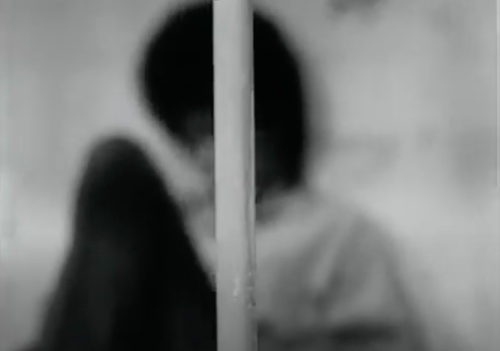
[27] Child of Resistance (1973, dir. Haile Gerima)
Gerima continues the juxtaposition, established in ‘Hour Glass’, of all-too-real spaces, rendered in black and white (here, the jail cell) and the surreal transformation of other space (the bar) in colour–surrealism not so much as index of liberation as of the distorted/caricatured performance of stereotype and the revelation of mental shackles in physical form (blackness as safari, as performance of unfreedom both in the presence and the absence of mediating and framing whiteness–the jailer/tour guide). The protagonist of ‘Hour Glass’ escapes such performative binds by checking into Watts; Barbaro’s Angela Davis figure, already incarcerated–the society-as-prison/prison-as-society frame so central to Gerima’s ‘Bush Mama’ and, to an extent, Larry Clark’s ‘Passing through’–must search for a more interior mode of liberation that then manifests in the joyous destruction of property. This may take place within the cell–both the literal prison and the broader carceral entrapments of black life as enclosure–but the smashing (as, again, in ‘Bush Mama’s closing act of domestic retribution) begins from within.
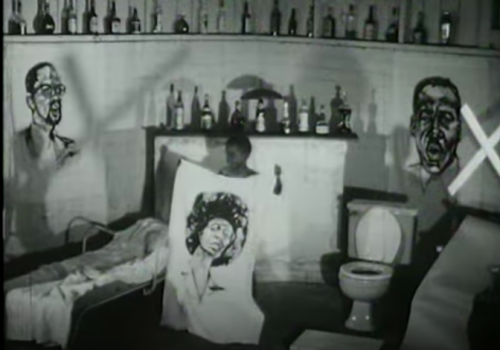
[26] Hour Glass (1971, dir. Haile Gerima)
Gerima’s UCLA Project One film sets out in the more starkly/simply symbolic register the more dizzyingly polyphonic variants he spins on those frames in his feature-length films–the terms suggested by the image above, a surreal/ritual space at once bedroom, prison, Black Power shrine and mendacious lab ruled over by an elderly white woman. This is a location apart from the more identifiable scenes in which the majority of the film takes place, intercut with scenes of the film’s protagonist–a student on a basketball scholarship, the game presented as a modern-day gladitorial contest to laughing whites–conducting Black study with piles of books in his cramped college room; and passing a seemingly endless red-white-and-blue painted wall adorned with icons of the revolution, trailing a noose round his neck and a suitcase. The film’s resolution sees him leave the academy and move into a rented room in Watts; Gerima’s, and the L.A. Rebellion’s symbolic return home. While sound will come to be one of the main sources of his later films’ multi-layered play with time, narrative and history, here, the absence of dialogue renders the film’s aural weight on music: The Last Poets, Elaine Braine’s ‘Seize the Time’, flute-and-percussion soundtracks: sound and image interact in ways more similar, perhaps, to silent cinema, with a renewed emphasis on visual rhythm that would again be taken up in more depth in the work to come.

[25] Finally Got the News (1970, Black Star Film Productions and League of Revolutionary Black Workers/ Jim Morrison, Peter Gessner, Rene Lichtman, Stewart Bird, John Louis Jr.)
While Uptight presented a cul-de-sac of de-industrialisation and racial violence, Finally Got the News, made well outside any kind of Hollywood studio structure, turns to the interior of the factory and presents Detroit’s League of Revolutionary Black Workers/DRUM finding new ways to circumvent the corrupt union bureaucracy and to organise within the workplace. Far from a nostalgic or ‘local’ document, the film’s structure veers between ideological lecture, practical summary, functional illustration, and ‘news’ of a different kind, a treatise conveyed through affective means. The film opens with a montage of racial capitalism in America unfolds in a succession of stills which give the impression of a kind of spasmodic movement, underscored by dramatic tympani (the opposite of the reverential aura the archive would attain in the Ken Burns-trademarked style of succeeding decades). A brief shift into colour for electric guitar and footage of the auto-factory and the racial violence of the long hot summers brings things up to date; for the credits, we shift to the sounds of the factory itself, to be followed by a lecture on surplus value by a member of the League. As the film cuts from the scene of the lecture (an apartment filled with revolutionary posters, for Che, for Mao, for Angola, for Malcolm X) to the factory itself, these spaces–the space of ideological debate, of theory, of Third World Marxism–and of the factory itself, with the more mundane, grinding, or specific struggles of how to organise within it–form the film’s too axes, often united as impromptu lectures unfold over footage of the various negotiations within the factory spaces, reaching a kind of furious peak during another speech around 15 minutes into the film. Here we see the cars themselves, the product of centuries of dead and living labour congealed into an object whose gleaming surface is dismantled by the coruscating, incandescent lyricism of that speech. The film’s acutely attentive to such intersections of sound and image, of the thorny demands of activism and the affective register which gives the truth of the emotional life without which they wither and die: a moment channeling hurt, rage, fury and steely determination whose chord still strikes.
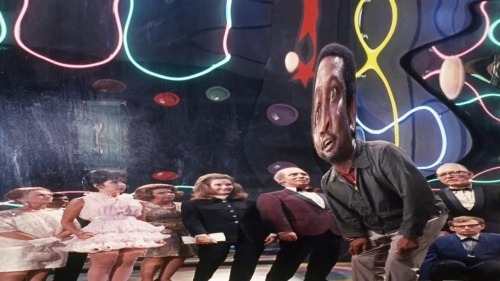
[24] Uptight (1968, dir. Jules Dassin)
Ford’s ‘The Informer’ adapted to the racial ferment of the late-1960s United States, with footage of Martin Luther King’s funeral, taken just as shooting was wrapping up and incorporated into the film, adding a sense of ‘documentary’ actuality soon belied by the film’s frequently surreal framing–oblique camera angles, garish and glaring colours, a perpetual nightscape with no way out. This was Dassin’s first U.S. production since ‘Night and the City’, and in some senses it’s like a film-like extension of that film’s nocturnal climax, but in a very different context; and shaped to a significant extent by the collaborative scriptwork of Julian Mayfield (who plays the informer, Tank, who rats out on the underground Black Power guerrilla cell, setting the film’s events in motion) and Ruby Dee (who plays his beleaguered partner and whose role is in some ways central through precisely through its marginality). It’s not a ‘great film’, but it’s precisely for its failures, and the questions it raises that it’s still important: questions about what ‘Black Cinema’ might be, and what its role might be in Hollywood; about race, class and political organisation in an era of deindustrialisation; about the possibilities for collective action in a pervasive atmosphere of anti-blackness. Watch alongside James Boggs’ 1963 book ‘The American Revolution’.
(Longer piece on the film here: https://brightlightsfilm.com/dont-talk-to-us-about-being-killed-uptight-and-the-problem-of-black-cinema-in-hollywood/#.X05-TNNKjUo)

[23] Todo Modo (1976, dir. Elio Petri)
Petri’s film is one of the stranger political films of this period–a satire on political corruption and compromise, as mediated by the thinly-veiled, pre-assassination Aldo Moro (memorably incarnated in a meekly transformed, placatory yet scheming turn by Gian Maria Volonte) and a powerful Catholic church (with Marcello Mastroianni as the thundering head of a Jesuit retreat to which the politicians repair to broker deals). Set almost entirely in a modernist complex lacking natural light, this is a world of surveillance cameras, exculpatory rituals, and bitterly satirical portrayals of venal double-dealing which turns into a kind of murder mystery, performed by a virtually all-male cast (with the exception of Mariangela Melato as Modo/Moro’s wife, who’s sneaked into the complex, or is possibly a hallucination)–all soundtracked to an eerie Morricone score. (None other than Charles Mingus originally wrote and recorded the music, only to have the score rejected by the producer who’d commissioned it–the recordings were ultimately released on ‘Cumbia and Jazz Fusion’).
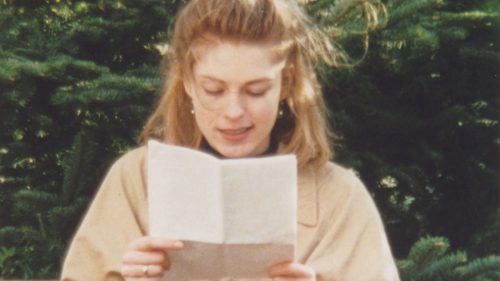
[22] The World of Jacques Demy (1995, dir. Agnes Varda)
Varda’s second film on her late husband sticks closer to documentary than the fascinating Jacquot de Nantes, and is perhaps closer to a kind of (Demy-esque!) affirmative bittersweetness than the desperate sadness of the footage of Demy dying (though this was never spelt out till years later) of AIDS-related complications. Varda is unsurpassed at the apparently free-wheeling, but in fact beautifully and painstakingly crafted, ‘documentary’ style she increasingly made her own: the film thus not only captures a good part of what makes Demy’s work so compelling, but also tells us much about Varda’s own approach to film. The title should be taken as a key–as much as Demy’s biographical world, Varda means the world that his films create, and the worlds of his audience that they in turn enable and participate in. This is her main, gently unfolding thesis: Demy’s films, which, for Varda, appeal in particular to women and children, are uniquely open in their approach. Demy (and Varda) make generous offerings that offers viewers space for fantasy, illusion, and the play-making that, for Varda, is so central to filmic creation. Yet they both know–Varda perhaps more so than Demy (who could never have made a film like Vagabond)–that this play-making arises from, and as a way to make certain kinds of sense out of, a world marked by inequalities fostered by war, by gender and by class relations. And Varda, of course, expresses this with far greater subtlety, delicacy and telling detail than can be mustered in a few hundred words here.
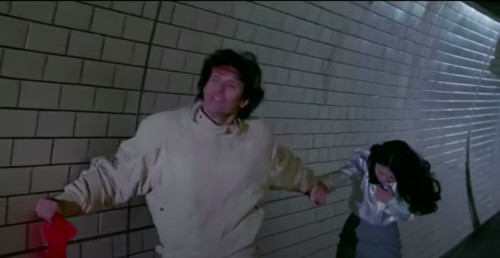
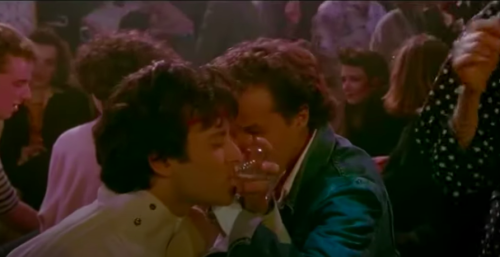
[21] Parking (1985, dir. Jacques Demy)
Famed for his presentation of heterosexual love, the open secret of Demy’s bisexuality has been hard to address, given the biographical silence surrounding his legacy. Shot as AIDS became unavoidably present, this is Demy’s most obviously queer film, and is said to have its roots in a film about a cruising spot in a carpark (hence the title). In the film as shot, that car park is instead a portal to the underworld, via a kind of James Dean automative suicide leap in which a car is driven into a wall: as with public or serial sex in a time of AIDS, death haunts everything. As ever with Demy, things are as much on the surface as they are hidden, sung in Legrandian audio colour and buried away in blink-and-you’ll-miss-it narrative aside. Essentially, Demy turns Cocteau’s Orphee into a drama about a bisexual love triangle, complete with drug overdoses, cheesily-rendered rock stars, and assassination by a jilted fan club. While the film begins with Orpheus serenading Eurydice in front of a fireplace to the gentle strains of Legrand’s ‘Simplement’, nothing is ever simple here: later, their love takes the form of a blindfolded tryst in a motel literally located in the underworld, and Eurydice’s famous glance back occurs through a distinctly un-mythic, desperate fumble in a crowded underpass. The film’s two worlds–earth, with its idyllic chateau retreats, rock concerts, and parties, and the underworld, with its bleached-out bureaucracy–don’t easily divide into symbolic splitting, but the film itself is (appropriately) enough, split, between the worlds of slick fantasy and something queerer, darker and more imaginative: arguably the fate of Demy’s late work in general.
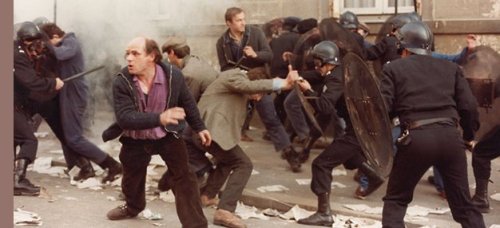

[20] Une Chambre En Ville (1982, dir. Jacques Demy)
A (sentimental, romantic) politics undergirds much of Demy’s work, principally through its impact on romantic relationships: the class conflict and military service that cuts across romance rather than the explicit terrain of strikes, revolutionary situations, street fighting. ‘Une Chambre’, long in the making, differs in that its narrative is explicitly set up around a strike, making this the only Demy film to receive critical attention from Alain Badiou (Badiou thought it a naive romanticisation of the past of the worker’s movement, constructed round a simplistic idea of the heroic working class, and an evasion of the compromises and complexities of the Mitterand years). Yet the film is principally a dark melodrama, far grungier, more bitter and less sweet than ‘Parapluies’–too dark, in fact, for Legrand to score, and hard to imagine Deneuve, even with the transformation of her image wrought in ‘Belle du Jour’ in the role played here by Dominique Sanda. Jealousy, betrayal, misogyny, bitterness and police violence win out over the thrills of forbidden, once-in-a-lifetime romance or noble ranks of strikers: they may sing non-stop, but the music’s more like recitative than show- or heart-stopping song, the violence and blood more present than the rumour of some distant war. As such, it’s unclear where the film stands–a confusion that’s a source of fascination and frustration in equal measure.
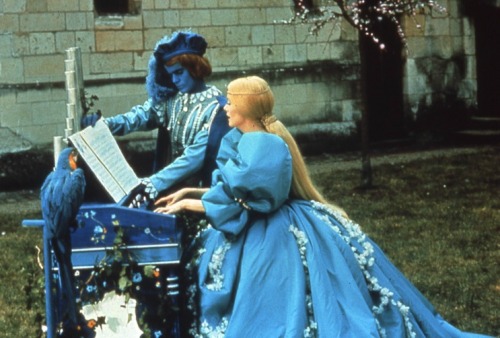

[19] Peau D’Ane/ Donkey Skin (1970, dir. Jacques Demy)
Demy’s most familiar film to Francophone audiences is also perhaps one of his strangest to those from Anglophone viewing contexts: the perversity, exploitation and cruelty of power structures–those of the family, of masculinity, of feudalism–that lie at the heart of fairy tales are presented on the surface, rather than as suppressed or submerged undercurrents, as Deneuve disguises herself in the skin of a donkey that shits gold(!) to escape her father’s proposal of marriage, exchanging one form of patriarchal subservience for another in the eventual marriage to a somewhat clueless Prince Charming. It’s Legrand’s beautiful yet oddly bit ode, ‘L’Amour, L’Amour’–first heard as sung on a suitably blue organ, pictured above–that provides the film’s leitmotif. While there’s plenty of fairydust, the droll irony of Delphine Seyrig’s fairy aunt already suggests what we come to know–that magic is more a flight from the inevitable than its defeat. Ultimately spells, flights, the magical transformation of the mundane–a cloak made of the sky, singing flowers, supernatural cakes–have as their narrative resolution the unions of heterosexual romance, which the film suggests as a mere surface transformation of the tabooed violence regulated by kinship and marriage structures rather than a genuine liberation from them. All this in the most beautiful of colours and the suitably strangest of sets, taking more than a leaf from the Cocteau playbook and adding a dose of dark Demy whimsy along the way.

[18] Model Shop (1969, dir. Jacques Demy)
This seems Demy’s most anomalous film: recruited in Hollywood in order to follow up on the big musical glamour of ‘Les Demoiselles’, instead we get a grim, low-budget film of endless driving, sex shops and frustrated masculinity, with ten-years-later Lola a marginal figure in her own ‘sequel’. Imagine ‘Zabriskie Point’ but with none of the libidinal satisfactions–yes, rock music, yes California sun, yes, generational disenchantment, but no couple on the run, no student movement, no campus radicalism, no Death Valley, no explosion of the bourgeois parental house. Instead, Gary Lockwood’s stalkerish behaviour, a climactic yet clearly hollow stab at romance, and the motivating factor of ‘Les Parpluies’–generational sacrifice in imperialist wars–echoed in the impending weight of the Vietnam draft only as a disconsolate drift, a refusal to believe either in patriotic myths, the compensatory weight of romance, or the political radicalism barely hinted at in the anti-hero’s visit to a radical magazine. The car shots in ‘Lola’ (or the opening of ‘Baie des Anges’)–definite journeys to and from particular places–are now replaced by endless, and aimless, ‘driving scenes’, memorably replayed in Thom Anderson’s ‘Los Angeles Plays Itself’, where they sit far outstrip the more sensationalist entertainments of the cop film car chase. In this films bitter world, they’re overshadowed by the narrative irony that Lockwood’s car is under the imminent threat of repossession, and he hardly bats an eyelid when the car is eventually taken away.


[17] La Baie des Anges / Bay of Angels (1967, dir. Jacques Demy)
The black and white here may share the sun-drenched lighting of Lola, of Demy’s favoured seaside towns, but its harder edges reflect the narrative of obsessive repetition, of a gambling addiction that trumps that other repetition addictive, romance. But romance is the wrong word here–this is a film interested in other kinds of exhilaration, of an interplay between ritualised control and improvised, chance derangement. Above, that astonishing opening shot, the sheer exhilaration of camera movement pulling away from Jeanne Moreau’s assured/lost gambler on the bay at dawn, one of Demy’s most impressive technical tricks, both echoing and repudiating the automotive shots that bookend Lola’s narrative of lost and redeemed love. Perhaps too impressive: encapsulating so much of the film that follows that much of it seems somewhat redundant. Unlike the drive towards fulfilment or loss that characterises most of Demy’s films, this is a film set in the most glamorous of limbos–as usual, without judgment. But–and this is where it suffers in comparison to Demy’s other films–it’s also largely without the bittersweetness, joy or melancholy he elsewhere strives so relentlessly to capture.

[16] Lola (1961, dir. Jacques Demy)
Demy’s films of the 1960s laid out the whimsies, joys and terrors of the Nouvelle Vague generation, not through the parodic dissections of Godard, nor the eerie doublings of Resnais or early Varda, nor the rebellions of Truffaut’s 400 Blows, not through encounters with malign authority, but through the networks of friendship, love and relation more often the terrain on which life is explicitly lived and experienced. As a kind of try-out for the musicals—shot as a conventional narrative film without sung only because of a lack of resources, but with a glorious Legrand soundtrack anyway—Lola is at once more sombre/sober and equally preoccupied with the same shadings of mood, somewhere between a feminist, or at least non-misogynist portrayal of an independent woman not subject to judgment, and the stereotypical figures that populate heterosexual romance. The use of locations as repositories of memory and of their own mythology—Roland’s return in ‘Parapluies’ or the much darker return to the arcades in ‘Un Chambre En Ville’—begins here. The Demy creed: "There’s a bit of happiness in simply wanting happiness". It’s hard not to get sucked in.
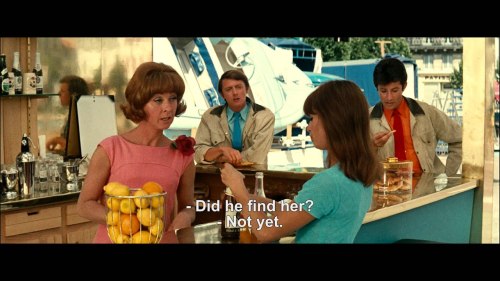

[15] Les Demoiselles de Rochefort / The Young Girls of Rochefort (1967, dir. Jacques Demy)
Demy’s other great musical adds the crucial element of dance—Gene Kelly’s suppleness in particular never ceases to amaze—as seemingly the entire town appears to burst into choreographed movement at the drop of a Legrand song. As such, the canvas is more collective, more focused on the crossings and re-crossings of social relation than the more intimate studies of ‘Les Parapluies’ or ‘Lola’. That every word is sung—the sheer artifice so extended that it becomes a kind of realism in itself (as opposed to the cake decoration sparkles of the musical number)—and that almost every movement feels to be either a dance move, or as if it could be a dance, is these films’ great gambit and the source of their great charm. Demy both takes the potential of the big Hollywood choreographed spectacle—read as a kind of series of miniature epics, short films in themselves, around which the ruins of narrative convention attempt to build bridges—and runs with it. At the same time, this is a film virtually obsessed with the simple pleasures of narrative manipulation—one character enters as another leaves, long-lost children or lovers, mistaken identity, people leaving or arriving in time—as the source of a kind of endless, bittersweet frisson. So of course the final number is undercut even as it (almost) ties together most of the narrative threads, and the jovial café customer is actually a brutal murderer acting out of jealous rage. Romantic love’s not just Catherine Deneuve in the rain.

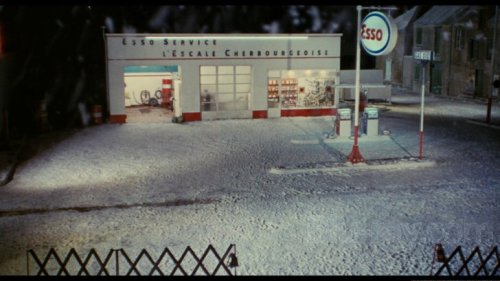
[14] Les Parapluies de Cherbourg / The Umbrellas of Cherbourg (1964, dir. Jacques Demy)
Demy’s musicals are spaces of fantasy, identification, sentimentality, to be sure. Yet they also attain their unique flavour through a kind of realism. For Demy, escapism is not always the creation of an entirely alternative space, a willed blinding to a reality, but a transformation, in the brightest of colours against the richly drabbest of backdrops, and the most soaring of songs, that returns that reality, both as it should and should not be. What’s easy to overlook about this charmed and each time tear-jerking ode to first love and missed opportunity is that, for all its undeniable surface sentimentality, is how non-judgmental and unsentimental aspects of it are. In particular, though this is far less obvious than in a film like Resnais’ ‘Muriel’ from the same period, it’s in large part a film about the Algerian War and the destruction of a generation in the vain thrashings of empire, the bourgeoisification of social climbing and its interleavings with romance: its lovers ending the film as small businessman, a garage owner, selling American oil (the surely intention pun of ’L’Espace Cherbourgeoisie’ above), and the coiffured wife of a bourgeois barely pausing to get out of the car. That’s what you hear when Legrand’s second, or is it third, hanky moment occurs as Deneuve is left behind on the station platform—‘I will wait for you’; and again when the camera tracks out from the garage in that devastating final scene. No one’s waiting here; no one can, for to moulder in dreams would be worse than to nourish them in the sustaining space of fantasy. For all his attachment to the sorrows and joys of romantic love (though even those are bittersweet), Demy doesn’t present it as a kind of goldfish bowl of redemption or aspiration, but as a deep part of the contradictions deep within the social fabric of an unjust society. It’s this, as well as the deeply manipulative, but no less affecting presentation of romance, that make ‘Les Parapluies’ such a great film.
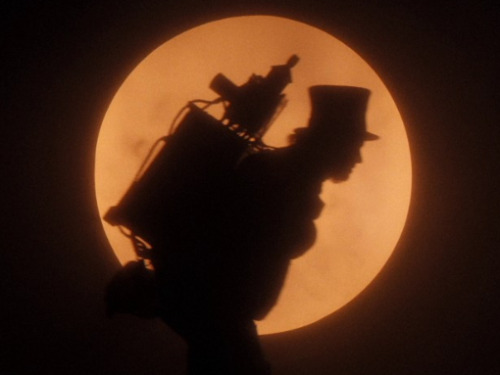
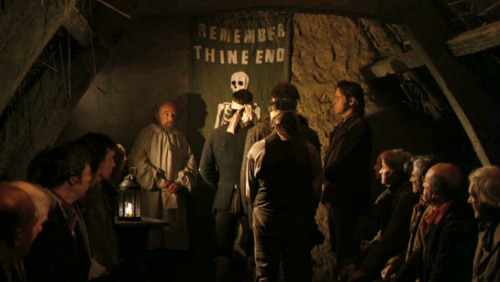
[13] Comrades (1986, dir. Bill Douglas)
Douglas’ epic retelling the tribulations of the Tolpuddle Martyrs scrupulously strives for historical fidelity–in costume, location, mood–but frames the whole through a mode of fantasy whimsical, beguiling and perplexing all at once. Sprawling is the word: the three hours feel like three hours, in part because the austere, morally fervent, yet at times even playful mood of the film’s first half, set in Tolpuddle itself, is succeeded by the more melodramatic atmosphere once the deported trade unionists arrive in the Australia convict colonies. This really does feel like two films in one–or a TV mini-series–and that can take away from the deft touch at display in some of the film’s best moments, which avoid the pitfalls of the worthily stodgy costume drama. Nonetheless, if the link between the pre-cinematic devices involved in illusionism, the magic lantern show, the modern filmmaker, and the histories and legacies of British political organising is not always or at first clear, it ultimately turns out to be the film’s most memorable conceit, enabling Douglas to place his own craft as a form of labour–film-maker as travelling artist, in the line of troubadours, theatre troupes, illusionists–and of the imagination as repository for the dreams of justice that are as much at the heart of struggle as are the sober mechanics of organising, of dogged graft and practicality.

[12] Les Unwanted de Europa (2018, dir.Fabrizio Ferraro)
“Blanqui! I’m listening. I hear you”. A ‘Slow Cinema’ depiction of Walter Benjamin’s final trek over the Pyrenees to escape occupied France, intercut with Spanish resistance fighters taking the reverse route some months later. On the, the soundtrack of birdsong, the tramp of footsteps, the occasional wheeze of French horns from a late John Cage number piece; visually, the decorously austere black and white you’d expect from the field, a whispered discussion of Nietzsche with a librarian in the Bibliotheque Nationale and occasional lines of dialogue the only other hints at the situation of war, fascism and personal mortality, ‘contextual’ knowledge of which shapes our entire viewing. This is, perhaps, a method which can be transplanted to virtually any scenario, if you strip the narrative down enough—the Three Wise Men of Albert Serra’s ‘El Cant dels Ocells’ come to mind—as a means of emphasizing (say) existential smallness, contrasts of scale, melancholia, futility and desperation. But it’s pulled off with enough aplomb for it to work, avoiding any trace of sensationalism even as it also leaves the political stakes largely unspoken.
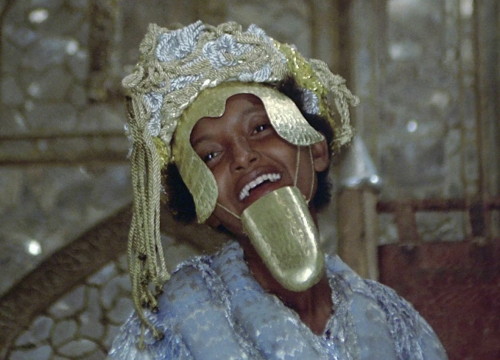
[11] Arabian Nights / (1974, dir. Pier Paolo Pasolini)
Wagers, bets, prophecies, performances, switchings of gender and social roles: in this world, slaves can become kings, the opposite of the hierarchies and libidinal energies of power explored in Salo, a last burst of optimism before that film’s blazing cloud. As in Canterbury Tales, Pasolini essentially dispenses with the storytelling framework central to the original text in favour of the telling itself–an endless series of yarns, fantasies, ironic commentaries, the joy of invention, with an underrated Morricone soundtrack of great beauty.
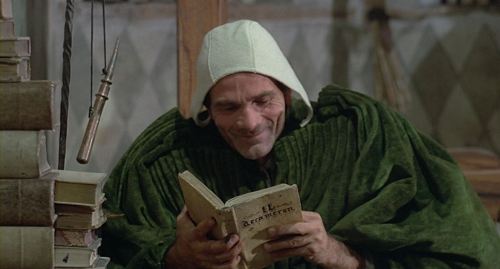
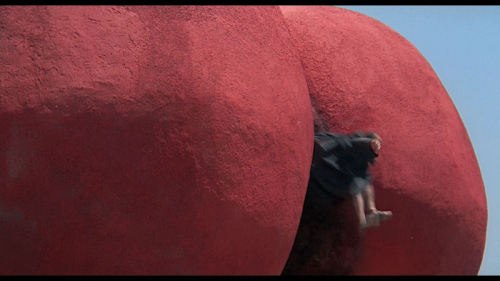
[10] Canterbury Tales / Il Raconte di Canterbury (1972, dir. Pier Paolo Pasolini)
The joy of vernacular story-telling as a counter to the grand narratives of power, with the fixed route of pilgrimage largely replaced by a kind of freewheeling narrative universe full of play between anarchy and the following of rules. Two immortal images: Pasolini, as Chaucer, laughing so hard at Boccaccio (and subsequently, at this own work) that he falls off his stool; the sudden ending on friars expelled from the Satanic posterior. Cosmic justice prevails in the perfect timing of a gigantic fart.
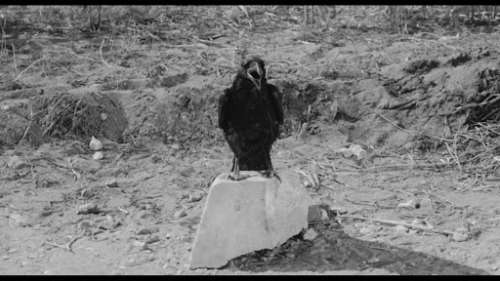
[9] Hawks and Sparrows / Uccellacci e uccellini (1966, dir. Pier Paolo Pasolini)
The shift from neo-neo-realism to allegory: the same bleached landscapes, but with a historical overlay and a bitingly ironised figuration of contemporary political debate. Toto and Ninetto’s father and son are figures straight out of cinema which, as well as fantasies of bourgeois glamour, had created archetypal representations of class identity, survival, ingenuity and humour, from Chaplin to Toto himself–the modern-day equivalent of the Franciscan monks (again played by Toto and Ninetto) attempting to learn the language of birds so that they can evangelise to the natural world in the historical segment. Yet both comics and monks seem unproductively adrift in a world of material lack and complex, yet disconnected discourse. Ultimately, the pontificating Marxist crow is eaten out of sheer hunger, and out of frustration at the boredom of his speeches: a biting comic twist on the over-eating of La Ricotta and the cannibalism to follow in Porcile. Odd, perhaps, that this was reportedly Pasolini’s favourite of his own films–it seems more like a bridging point than a fully-realised work–but of no little fascination nonetheless.

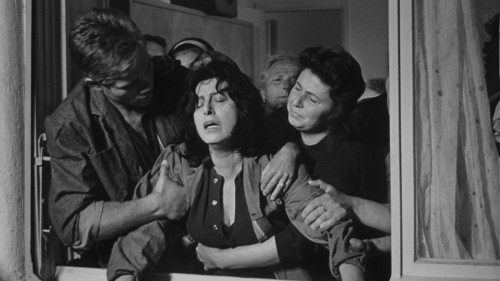
[8] Mamma Roma (1962, dir. Pier Paolo Pasolini)
Exuberance and despair at the beginning and end of the film–though to posit this as a simple bifurcation between the two would be to simplify things. In between, the bleached black and white of claustrophobically open wastelands, the vagaries of sub-proletarian routine in which labour and the struggle to reproduce oneself take the form of betrayal, abandonment, cynicism and failure as often as tenderness or familial love. And in the midst of all this–a cast dominated by non-professional actors, location shooting, a refusal to sugar-coat, editorialise, or render into transparent allegory–Ettore’s death in an Italian prison is filmed with the stark clarity of a fable.
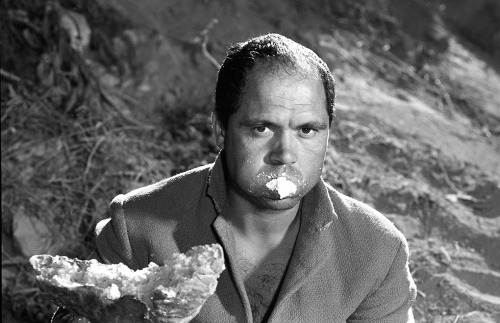
[7] La Ricotta (1963, dir. Pier Paolo Pasolini–part of the compilation film Ro.Go.Pa.G., with Jean-Luc Godard, Ugo Gregoretti and Roberto Rossellini.)
Hunger, martyrdom and the aesthetics of representation in a film within a film. The director (Orson Welles) is a contemptuous bourgeois; the actors (among them Laura Betti) bourgeois hedonists or sub-proletarian extras blind to their own exploitation; the media (the journalist who interviews Welles) subservient, sensationalist, propagating conformist blandness; the rich guests who tour the set consuming the spectacle of what turns out to be literal death; the sub-proletarian extra Stracci (’Rags’) sacrificial fodder, first starving, then consuming an entire ricotta on an empty stomach and being hiked up to the Cross in his role as the Good Thief during the Crucifixion. Pre-dating The Gospel According to Matthew, this has more in common with films of excess such as La Grande Bouffe, ten years later, crossed with Rocha’s Aesthetics of Hunger. A pitch-perfect fable.

[6] Pasolini (2014, dir. Abel Ferrara).
Concentrating on Pasolini’s final days at once risks the sensationalistic media coverage that in some senses overshadowed Pasolini’s actual career: a teleological endpoint, the wages of sin, for the conservative critics, a moment of martyrdom of others. To take just one example, Barth David Schwartz’s exhaustive biography, ‘Pasolini Requiem’ opens with a good hundred pages to reconstructing the crime, along with passages of quasi-philosophical purple prose on the nature of being. Ferrara’s film avoids such pitfalls: he’s not much concerned with factual enactment, though the film draws on the available interviews and witness accounts, and Dafoe is certainly a dead-ringer for Pasolini. Thus, a good deal of the film’s run time includes dramatised passages from Pasolini’s unfinished novel ‘Petrolio’ (the field of a hundred blow jobs) and proposed film project ‘Porno-Teo-Kolossal’ (for which Ferrara recruits Pasolini’s own Ninetto, exuding a Chaplinesque charm). At the same time, the lack of factual detail–while a clear choice–can risk eliding the political stakes of Pasolini’s positions on fascism, the sub-proletariat, and his heterodoxy within the left. Perhaps the most jarring aesthetic element, the language-issue–dialogue spoken in American-accented English, Italian-accented English, American-accented Italian, and so on–is thus either synecdoche for the confused nature of the film or an illustration of critical distancing and sober meditation on a sensationalised icon of cinema and the European aesthetic left: depends on your perspective.
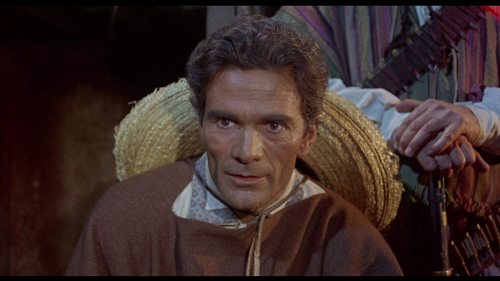
[5] Requiescant / Kill and Pray (1967, dir. Carlo Lizzani)
Pictured, Pier Paolo Pasolini himself in a rare acting cameo as the Mexican priest, a kind of liberation theology advocate who drifts in and out of the narrative at key points. The titular hero, played by Lou Castel, is the sole survivor of a local landowner’s massacre of the peasants in the ruined chapel which serves as the film’s opening and climactic acts of violence: the massacre and the act of liberation which avenges it. That structure, of a suppressed violence which the hero (and audience) slowly come to understand, in an inevitable journey of violence begetting violence, is familiar from Leone, from ‘Django’, from numerous other Euro-westerns of the periods. Here, though, as usual, it’s framed through the figure of the lone gunfighter, it’s given a greater collective dimension. Requiescant, adopted by a religious family (hence his habit of saying a prayer over those he’s killed), seeks to rescue his adopted sister from the clutches of the landowner who runs the town as a connected network of vice, of semi-legitimated criminality based on exploitation and dispossession. His act of violence against the landowner and his henchmen simultaneously serves his own personal quest for revenge and the interests of the peasants led by Pasolini (which the flashback structure reveals to be connected). As in Glauber Rocha’s later ‘Antonio das Mortes’, Lizzani suggests that the individualist gunslinger, whose skill and firepower are need in the struggle–and who remains a figure of cinematic lore and popular fantasy more than a historical figure–is also ultimately subsidiary to the force of the collective.
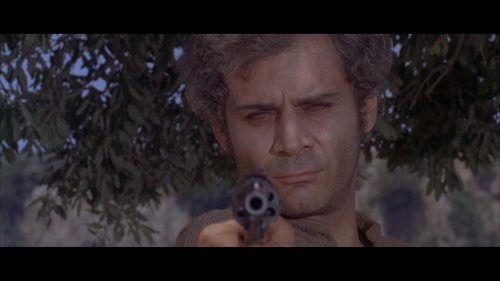
[4] Face to Face / Faccia a Faccia (1967, dir. Sergio Sollima).
Gian Maria Volonte as the history professor whose timidity and physical ill-health turns, through his encounter with Tomas Milian’s outlaw, into a fantasy of redemptive masculine violence and power that becomes ever more sadistic and irrational as he assumes a greater leadership position amongst a community of outsiders. If the ‘Zapata westerns’ appeared to enact fantasies of Third Worldism through a sometimes confused melange of Fanonism, Guevarism and the (inverted) tropes of the Hollywood western, Sollima’s film seems to suggest a class critique of that very framing: Volonte as the bourgeois intellectual whose eventual avocation of a fantasized violence become real merely replicates the violence of the class whose trappings he ostensibly rejects. That’s to say: Fascism.

[3] Death in Venice / Morte a Venezia (1971, dir. Luchino Visconti).
Perhaps an obvious film for a time of plague. Excess of a different kind to that of ‘Pink Flamingos’: an excess of framing/filming–all that Mahler! all those wordless panning, tracking, zooming, wordless shots of the city!–in a drama about restraint, suppression, and the inability to act on warning signs (the onset of plague; the demise of the bourgeoisie; the exploitative violence of the artist’s desire). In other words, both a film-fantasy and a film about fantasy, that seems at once to revel in and condemn its allegorical frame: to point up allegory, even as it dissolves it in a world of sensation and the myth of ‘purity’.
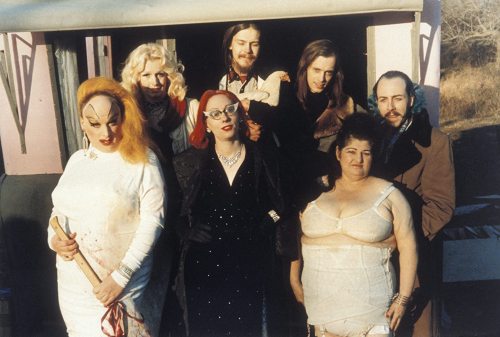
[2] Pink Flamingos (1972, dir. John Waters).
Another kind of ‘family unit’, with some affinities to the class-based split repeated via the outlines of the horror film in ‘Us’. Here, it’s the suburban house and the straight couple (with its underbelly or torture and violence in the cellar) vs the queer community of the trailer, which suburbia must eventually literally destroy. Of course, that’s too schematic a summary: these are the ‘filthiest people alive’, and their aesthetics, activities and interactions must exceed all summary.
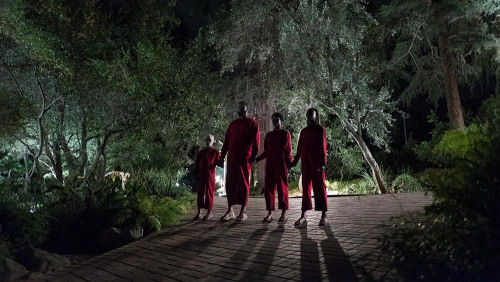
[1] ‘Us’ (2019, dir. Jordan Peele)
The nightmare mirror to the bourgeois family, emerging via subway elevator and fairground corridor, conducting a totentanz for which the key text might well be the video for Michael Jackson’s ‘Bad’.


No comments:
Post a Comment